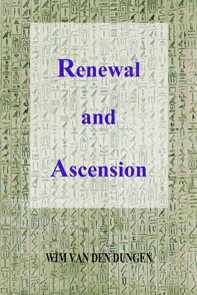The Book of :
The Hidden Chamber
ca. 1426 BCE
or :
the Twelve Hours of the
Night
and
the Midnight Mystery
Section 1
History of the Midnight Mystery
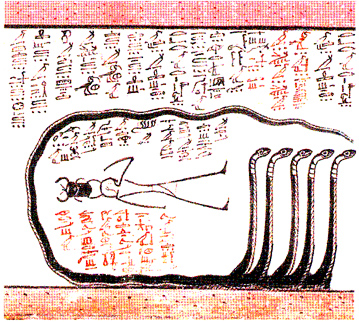
Book of the Hidden Chamber - Sixth
Hour
The five-headed serpent "Tail-in-Mouth" :
"the mysterious image of the Duat, unknown and unseen"
Tomb of Pharaoh Tuthmosis III (ca.1479 - 1426 BCE)
by Wim van den
Dungen
Section 2
Pataphysics of Creation
Section 3
The Summary of the Amduat
The Twelve Hours : A Commentary
Introduction :
Ars Obscura and
sacred timelessness
1
Ancient Egyptian Royal Funerary Ideas.
-
1.1
From Early Dynastic tombs to the Pyramid Texts.
1.1.1 Predynastic graves & mounds.
1.1.2 The advent of the dual kingship.
1.1.3 The royal tombs.
1.1.4 Osiris & the stellar function
of the pyramid.
1.1.5 Major changes : the religion of Re.
1.1.6 Major changes : the titulary.
1.1.7 The pyramid of Unis and the Pyramid
Texts.
-
1.2
Funerary logic of the tomb of Unis.
1.2.1 Spatial semantics.
1.2.2 Reading a tomb ?
1.2.3 Pharaoh's great speech.
1.2.4 The Egyptian psyche
and funerary
rituals.
-
1.3
The Coffin Texts & the Book of the Dead.
1.3.1 Political &
economical players.
1.3.2 A radical change of
perspective.
1.3.3
The "democratization" of the hereafter.
1.3.4 The Coffin Texts.
1.3.5 The Book of the
Two Ways.
1.3.6 The Book of the
Dead.
-
1.4 The royal
New Kingdom Books of the Netherworld.
1.4.1 The archetypal
forms of renewal.
1.4.2 A new royal
prerogative.
1.4.3 The New Solar
Theology.
-
1.5 The
Pharaohs of the Book of the Hidden Chamber.
1.5.1 The textual
basis.
1.5.2 The Midnight
Pharaohs.
2
The Midnight Mystery or Ars Obscura ...
Introduction
Ars Obscura
and sacred timelessness ...
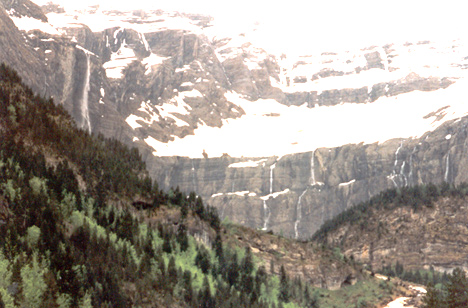
Cirque de
Gavarnie - Pyrenees
►
Palaeolithic cave mysteries
Why did prehistoric humanity, bewildered by pristine natural
environments, at once
terrible and fascinating, put in the effort to paint the shapes of real and
fabulous animals in deep, dark
underground caves (cf. the Palaeolithic caves
in France) or
carve mysterious images on remote, shaded rocks
(cf. the Neolithic petroglyps of the Eastern Desert of Upper Egypt)
?
The Palaeolithic Age comprises a huge time interval. The
Lower Palaeolithic Age (Old Stone Age, ca.
1.5 million - 100.000 BCE) begins with the appearance of
the first stone tools. At first, these are simple implements, like flaked
cobbles (found in Africa). The latter are associated with fossils of the oldest
human species known, Homo habilis, a predecessor of Homo erectus,
the first hominid to enter the Eurasian continent. Stone tools dated to more
than 1.5 million years ago are on record in Portugal. During
this epoch, cold and warm climatic conditions alternated.
The Middle Palaeolithic, Mesolithic or Middle Stone Age (ca. 100.000 - 40.000
BCE) is defined by its flake tools. Their production frequently involved
extracting blanks from raw-material cobbles. This technique made it possible to
obtain flakes with pre-determined shapes (ovoid, triangular or rectangular),
retouched into tools. The Homo sapiens Neanderthalensis is associated
with this period.
In the Upper Palaeolithic (ca. 40.000 - 10.000 BCE), a whole range of novelties
appear : projectile points made from materials like bone, ivory or deer antler,
the use of personal adornments (animal teeth and shells pierced to be used as
pendants), art and its mythical symbolism. These evidence a cognitive jump, a
crucial advance in problem-solving capacities and symbolization (the association
of a set of phenomena to a fixed glyph). Important social changes are on record.
We witness the formation of society. Primitive communities appear and try to
adapt to the hard life during glaciation.
Their new cognitive symbolizations of nature (albeit mythical and archaic),
stimulate the belief in "higher" powers, the spirit-world and the afterlife.
This is the era of the cave mysteries : the secret of life and death symbolized
as the mythical pattern of the vanishing, mystification and reappearance of
light. The mystery play of the cave as a way to touch the higher powers of
nature and harvest their blessings.
The "human" brain is able to compute the
spiritual
potential of consciousness since the time of Homo sapiens
Neanderthalensis
(ca. 500.000 - 29.000 BCE). The neuronal wiring needed to do so was
probably absent in Homo erectus (ca. 1.6 million - 27.000 BCE),
especially in the Lower Palaeolithic.
The "fourth" state next to waking, dreaming and the dreamless sleep,
lies outside the cycles of
"nominal" spacetime and involves
the emancipation of the brain (cf. "turîya"- the "fourth" in
Hinduism). This consciousness escapes
the tragi-comic, quaternio of elemental conditions of the natural order.
The freedom gained by measuring with additional dimensions, entails cultural forms interacting with and transforming nature.
-
Australopithecus
: 450 - 520 cc, who roughly had our teeth and feet ;
-
Homo habilis :
600 - 800 cc, who made simple stone tools ;
-
Homo erectus :
900 - 1000 cc, larger brain and a skeleton like our own ;
-
Homo
Neanderthalensis : 1.033 - 1.681 cc, larger
But frontal
lobes less complex ;
-
Homo sapiens
sapiens : 1.600 - 1.681 cc, large brain,
developed frontal lobe.
A complex
neurological circuit is necessary to compute and process
spiritual experiences. An upgraded version of the neuronal equipment to do
this was at
work in the Cro-Magnon brain, namely the ability to symbolize these
experiences (cf. angular gyrus). But at first, the original software had been
uploaded in the
cortical hardware of the Neanderthals (cf. the right amygdala, the "God"-spot in the brain).
Although scholars still debate whether the latter had religious sense from
the start (ca. 500.000 BCE), it is clear the late Neanderthals performed
funerary rituals (awareness of mortality presupposing immortality and vice
versa).
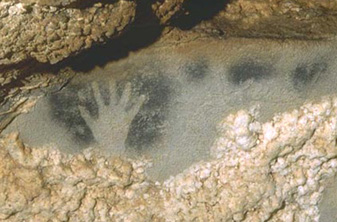
Pech Merle - ca.
16000 BCE
Before reaching the gigantic underground
rock cathedral within the holy mound, the Cro-Magnon, or Homo sapiens sapiens
(from 100.000 till ca. 10.000 BCE), crawls a considerable distance through a twisting, narrrowing, pitch black tunnel underneath tones of
solid rock. The heart of the mountain is one or several caves lit with
fires, with a variety of known, unknown and
phantastic animals painted on high walls and maybe animated by
the resounding echoes of the fierce rhythms of beated stalactites ... Are
strange
men running around in unseen outfits, shouting, dancing or otherwise
occupied ? The Dancing Sorcerer of Trois Frères perhaps, directing, in
this grand natural galleries within the sacred mound, the secret dance of
the powers that be, i.e. the supernatural spirits of the ancestors
and the deities. Why do these Palaeolithic ritualists seek the same
darkness of deep, dreamless sleep and death as the stage for their
activities ?
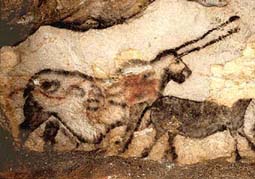

Lascaux - the
Great Hall of the Bulls
The underlying purpose of this drama of darkness is religious and magical. The former reconnects
the archaic, mythical layer of consciousness, predominant in Upper
Palaeolithic and Neolithic humanity, with
the primordial, archetypal powers or differentials of nature, the types
representing the Nature of the natural order. The latter
protects
against the dark, dangerous side of the natural order, and aims at
its successful manipulation by means of the Nature of natures.
Prehistoric consciousness projects this outwards, and
perceives it as the living, animated existence of ceaseless repetitions
and constant types. The latter are only "typical coordinations" within its
psychomorphy perceptions of the natural environment, particularly the
"psychophysics" of water (food) and light (darkness). Over time, mythical
notions of these psychomorph experiences take form. These eventually
become natural "stereotypes", the gods and goddesses of archaic
polytheism. These deities represent the unchanging in the constantly
changing, the stability of change in the life of wanderers and farmers
alike.
Upper Palaeolithic humanity had no local
horizon. Unable to plot the natural cycle of the Sun, this slowly emerging
intelligent consciousness has only the Moon to rely on, for only this swift Light
presents its ever-changing face always the same to the
entire Earth, no matter where one wanders. The horns of the consort of
this great goddess, the "Great Moon Bull", are the two crescents of the
Moon. Fertility, sexuality and the mystery of the uterus rule supreme. The great
fertility goddess and her consort remain crucial and dominant archetypal representations
until the end of the Neolithic. But as soon as village life commences, a local
horizon is established, and the annual cycle of the Sun paired with the
Lunar month.
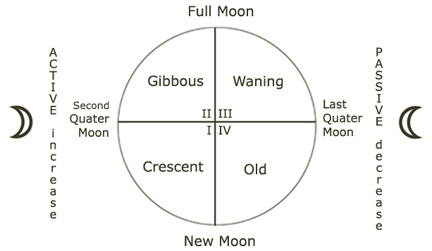
the Lunar
Phases : astronomical
The Moon was and is used to measure time. The unchanging Lunar phases were
charted on deer antlers and tigh-bones because of the vital information
they represent. A purely nomadic lifestyle obscures the daily and annual
cycles of the Sun (apparent and seasonal). So the nearest fixed point of
orientation is the everchanging face of the Moon. The Lunar cycle of 29.5
days starts when the Moon is "invisible", standing between the Earth and
the Sun, on the Sun side of the Earth (i.e. New Moon or Sun - Moon = 0°).
During the period of increased light that follows (its face forming a
"p"), the Half Moon midpoint is reached at the end of the First Quater
(Sun - Moon = 90°). Before this First Quater Moon, the Moon is crescent,
after it, her movement is gibbous (approaching Full Moon) or waxing. A
Full Moon rises in the East at about the same time as the Sun sets in the
West. After the Full Moon, the face of the satellite forms a "d". The
Waning Moon. After the Last Quater Moon, the Old Moon is visible. These
fixed temporal intervals of the Lunar cycle, and their corelative dual
phenomenology of light versus darkness, were symbolized in myths. This
stable calendar of the wanderers assured fertility, but offered no
seasonal plan.
Are there, besides the mystical quest for the radical altered state
of consciousness, other religious and magical purposes
for entering the Palaeolithic "cave of darkness"
? In order to steer his environment and himself, the wanderer,
caught in the Lunar cycle of light and darkness, of
plenty and want, seeks, in a mythical mode of cognition and by sympathetic imitation
(by magical mirroring), to unite with the projected "types" of nature. The mountain is
the ultimate natural type, representing stability,
strength and the will of the deities. Likewise, the heart of the mountain
is its secret, and
becomes the sanctum or sacred uterus of the great goddess. This
holy space protects and
feeds spiritual growth.
Three stages characterize the Upper Palaeolithic cave mysteries :
-
"the entry" : the tunnel :
the process of differentiation from light to darkness ;
-
"the sanctum" : the
cathedral : the secluded place of the mystery of the hidden light
;
-
"the exit" :
the return : the process of integration from darkness to light.
Light and darkness are the
physical underpinning of the cave mysteries.
The cave
is a protected mediating area were the human and the archetypes
of nature touch. Its heart is an uterus, a place of new birth. The tunnel is a crawl or passage-way between stages
& stations of life and the otherworld (the beforelife and the
afterlife), the path of the seed to the ovary. In the natural darkness of the sanctum, events
such as the death of a hunter could be relived and the causes combatted in
a symbolical, allegorical way. Initiations could happen. The womb was the
temple of the great goddess, she who enfolds nature as a whole.
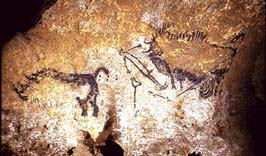
Lascaux -
the Shaft of the Dead Man
The Cro-Magnon were the
first to use grand rock cathedrals and their difficult entrances to invoke
the experience of
symbolical death and the subsequent
initiation into a new, more powerful, rejuvenated state of consciousness, enabling
one to move to a higher, stronger mode of being and awareness of being.
Perhaps a better hunter, healer and leader of others. These superior hominids were able
to artistically symbolize their religious and magical experiences, and
thus shape spiritual traditions and eventually develop
notions like heaven, hell, god and goddess, as well as
shamanism (the conscious control of trance) and later priesthood (the
specialization of magico-religious activities in more centralized
village societies). Their common experiences shaped the earliest myths.
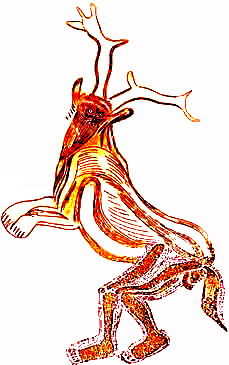
Les Trois
Frères - Dancing Sorcerer - ca.10.000 BCE.
This 30-inch tall figure of a
shaman is carved into a ceiling chamber of Trois Frères, a Palaeolithic
hunter's initiation cave in southern France (Pyrenees). His is an image of
sympathetic magic, with the ears and horns of a stag, the eyes and beak of
an owl, the bearded face of an old man, the tail of a wolf, the paws of a
bear and the legs of a dancing shaman. Near him are painted hunting
murals. The assumption of these animal forms allowed the shaman to enter
his trance and "understand" the animals in a symbolical way. He could
transfer this "knowledge" or commune with these powers and serve his
group, reducing fear and opening up the barrier between the natural and
its Nature, the feminine powers of
the "Great Mother" and the steady run of the energy of her "Bull", the
Moon.
► Egypt in prehistory
"All the data at our
disposal suggest that the process of Nilotic adaptation favoured partial
sedentism and encouraged food storage. It was therefore part of the
beginning of a long evolutionary process through which the people of the
Nile valley embarked on the Neolithic period."
Midant-Reynes, 2000, p.59.
On the basis of the evidence to date, the majority of scholars subdivide Egypt's unwritten history (ca.
5000 - 3000 BCE) in three major phases :
-
the
pre-Neolithic Period (ca. 7000 and earlier) : early settlers in the
Nile Valley and in the western desert contributing to the historic
Egyptian reality - the "process of Neolithicization" (Midant-Reynes,
2002) ;
-
the
Neolithic Period (ca. 5000 - 4000 BCE) :
the first traces of village settlement on the banks of the Nile. The crucial myths
of these Nilotic cultures are dominated by Lunar ideational features.
However, because of the fixed horizon, awareness of the Solar cycle, and
the seasonal changes brought about by it, rose ;
-
the
Predynastic Period (ca. 4000 BCE - 3000 BCE) : incipient
stages of the centralization of power go hand in hand with the
"Solarization" of the old Lunar myths. This new, fixed reference point,
allows psychomorph projections of stability, authority and continuity. The
enduring order of the sedentary farmer is guaranteed by sacred kingship,
and the latter is engendered by the great goddess herself. The period comes to a close when the male
king assimilates the sacred power of the great goddess and initiates Solar
ideation.
Upper Palaeolithic rock art and its magico-religious sense reflect
the spirituality of the free wanderers, the gatherer-hunters who roam
a large territory, identifying (sanctifying) important landmarks, such as
mountains and rivers (during the day), as well as the phases of the Moon (at
night). These sacred waymarks represent the great goddess and her consort.
She is the spacetime continuum embedding the powerful, ongoing drive of
the lifeforce of her consort, the Bull, at maximum strength when the Moon
is Full (Sun - Moon = 180°, with a brightness of magnitude -12.7).
"But while the true tendency
of scientific, analytical-critical thinking is toward liberation from this
substantial approach, it is characteristic of myth that despite all the
'spirituality' of its objects and contents, its 'logic' -the form of its
contents- clings to bodies."
Cassirer, E. : The
Philosophy of Symbolic Forms, Yale University Press - Yale, 1955,
vol.2., p.59.
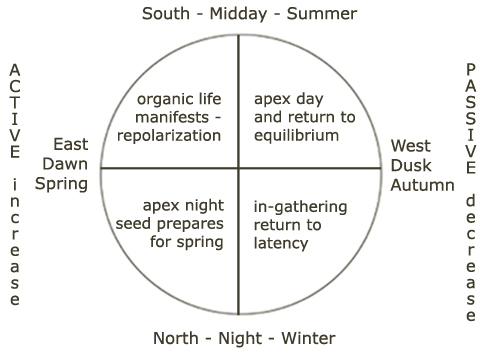
the Solar
cycle : seasonal
and daily magico-religious sense
When the Neolithic dawned, this picture could be slowly completed. Farmers
work out
change within a local horizon, and so identify the overarching,
all-encompassing natural, primordial
type of life : the annual cycle of the Sun. The changes marked by this
cycle are seasonal and horizon-related relationships between the Earth and
the stars. The horizon of the nomad travels beside him unfixed, with no
reference to a stable element of the environment. Wherever he stops, there
the Sun sets, and the moving celestial vault remains un-measurable. The
synodic movement is detected, the sidereal remains unknown. Neolithic semi-nomads
and farmers experienced the annual cycle of events in a fixed number of
places. Small changes could be observed and logged. Finding an efficient
balance between both approaches (the dominant Lunar and the emerging
Solar) preoccupied humanity during the Neolithic as a whole.
The study of Predynastic Egypt
started with
Petrie in 1895 (sequence dating by ordering ceramics with respect to
decoration & manifacture at the sites at Naqada, Abydos and Hu). In 1923,
the Badarian culture was discovered (cf. Badari in Upper Egypt). The first
major synthesis was by
Kantor in 1944 and 1952. In 1960,
Butlzer initiated the study of Nile floods and other elements of the
palaeo-environmental record of Egypt. Through the 1970s and into the
1980s, studies by
Hassan focused on enviromental reconstruction, subsistence, settlement
& demographic investigations. He also investigated the cognitive schema of
Predynastic peoples through their rock art and the mythogenesis of the
early Egyptian state. A general synthesis was formulated by
Midant-Reynes (1992).
"The broad scope of Egyptian
religion grew out of the most ancient surviving roots of our world and
time. They were among the few surving inheritors of humanity's oldest
religious philosophies, and represent a continuity of thought and
religious training that goes back to the days of the great cathedrals of
cave art. The earliest images of their philosophy are more intensely
sky-related, demonstrating the widespread geography which was the natural
environment out of which the images grew. These images are the iconography
of the Divine evolved by the nomadic plains peoples of Neolithic Africa."
Wheeler,
2002, p.20.
The earliest examples of stone monuments are found at Nabta, a site in the
western desert dating ca. 7000 BCE. There is evidence that these
inhabitants aligned their stone constructions to the cardinal points and
to the solstice (the equinox points of the Sun). Near these "calendar
circles" as they have been called, burials of cattle have been found. The
first pottery-making in Egypt is also very old, dating to the ninth
millennium ! At Tushka, North of Abu Simbel, two humans were found buried,
their graves surmounted by the bucrania of wild bulls (Wendorf
& Schild, 1980). These elements indicate that these communities were
already
"... moving towards an ordered social structure,
perhaps with some form of hierarchy and evidently with individuals who
practiced special occupations and others who directed the communal efforts
in respect of them. It might be said that the whole fabric of later
historical Egypt might be seen by the evidence from these remote
settlements."
Rice, 2003, p.23.
The following chronology of Egyptian prehistory prevails :
-
Neolithic period : the interval between the emergence of farming
villages on the banks of the Nile and the initiation of the Egyptian
nation-state. The earliest evidence of Neolithic village communities in the Nile
Valley dates between 5000 and 4100 BCE (cf. Merimda Beni Salama). These
communities were not more at best than a few hundred. They settled on little
hillocks or raised land, most likely to avoid the flood.
The
Badarians (cf. el-Badari, Upper Egypt on the East bank) were a farming and herding
community. These settlers raised cattle, sheep, goats and pigs. They
cultivated barley and wheat and agriculture was supplemented by fishing and
fowling. Pottery, glass, copper and glazed staetite were found at some
sites. The walls of early Badarian vessels are fired to a hardness which
approaches that of metal although often eggshell-thin. Exceptional
crafsmanship already present.
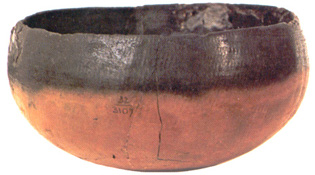
fine Badarian black-topped
red ware
Badarian culture - ca. 4200 BCE - Metropolitan
The
Badarians provided their dead with food and placed female figurines in the
graves. They had established religious cults, in which the great goddess
placed an important role. Social status
evidences in funerary cults. Religious activity around female deities such
as Hathor. Graven images found in tombs, head of deceased pointing South, looking
West ;
-
Middle Predynastic period (ca. 4000 - 3600 BCE) : with
Amratian culture (cf. site of el-Amra, Sohag - Naqada I) agriculture
inceased, hunting deceased and a marked technological change took place.
However, their culture may be seen as an advanced phase of the Badarian.
Pottery, mostly in red fabric scored with designs and filled with a white
finish, not yet diffused from Mesopotamia was created with geometrical and
naturalistic designs, yet unstructured in layout. Draughtmanship appeared.
Decorated textiles in vivid naturalistic style.
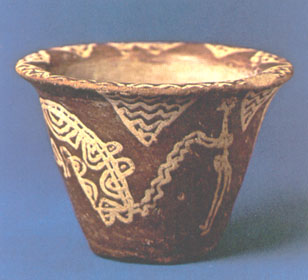
painted bowl of a man
harpooning a hippopotamus
Amratian culture - ca. 3800 BCE - Metropolitan
Concentration and
centralization of power in its incipient stages with the formation of a
managerial class. Transportation of goods along the Nile ;
-
Late
Predynastic period (ca. 3600 - 3300 BCE) : in
Gerzean culture (cf. site of el-Gerza, Fayum - Naqada II),
fundamantal changes, techniques were improved. Contacts with Mesopotamia.
Cult centers and urban centers emerged, associated with chiefdoms,
principalities, provincial states and village corporations united into
regional kingdoms. Trade continued to flourish and wealth distinctions
became more salient. Whole burial treasures. Cow goddess Hathor is still revered.
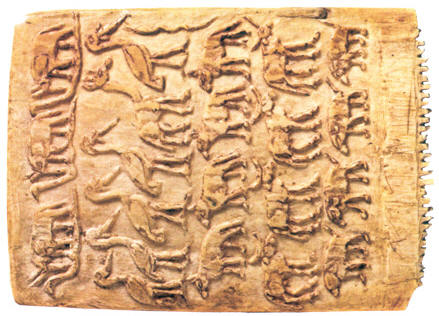
decorated ivory comb
Gerzean culture - ca. 3500 BCE - Metropolitan
"In fact, the
Naqada II or Gerzean phase presents a natural succession from its immediate
predecessor, with the important difference that it was responsive to a much
more powerful and, it would appear, more sustained alien influence then
either of those which it followed."
Rice, 2003, p.23.
The influence of Mesopotamia on this crucial
and sensitive phase is unmistaken, but did not change the Egyptian way of
life, already very much in evidence. The differences between the
cultural form of both cultures (political and religious) existed already for
some time now and it is fair to assume the foreign influence only helped the
native Egyptian cultural form to become historical. The role of Sumerian
city-building and writing on Gerzean culture prevails in technology, scope
and vision, but the Egyptians readapted and found ways of their own.
"Considered in another way, the Naqada II phase is an
intermission (though an intensely creative one) between the late Neolithic
stages of the Valley society's development and the coming of the great
dynasts who were to unite the Two Lands into the Dual Kingdom and thus
create the historic Egyptian state."
Rice, 2003, p.35.
-
Terminal Predynastic period (ca. 3300 - 3000 BCE - Naqada III) : The
rise of the Egyptian state was the result of wars and alliances hand in hand
with the rising importance of the archetype of the "great individual", the
male king. At first, he is the consort of the Upper Pelaeolithic and
Neolithic great goddess, but slowly the Predynastic king assimilates her
powers, and
thereby justifies his own male divinity (independent of her -
Hassan,
1992). In the first 250 years of this
phase, fragmentation and reunification occurred (perhaps several times). In Upper Egypt,
the kings of Naqada and Hierakonpolis ruled, and in the Delta, the
petty kingdoms of Buto, Sais, Tell el-Balamoun, etc. divided Lower Egypt. The first major power
emerged when the two southern kingdoms of Hierakonpolis (Nekhen) and
Naqada united because the kings from Hierakonpolis, later known as the
"Followers of Horus", conquered and annexed the kingdom of Naqada (Seth),
and later those of the northern Delta.
A few important Predynastic realizations should be noted. These were
completed before the grand Dynastic Period (ca. 3000 - 30 BCE) started !
-
a spoken language ;
-
administrative organization
of provinces, groups of nomes ;
-
chieftains accumulating
power and prestige and founding the myth of kingship leading to the
unification of Upper Egypt ;
-
commercial and artistic
activities ;
-
the wish to unity the Nile
valley into one state (conquering Middle Egypt and the Delta) ;
-
a traditional notion of the
sacred, which is rooted in the worship of the great goddess ;
-
oral tradition of
mythologies, stories, legends, charms, songs, hymns & funerary rituals
assuring the afterlife of the deceased ;
-
artistic works in clay and
ivory - stone increasingly becoming the preferred material to eternalize the
afterlife ;
-
Gerzean ware design
schemata reveal the lessening importance of the feminine in religion and the
concomittant increase in masculine religious principles ;
-
the first "mnemonic"
symbols and semi-cursive hieroglyphs appear on labels of recipient,
palettes, etc. The first hieratic (the cursive form of hieroglyphic writing)
is
Terminal Predynastic and already then in everyday use (cf. Palette of
Narmer, Dynasty 0, ca. 3050 BCE).
There is no room for doubt : Dynastic Egypt did not emerge "ex nihilo",
but the decisive features of the Egyptian way of life (the own-form of the
cultural form) we have on record are already established a millennium
earlier, whereas the emergence of regional kingship (ca. 3600 BCE) builds
on the managerial approach of the Badarians (ca. 4000 BCE). The great
change at the beginning of history is the theo-political notion of divine
kingship : Two Lands united by the incarnation of a single, re-incarnating
sky-god, descending in a male body, forming a dynasty of divine kings,
ruling a united state of divisions.
"The kings who crafted the Egyptian state from the
competing powers of the Predynastic period succeeded in formulating a
concept of rule which guaranteed an absolutely pivotal role for the
monarchy. The institution of kingship was projected as the sole force
which held the country together, and the dual nature of the monarchy was
expressed in the king's regalia, in his titulary, and in royal rituals and
festivals. This concept -the harmony of opposites, a totality embracing
paired contrasts- chimes so effectively with the Egyptian world-view that
the institution of kingship acquired what has been called 'transcendental
significance' (Frankfort, 1948)."
Wilkinson,
2001, p.185.
The Predynastic kings of Nekhen identified with Horus, "the distant one"
(did he originate in Arabia ?), the overseer with the horizon of horizons.
The kings of the first dynasties (Early Dynastic Period) consolidated this
major change. It also implied the cognitive leap from mythical to
pre-rational organizations, from notions to pre-concepts. Aided by
writing, the cultural form developed rapidly and exteriorized its "canon".
This Old Kingdom canon would dominate Egyptian thought until the end. Qua
contents, this multi-layered texture returned to common Predynastic themes
and another, new layer, was put on the mythical foundation.
► the great Moon goddess of
prehistory
In the Neolithic & Predynastic mind, at work in the mythical
mode of cognition, natural cycles like the Lunar, were very entrenched.
Its phases represented the divine feminine as the truly enduring part of
nature outside man, and psychomorph projections on the Lunar stations were
common. Cycles related to birth, growth, death & rebirth (healing), as
well as plants, domestic animals and hunting were associated with this great goddess of the sacred. In Ancient Egypt, we see her appear
ca. 4000 BCE.

the Lunar
Phases : magico-religious
Her important and enduring role of the sacred feminine is confirmed by the frequent representations of female figures in late
Naqada II iconography. The complex, composite nature of some of the
Predynastic female deities (like Hathor, both Cow- and Sky-goddess) is a
manifestation of the Upper Paleolithic and Neolithic great goddess, who
combined many of the functions later assigned to other deities. The
crucial role of the sacred feminine persisted though, but when history
dawned, the great goddess had lost her dominant position. She did not
disappear. This is demonstrated by the prominent role played by goddesses in the later
pantheon, by the equal status women enjoyed in Early Dynastic
society and by the link between women and the sacred domains of existence
(birth, fertility, creation, death, healing, rebirth).
Indeed, in the Old
Kingdom, the mother of the royal heir was his official consort and on the
Palermo Stone, the name of the divine king was directly followed by that
of his
mother. Women played a crucial role in dynastic changes, and man had his
"heart" from his mother. Neither were the tombs of some of the early queens essentially
different from those of the king. During his life, the latter was
permanently protected by the "Two
Ladies", the goddess Nekhbet -a vulture- and Wadjet -a cobra-,
representing Upper and Lower Egypt respectively. In the tomb of Pepi I
(ca. 2316 - 2284 BCE), we read :
"You are a son of the Great Wild Cow. She conceives
you, she bears you, she puts you within her wing."
Pyramid Texts,
utterance 554 (§ 1370).
So in Egypt, the
unorganized, Lunar religious culture of the Neolithic hunters (5th
millenium and earlier), Predynastic semi-nomads and
settlers (4th millenium) had remained dominant until the end of prehistory (ca. 3000 BCE).
During the Late and Terminal Predynastic Period, i.e. between ca. 3600 and 3000 BCE, the archetypal
representation of male power and kingship steadily became more important
and heralded the
emergence of history.
Indeed, although Neolithic agriculture was the decisive economical factor
responsible for the rise of Egyptian civilization, other,
mytho-ideological elements played
their role. According to
Hassan (1992),
mythogenetic changes were an essential ingredient in the rise of the
theocreatic state
and they were not merely a consequence of economic or political
developments. Indeed, the surplus created assisted the refinement of
culture, both religious and political. The Egyptians proved to foster a
highly intelligent canon of meaningful relationships, and eternalized it
in art, literature, religion, ritual and the persuit of wisdom.
"Ritual and myth provided individuals with a matrix
of sacred meaning in which economic, social, and political developments
were grounded and reinforced. Similarly, economic and political
developments provided a framework for the transformation of ritual and
myth along a co-evolutionary course."
Hassan,
1992, p.307.
For this author, ideation calls for the incomplete assimilation by the
king of the
sacred power of the great goddess and her deities. The control he had over
others was legitimated by sacred myths, linking him with secret natural
forces, in particular those of the great goddess.
With the unification of the country and the start of history, all power
was centralized in the divine king, a "Follower of Horus". The sky-god
Horus, represented by a falcon, incarnated again and again. The king was
his earthly embodiment.
The "Followers of Horus" present the notion of royal ancestor worship
as a legitimization of male power, for all kings were so many incarnations
of the same male sky-god. Each ruler became part of this upon his death.
Long intervals of time (consecutive years) become fixed by filling them up
with mythical images, names and sacred events. This forms the apex of the
Neolithic approach of the Solar cycle : mark the past with the
symbols of the present, and oversee annual intervals along a fixed but
local horizon. Palaeolithic nomads never keep records and have no surplus.
Each is his own horizon (cf. solipsism). Predynastic Egyptians were aware
of two and more local horizons at the same time (cf. Upper and Lower Egypt
plus the nomes), and succeed in uniting the Two Lands. At the start of the
Dynastic Period, the "objective" perspective of the annual cycle of the
Sun and his everlasting (fixed) horizon dominates the "subjective" vision
granted by the monthly (eternal) cycle of the Moon and her fugal
wanderings. The king manifests the unity of the Two Lands. His embodiment
and residence is the "horizon of horizons", i.e. the horizon of the
great witness, the sky-god Horus, the "I am" or identity of
consciousness.
The king is witness of the exclusive point of view, the horizon of the
divine on Earth.
Divine kingship emerged when this legitimate descent was coupled with the image
(myth) of divine power, and the acquisition of such power was achieved by
partly assimilating pre-existent goddess cults and their sacred domains,
i.e. the sacred feminine of the great goddess.
The divine king became the son, brother and husband of the
sky-goddess (Hathor). As such, he is divine. This assimilation was incomplete, and
so goddesses continued to play their part as mothers,
sisters and wives. Marriage with a sister was considered a sacred
marriage, reaffirming the divinity of Pharaoh.
"The Ennead and the Osirian myths proved to be
durable schemata (organizing formats) for the cosmogony of divine
kingship. The myths conserve the power of female deities, but at the same
time provide a cosmic rationale for the rule of a male king and hereditary
succession. The struggle between Seth and Horus and the triumph of Horus,
as well as the judgement of the gods in favor of Horus, established the
rule of Law (Ma'at) and resolves the potential conflicts between clans
over kingship and succession."
Hassan,
1992, p.319.
With the emergence of a unified Egypt (ca. 3000 BCE), the process by which
the Neolithic and Predynastic cults
of the great goddess of the Moon (ca. 5000 - 3000 BCE) had been slowly
assimilated by the cult of the
king, incarnating the male dominance of the overseeing "eye" of the
Horus-falcon
and the brilliant light of the Sun, culminated. The two main cycles of
nature had been successfully coupled,
and the dominant role of the Lunar type relinquished. Only the king, the
"Bull of his Mother", the male incarnation of the male sky-god
Horus, guaranteed the unity of the Dual Kingdom, being the ultimate
Witness of the royal horizon.
The light of the Sun, grasped as the ultimate symbol of vitality,
plenty and divinity, may be associated with the awareness made free by the surplus
of food and a stable economy (or household) enabling the development of an
inner life (consciousness perceiving its proper mode of being) and the
blossoming of culture. This "Solarization" of the Lunar fertility myths
goes hand in hand with a stronger centralized control.
► the advent of history : writing
in Mesopotamia and Egypt
Historians distinguish prehistory from history by the presence of written
sources. The moment people solidify their thoughts in logograms and keep
the record for posterity, a historical link between the past and the
present can be intersubjectively established and a continuity of culture
(as well as its development) is made possible. The rise of religion,
science and philosophy is assisted by this difference between "la langue"
(the linguistic system) and "la parole" (the use of "la langue" - cf. De
Saussure), between the spoken language and the logocentric presence of
written sentences (cf. Derrida). Writing fixates the fluid stream of
consciousness. The glyphs of "la langue", i.e. the unity of acoustic image
("signifiant") and concept ("signifié"), reveal the complexity of the
convential attributions (of image to concept), and the latter tell
something about the mode of cognition at hand as well as the texture of
thought. This is related to the level of cultural sophistication.
"Whether we are probing into the civilization of the
Maya, the Egyptians, the Sumerians, the Chinese, or the Indians, we
encounter a worldview and ethos that is suffused with a deep symbolism in
which Heaven and Earth are connected through multiple correlations."
-
Feuerstein, Kak & Frawley, 1995, p.11.
Written language is the product of an agrarian society, for to make the
economy work, records are necessary. Two early civilization stand out : the
Mesopotamian (ca. 3100 - 539 BCE) and the Egyptian (ca. 3000 - 30 BCE).
The earliest Sumerian writing predates
the first hieroglyphs by a century and more. During the Terminal Predynastic
Period (ca. 3300 - 3000 BCE - Naqada III), there were contacts between Egypt and Mesopotamia. A pictographic
system, similar in appearance and structure to the hieroglyphic script, was used
to write the earliest Sumerian and proto-Elamite languages (cf. Proto-Elamite
Tablet, Louvre). The Egyptian signary was from indigenous sources. The form of various
artistic designs and motifs (for example the felines on the reverse of the
"Palette of Narmer") indeed evidence the cultural transmissions between
both cultures.
Unmistaken differences refute the thesis of a direct borrowing by the
Egyptians of this
early Sumerian script :
-
in the earliest form of Sumerian,
logography predominates (a word is directly represented by its
picture) and phonography (a word is represented by a series of signs for the
spoken sounds) is limited. The latter took several centuries to fully
develop ;
-
in the earliest Egyptian, a
substantial (if not complete) phonography is present ;
-
the earliest Sumerian is
syllabic and defines the vowel (each sign is a syllable consisting of either
a vowel or a consonant + a vowel) ;
-
the earliest Egyptian is
consonantal with unstable vowels which are not recorded ;
-
Sumerian has no
determinatives and no developed pictoral ideography (a variety of signs
representing idea, context, category, modality or nuance) ;
-
the earliest Sumerian quickly
became cuneiform, whereas Egyptian hieroglyphs remained pictoral until the
last inscription (Temple of Philæ - 394 CE).
Indirect
borrowing of the Sumerian is likely (cf. "stimulus
diffusion"). But the differences indicate that the strong Sumerian example was adapted to the
culture of Predynastic Egypt, its iconography and the grammar of
its artistic styles. It is possible
that in Late Predynastic times, the population of the Delta was in contact with
south-western Asia, and settlers may have
entered the region and mingled with the local population, but this was (against Derry and the theory
of the "Dynastic
Race") incidental to the cultural development of Egypt.
"... it is the Sumerian legend of the Paradise Land
and not the Egyptian which has underlain this universal myth. Sumerian
myths are the first to describe that place of primeval innocence and joy,
which has informed the beliefs of Judaism, Christianity, and Islam, which
to a substantial extent are the inheritors of the Sumerian mythologues and
those of their successors, the Akkadians and Babylonians. The Egyptiand
did not look back to times past as ideal, for they knew that their
existence, the perpetual 'now' of the Valley, could not be bettered."
-
Rice, 2003, p.6.
In historical times, borrowings from some Semitic languages are well attested.
But in Ancient Egyptian, there is no evidence for an "African
substratum" (an indentifiable,
specifically African language). In fact, scholars conjecture
that many of these similarities are not borrowings at all, but
prove that both the Egyptian and the Semitic languages were
derived from a common ancestor, the Afro-Asiatic or
Hamito-Semitic language family ...
In only six centuries (between ca. 3000 & 2400 BCE), the Egyptians
developed their writing system as well as a series of literary forms (like
the testament, the offering list, the autobiography, but also spells,
prayers, hymns & wisdom instructions). They already possessed a rich
mythical treasure-house of images, the latest being that of the divine
king. When the flood was good, abundance was theirs
and so sufficient leisure time was available to the elite to write down
religious and funerary thoughts, and to develop theologies (of
Heliopolitan, Hermopolitan & Osirian inspiration). Around 1938 BCE (the
beginning of the XIIth Dynasty),
the Classical Period started and new forms emerged, entailing a first
person singular, deep interiorizations and the initiation of royal Theban
theology (Amun-Re as the "king of the gods"). The record shows how much the Egyptians loved
talking, inventing stories, doing art and write. Thanks to this
outstanding
verbal inclination of this remarkable people, the effort and precedent
of Pharaoh Unis (ca. 2378 - 2348 BCE) and the climate of Egypt, we possess the Pyramid Texts,
the oldest corpus of religious literature on the planet.
"And it is important to note
that, in spite of the vast quantity of Sumerian inscriptional material
excavated to date, only some three thousand tablets and fragments,
no more than one percent, are inscribed with Sumerian literary
compositions." -
Kramer,
1972, p.11, dating them ca. 1750 BCE.
On a cognitive level, remarkable changes took place. On top of mythical
thought, a new layer formed. The pre-concept had a stability enabling the
articulation of thought, as well as its fixation in the Old Egyptian "record style".
Pre-rational interiorization is at work in the literature of the Old
Kingdom, with its consolidation of divine kingship and the advent of the
theologies of Re & Osiris.
Let us briefly compare this situation with the history of Chinese writing.
The earliest examples of Chinese writing are
from the Shang period (ca. 1500 - 1027 BCE). These are the so-called
"Oracle Inscriptions" found at the site near present-day Anyang, in Henan
province. They are inscribed on tortoise shells and shoulder blades. Digs
made at the site brought to light a total of more than 100.000 pieces of
bones and shells carved with words. About 4.500 different characters have
been counted, and 1.700 of them deciphered (one needs 3.000 characters to
read a Chinese newspaper). Such a complex script certainly has a history,
but so far no traces of its predecessor(s) have been found, and no
wisdom-literature is available.
► the Sothic rhythm of the Nile and the unpredictable life of Hapy
"The Nile is a huge, perpetually moving road, the
supreme conveyor of historical experience : it is also a stupendous
theatre. Not only was the longest of all recorded histories played out
along its banks, with actors and settings of colossal proportions, it was
ever capable of remarkable coups de theatre, of wonderful effects
of light and drama : such effects it can still produce, with the splendid
prodigality of an Edwardian actor-manager." -
Rice, 2003, p.11.
Studies of rock and sediments in North Africa uncovered a surprising fact
: in the last 10.000 to 20.000 years, the Sahara desert has alternated
between wetter and drier phases (Butzler,
2001). Between 6000 and 3500 BCE, the current desert received enough
rainfall to support animal and human life on a seasonal basis and was a
savannah. Only with the beginning of the shift of the rainbelt southwards,
around 3500 BCE, did the grassland to the West and East of the Nile Valley
slowly start to dry out. The dry phase we witness today became apparent
4.500 years ago. It may have contributed to the downfall of the Old
Kingdom. The "cosmic order" of things had been scattered and a new concept of
overall equilibrium had to be found ...

the river
Nile near Luxor
So three thousand years before the dawn of the
Pharaonic Age (ca. 6000 BCE), Egypt looked rather different from what we see today. What
is now desert bordering the Nile Valley on both sides, would have been
grassland resembling the great planes of East Africa. To the West of the
Nile, the high plateau as well as the broad eastern wadis would have
supported large, roaming herds of game animals. For Middle Predynastic
semi-nomads
wandering through these savannah lands between 4000 and 3500 BCE, elephants, giraffes, gazelles,
ostriches, zebras and rhinoceros would have been familiar.
The Egyptian rhythm of life, in both Predynastic and Pharaonic
Periods, largely depended on climato-Nilotic circumstances. In the summer, after the
rains, the dry grassland to the East was transformed into lush grazing
land, attracting semi-nomadic herders from the Nile Valley with their cattle. This
grassland was abundant but dangerous, for snakes and scorpions lurked. Why
they moved away ? After the summer rains came the inundation of the Nile, a surge of
water starting beyond the southern horizon and gradually swelling over a
period of days until the Nile banks were flooded, as well as the low-lying
land on either side of the river, making it unusable for agriculture and
pasturage. This prompted the Egyptians to leave the Nile Valley and move to the
eastern savannah. This pattern was probably already part of the culture of
the Neolithic peoples.
"Flint arrowheads are common in the Badarian
settlements that have been excavated, both Nile Valley villages and the
savannah settlement at Laqeita. In other words, the pattern of life that
so characterized the following Naqada I period was already established a
thousand years earlier by the Badarians. (...) In its essential
characteristics, the Nagada I period shows a great deal of continuity from
the preceding phase. There is no sudden break, either in the way of life
or in the products which have survived in the archeological record. People
still combined cattle-herding with limited agriculture, dividing their
time between the valley and the savannah." -
Wilkinson, 2003, pp.184-185.
Before the inundation, the Predynastic Egyptians, practicing agriculture
on a small scale, dug channels to distribute the floodwater over a larger
area, assuring irrigation channels and dykes, serving as flood defences,
were ready for the flood. Too little and too much water were catastrophic
and cause of famine. The flood began around mid-July, covered the Nile
Valley and the Delta for about three months. The ideal height was about 20
cubits (10m) at Aswan, 12 cubits (6m) near Memphis and about 7 cubits
(3.5m) in the Delta.
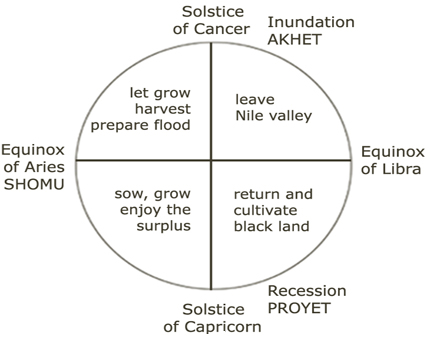
Nilotic (Sothic) cycle
When the waters recede, a layer of silt is deposited
over the land, giving new fertility to the soil. Then, it is time to sow
in this newly watered and fertilized land. During the winter and spring,
crops grew until they were ready to be harvested in early summer, and,
after the coming of the summer rains, the
cycle started again ...
Thanks to the Dog Star, the Nilotic cycle could be timed. By its annual
appearance at dawn, i.e. together with the Sun, hence "heliacal rising",
Sirius, associated with Isis, heralded the inundation of the Nile. Did the
Egyptians of prehistory already notice that the heliacal rising of Sirius,
after a period of seventy days of invisibility, always came a few days
before the start of the annual inundation ? The godess Sopdet was depicted
as a sacred cow bearing the symbol of the year (a young plant) between her
horns. As the
agricultural calendar began with the rise of the Nile, Sirius was also called
"bringer of the New Year". Sirius was known to the Greeks as
"Sothis", derived from the Egyptian "Sopdet" ("spdt").
A link was forged between the diurnal movement of the Sun, the appearance
of the bright Sirius and the beginning of the civil calendar. The latter
was designed to meet the administrative demands of the nation. It had
three seasons of four months, related to three important agricultural
events : inundation, recession (of the water) and dehydration (of the
land). The civil year had 12 months of 30 days, three seasons of four
months and was inaccurate. It was revised by adding 5 days at the end of
the year. So in this calendar, Sirius arrived around the 19th of July (the
end of modern, Gregorian August). The first month was called "Akhet" or
"inundation". It is the season when the Nile was in flood (mid July to mid
November). "Proyet" or "springing forth" was the time in which land
emerged to be planted (mid November to mid March), and during "Shomu"
("deficiency") the land dried up and harvest was necessary (mid March to
mid July).
The Sothic year is nearly 6 hours shorter than the equinoxal Solar year
(about a day every four years, or nearly a month every century). As the
years went by and became centuries, the civil calendar moved out of
alignment with agricultural & cultic events. To return to its beginning,
the Sothic cycle needs 1460 years. The Egyptians invented two more
calendars to correct this, but kept records of the Sothic year anyway.
Danger (crocodiles, water serpents, hippo's) and prosperity (fish and the
annual silt brought in by the inundation, cause of rich harvests) lurk
beneath the dark surface of the Nile. It depth is suggestive of the
primordial waters of precreation. Fish, both of the sea and the Nile, was forbidden to
the priests (as was swine), though generally eaten by the rest. The Apis
Bull was not allowed to drink the water of the Nile, for the god Hapy had
a fattening property. The Hymns to the Nile, composed and chanted
by the priests of the god, express -in tune with the overall dualistic
approach of life- the double nature of the Nile, for Hapy "the
good Nile" is praised for the plenty he gives (represented by the Lotus
and the Ankh), while feared for his caprices. Both were of crucial influence on the
Egyptian state. The reproaches were in conformity with the chaotic nature
of the Nile floods, to wit : Hapy could "plunder" (too much flooding) or
be "sluggish" and "heavy" (insufficient water).
"Hail to You, Hapy ! Sprung from Earth ! Come to
nourish Egypt ! Of secret ways, a darkness by day, to whom his followers
sing ! Who floods the fields that Re has made, to nourish all who thirst,
lets drink the waterless desert ; his dew descending from the sky. (...)
When he plunders, the whole land rages, great and small roar, people
change according to his coming. (...) Entering the cavern, coming out
above, he wants his coming secret. If he is heavy, the people dwindle, a
year's food supply is lost. The rich man looks concerned, everyone is seen
with weapons, friend does not attend to friend, cloth is wanting for one's
clothes, noble children lack their finery, there is no eye-paint to be
had, no one is anointed."
Great Hymn to the Nile,
Lichtheim,
1975, vol.1., pp.205-207.
Hapy's extreme moods had a decisive influence on the
wellfare of the Egyptian state. Too much water destroyed the channels and
the dykes. Not enough water reduced crop. Without reserves, the outcome
was famine. Despite Nilometers and centuries of observation, the Egyptians
remained unable to predict the date of the inundation and/or the quantity
of water displaced. In general, extreme Nile-floods parallel periods of
cultural disruption. So close is this relationship, that one may see
Ancient Egyptian civilization as the child of the Nile.
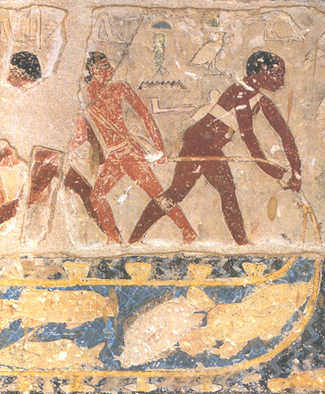
The tomb
of Nianchchnoem - Vth Dynasty - ca. 2380 BCE.
the men pull long nets to catch various kinds of fish
The reasons for their inability to predict this vital variable were
mathematical. The inundation of the Nile is chaotical (caused by more than
three independent variables). The function can be plotted (in
phase-space), but an individual prediction cannot be made. A "strange
attractor" may drive the outcome of the function into certain probable
pathways, but at no point in time can a solution be derived. This
determination of Egypt's vital resources by Hapy's chaotic process, may
have contributed to the conception of order (creation) surrounded by chaos
(precreation). The presence of self-creation within this chaos (namely
"Atum") compares with the "higher order" exit provided by the strange
attractor in chaotic phase-space (cf. my
Chaos, 1996).
This is nothing less than the return of order after chaos, the dawn of a
new Sun after darkness, and the preexistent, precreational potential to
rejuvenate.
►
the Nile, the primordial waters, the chaos-god Nun ...
To the eyes of the Horus falcon, floating in the sky high above the
striking contrast between rich cultivation and parched aridity, the "Beloved Land" ("ta meri"), as Egypt was called by the Egyptians (the
word "Egypt" comes from "Hikuptah", the native name of the temple of
Ptah), is a stretch of fertile land along the Nile, surrounded by
deserts. The riverbanks and fields are the "Black Land" ("kemmet"),
bordered by the "Red Land" or "deshert", a sandstone desolation called
"desert" to this day. This situation also offered unseen
protection and isolation.
The Nile is the main artery of this geography, and the two banks the
result of the divide : the domain of the living (East bank) versus the
land of the dead (West bank). During the day, the Nile is the god Hapy,
and at night, the Milky Way of the starlit sky. During life, boats were
the essence of Egypt's cultural exchange and civil unity. When deceased,
they bring one "to the other shore" of the Nile, the afterlife. Arriving
in the netherworld, one hopes to exist in the Field of Reeds of Osiris.
Travelling to the sky on the netherwordly Nile in the Solar Bark of Re,
one enters the Field of Offering.
The "Four Pillars" of creation reflect the
sacred geography of the land itself : on the one hand, Upper (upstream) versus Lower
(downstream) Egypt (South/North) and, on the other hand, dawn versus dusk,
life versus afterlife (East/West).
"The Nile is the first and greatest of all rivers. To the Egyptians it
was, simply, The River ; all other rivers were counterfeit, pretenders
never wholly to be trusted. (...) The Nile is the most paradoxical of
rivers for it flows imperturbably through a great desert, its waters rich
with life rushing through a landscape that is mostly barren and scoured,
typical desert terrain." -
Rice, 2003, p.9.
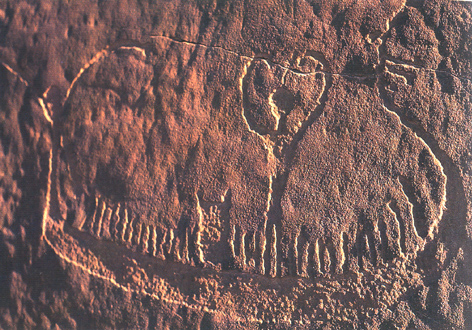
Wadi
Barramiya - Boat and human figure - ca. 4.000 BCE, after
Wilkinson, 2003.
The deep, black darkness underneath the surface of the Nile
is the great hidden secret upon which the boat navigated. This deep
represented the best one could receive from the river : abundant gifts of
life, prosperity and the luxury of time, the foundation of
all grand cultures. However, nobody could look the Nile "in the face", for the
gods never reveal the name "unknown to those below", namely the secret of
the "All-Lord who sustains the shores !".
Again, as had been the case in the Upper Palaeolithic cave mysteries and
the remote Neolithic petroglyphs,
the undifferentiated nature of darkness, the pitch-black deep of the
river Nile, is invoked to
step outside the natural cycle, as it were transporting consciousness
into a realm before and after creation, outside the created universe, in a
mythical place-of-no-place, ruled by a time-of-no-time. The Egyptians
identify the deep of the Nile with the primordial, endless and
undifferentiated "waters" of precreation. This is a "time before time"
written down as a virtual adverb clause, meaning "before he has (had)" ("n
SDmt.f"). In the Old Kingdom, this preexistent realm was spatiotemporally
defined ("without" and "before"), but in the Late New Kingdom (Amenism),
it will also be understood as an ontological segragation, a realm dwelling
everywhere in creation "behind" the screen of an infinite number of forms.
This precreational transcendence is thus spatiotemporal and sacred.
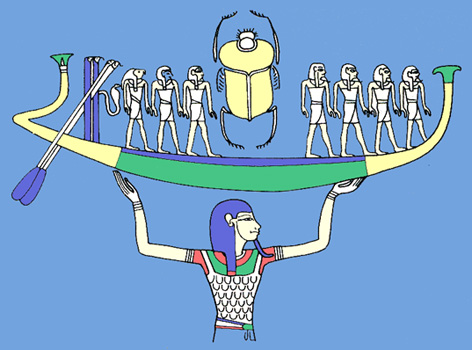
Nun lifts the Bark of the
Rising Sun
after the Papyrus of Anhai - Late New Kingdom
"Noun a été consideré comme le
père d'Atoum à Hermopolis. Sur les sarcophages, une vignette rappele la
renaissance du soleil, émergeant du Noun, destin que le mort espère pour
lui-même. Mourir était plonger dans le Noun et même le sommeil était
assimilé à cette étape vers la régénerescence, laquelle rappelle la vie
prénatale, l'existence protégée dans l'univers aquatique du sein maternal,
d'où émerge le nouveau-né comme le soleil 'entre les cuisses de Nout', le
déesse du ciel. Cette force universelle se diffuse partout, aussi le
dieu-soleil a-t-il été appelé le Ba de Noun." -
Rossini & Schumann-Antelme,
1992, p.143.
The Egyptians personified the undifferentiated, primordial realm of
"water" as the god "Nun", the "father of the gods",
passive in everlastingness. Hidden in this
undifferentiated matrix, lay the virtual, primordial "egg", the
sheer possibility of autogenesis (Atum as Ba of Nun is "xpr Ds.f" : "who
came into being of himself", the Greek "autogennetos" - cf.
Hermes and
Hermetism). Hatching at
the "first time" of creation ("zep tepi"), the
dynamical autogenetor called "Atum" ("tm", "be complete") and represented
by a sledge, initiates the mythical
era. "In the beginning", the binary deities and creation spring out of this
primordial, self-created Atum (the atom of being), the truly, sole, unique
and "Great God" of
creation ("nTr aA" and "nTr wr"), suggestive of totality and
completeness. He is the "father of the gods", active as
eternity-in-everlastingness.
If Nun is the Nile, then Atum is the "first bark", the condition of light
itself, the container allowing the fire of the Sun to be separated from
the waters of precreation, making creation come into being. Atum is the
soul ("bA") of Nun. On the sledge of Atum, creation moves in eternal,
sacred cycles. The cyles of life, birth, death and resurrection, befalling
the gods, humanity and all living, sentient beings alike, occur, because
of the primordial autogenesis hidden in the deepest darkness. The
bark is the uterus in which creation unfolds. The Nile is the eternal
cycle of the preexistent chaos ... A deity travelling in a bark, is the
image of a type, an ante-rational conceptualization of a natural
differential part within a local context of interpretation.
The primordial state of precreation, the
undifferentiated Nun out of which the creator-god Atum self-manifested, is
like a preexistent ocean, a precreational Nile. Were it not for the powers
of the deities, in the first place Atum, all of creation would return to
these chaotic waters, eliminating all differences and equalizing every
division (reducting the energy-potential, i.e. the differentials between
existing points, or disproportions between higher and lower levels of
being, to zero). Simultaneously, these waters, indicative of the
collective unconscious, are the source of all disruption, dispersion and
annihilation, as well as the origin of regeneration, rejuvenation and
(re)creation. They hold the mystery of autogenesis, the power of
the autogenetor, the completion of the All itself.
► remote Neolithic petroglyphs in Egypt
The Neolithic Egyptians of the early fourth
millenium BCE had no caves, but, using the mythical mode of cognition,
carved remote petroglyphs, thus making a selected number of meaningful,
sacred forms permanent and ensuring the survival of the ancestral record of particular
differential types of nature and their co-relative mythical states of mind.
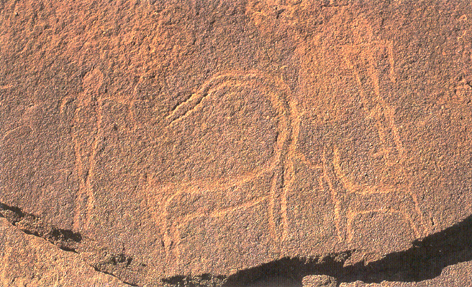
Wadi Abu
Wasil - Hunters and a Dog trapping an Ibex - ca. 4.000 BCE, after
Wilkinson, 2003.
"The scenes which
appear on the Egyptian rock surfaces reveal many elements of continuity
between the late Neolithic period, to which the early works belong and the
long sequence of royal rule which was to follow them. Although Egyptian
rock art shares traditions with both the Sahara and Arabia even at its
earliest it is recognizably Egyptian, powerful and assured in technique
and content." -
Rice, 2003, p.41.
These petroglyphs were inscribed to
eternalize and control a series of important natural stereotypes related
to herding, Nilotic life and the phases of the Moon. Much later, the same intention would trigger
divine, Solar kingship, hieroglyphic writing,
tomb-building and the familiar scenes on the walls of Egyptian temples. A
double aim is at work : on the one hand, religious eternalization
(the fixation of one's relationship with nature and its "Natur"), on
the other hand, magical initiation (the beginning of a new, more
protected and rejuvenated conscious awareness).
In the functional aspect of the process, darkness and remoteness again came to the fore
... These were required because, like in the Upper Palaeolithic cave
mysteries, the same spiritual process involving the secret of darkness is at work.
Differentiation, mystery and integration being expressed in terms of
light-to-darkness, hidden light and darkness-to-light. In the bright Sun
of Egypt, shade offers a stark contrast ...
"In is no coincidence that
some of the greatest concentrations of rock art in the Eastern Desert
occur in shaded and partially hidden places : cliffs overhangs,
rock-shelters, and the like. Not only do these places afoord some
protection from the heat of the sun, which must have been intense during
the middle of the day, even in prehistoric times ; they also, and perhaps
more importantly, offer seclusion. They are places where people would
withdraw, at least partially, from the natural world, to commune with the
supernatural. In other words, they are places were a spiritually charged
atmosphere was more easily invoked. While we shall never know exactely who
made the petroglyphs in the Eastern Desert, nor in what circumstances, it
seems very likely that they were made during the course of magical or
religious ceremonies. They may even have been created by shamans in a
state of trance, or at least by elders of the community with some degree
of spiritual authority. (...) They express an idealized view of the
cosmos, where supernatural forces assisted humans in overcoming natural
forces." -
Wilkinson, 2003, pp.138-139.
Among the petroglyphs, we find a considerable number of boats. Among these
are high-prowed boats, including standing figures of superhuman scale,
nude or wearing short tunics or long caftan-like robes, with plumes or
feathers in their hair. In one petroglyph at Wadi Mineh, a falcon stands
in the prow of the vessel. In other glyphs, part of the royal regalia are
shown (crown, crook, flail).
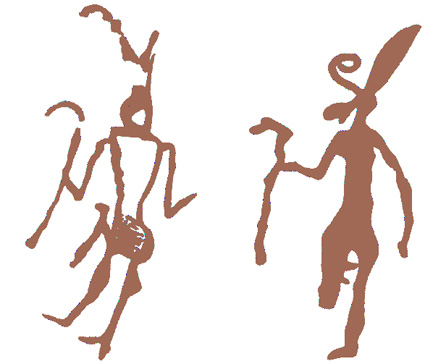
Wadi Qash -
Upper Egyptian ruler with Red Crown ? - ca. 4.000 BCE, after
Wilkinson, 2003.
"The parallels between the rock art
of 4000 BC and the tomb scenes of 1500 BC are indeed striking. The
discovery of the boat petroglyphs faces us with two astonishing
revelations. First, the familiar ancient Egyptian concept of the afterlife
originated at the very dawn of civilization in the Nile Valley, among the
semi-nomadic cattle-herders whose domain encompassed both valley and
savannah. Second, this concept was so powerful and so resonant that it
remained unchanged throughout the succeeding thirty centuries. The
longevity of Egyptian culture is as ramarkable as its antiquity." -
Wilkinson, 2003, p.189.
the bark : ancestral concept of
balance, momentum and limitation
"The archers complete the aim,
as one who holds the rudder untill (it) touches land."
Ptahhotep, maxim 25
- Late Old Kingdom - ca. 2200 BCE.
For crocodiles and hippos, a boat is a lengthy
floating piece
of wood. Egyptian fishermen use it as a means of transport on the Nile and
to catch its riches in nets. For Pharaoh, the flotilla was the best
mobile way to tour Egypt and propagate his glory. For deities, barks are
the vehicle of their mystical journey to and from the beyond. For the
deceased, an anticipated place, side by side with the soul of Re, the
creator-god.
"The Naqada II people seem to have been much
impressed by boats. Whether this implies that they were originally from a
region where water transport was even more important than it was in Egypt,
is not certain ; it may simply have been a sensible reponse to their
proximity to the river. But an extraordinary number of their productions,
painted on pottery and carved in or on slate and schist, represent boats.
Clearly these are often sacred vessels and as such were the ancestors of
the sacred barques in which Egyptian divinities, like their Sumerian
counterparts, were accustomed to travel." -
Rice, 2003, p.33.
As in a womb or cradle, the boat, bark or ship enables all to travel
safely, steering life in a balanced way. But capsized, it brings death.
Can our phenomenology exceed the notion of the boat as a
solid concept transmitted from generation to generation, as
suggested ?
"Psychologically, the ship can be understood as a
symbol for a solid mental concept based on the knowledge and experience of
the ancestors." -
Abt & Hornung,
2003, p.25.
In the Early Predynastic Period, the petroglyphs of the Eastern Desert
profile the boat as already of considerable importance. The assimilation
of the crescent Moon with the image of the bark was to be expected. Both
were crucial instruments of navigation. In the Upper Palaeolithic and
Neolithic periods, the bark protected against the deep of the waters in
the same way as the Moon lits up the darkness of the night and transforms
it into a kingdom of shades.
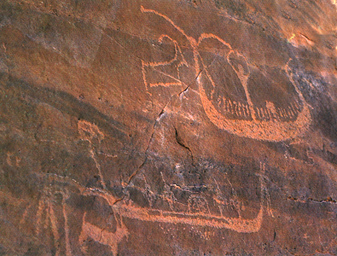
Wadi
Barramiya - Flotilla of boats - ca. 4.000 BCE, after
Wilkinson, 2003.
With their glyphs of barks, flotilla of
barges, or procession of boats, the Predynastic Egyptians expressed the
enduring quality of their mythical mindset, able to distinguish between the
undifferentiated waters (or primordial origin of consciousness) and
creation, while
actively identifying "divine powers" (i.e. natural differentials) to move along the arrow of time and
encompass the "Two Lands" by means of the river. A company of
boats is hence a family of successful evolutionary histories, a metaphor
of cooperation and mutual respect between the Egyptians themselves, and
between their way of life and their natural environments ruled by natural
differentials. This is the image of a triumph over
chaos shared with all. This naturalistic and typological view on the
deities was also quite original.
"There is little similarity, equally, between the way the Egyptians and
the Sumerians visualized and personified their gods. Sumerian divinities
were essentially human in appearance, and their attributes and their
behaviour were merely the characteristics of humankind written large. The
Egyptian gods were a great deal more complex and diverse. It appears that
the earliest divinities were abstractions, represented by objects which
had acquired a special sanctity. The most ancient sign for 'god',
netjer, is abstract ; it is thought that it represents 'a staff bound
with cloth'". -
Rice, 2003, p.50.
In the Old Kingdom, the spirits or "Akhu" (of the noble ancestors and
the deities) were
believed to live in the light of the circumpolar stars. These so-called "indestructibles" never
disappear from eye-sight and were deemed to be the ultimate destination of
the deceased Pharaoh, who sails on the celestial Nile to the sky of Re.
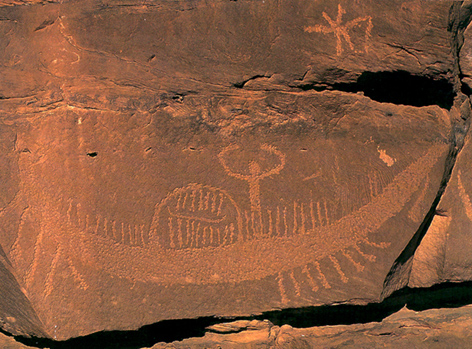
Wadi
Hammamat - Boat with Star above the prow - ca. 4.000 BCE, after
Wilkinson, 2003.
A tall being, with arms raised,
steers a boat starwise. Another giant wears two plumes. In Egypt, deities
travel by boat. Re and Osiris have barks. Ptah and Amun as well. Most
barks are floating temples, fronted by miniature obelisks, flagstaffs and
ordained cabins. On feast days, gods like Khonsu and Min sailed their own
barks, with priests rowing the vessels on sacred lakes or directly on the
Nile, visiting other deities ...
The deities, the best, most efficient part of the natural cycle symbolized
by the Nile, must protect themselves from the Nun too. Their barks shield
their fire from being extinguished by these waters. In this they succeed,
ex hypothesi, by
knowing how to harvest the secret of darkness, the autogenic
potential of the undifferentiated, of Atum hidden in Nun. The metaphor
of the "Two Lands" illustrates how within creation,
division and duality are deemed common. Atum, the Nature of natures, transcends
creation because he emerged before the spacetime continuum, whereas in
the continuum the divine (on Earth) is Pharaoh, the great magician, who is able to
simultaneously "exist" in
precreation and creation. Within creation, nothing else really endures. All other gods & goddesses are born,
die and resurrect, as
Hornung (1986) has
so brilliantly demonstrated. They are like differential quantum equations
of probable states of nature. Only Atum is fugally transcendent. Of
course, compared with the power of mortals, their divine life
potential is enormous. Nevertheless, this collective energy of the divine remains
finite (within creation) and contained by Nun, the infinite chaotic waters,
everlastingly
surrounding creation in all possible directions.
"Le monde émergea du Un, pour les Égyptians, car le
non-existant est Un. Dans son œuvre de création, le dieu créateur
différencia non seulement le monde mais encore lui-même. Du Un est issue
la dualité de 'deux choses' et la diversité des 'millions' de formes
créées. Dieu divisa, la création est division ; seul l'homme embrouille à
nouveau tout. Les éléments divisés dont interdépendants, mais demeurent
divisés tant qu'ils sont existant. Seul le retour à la non-existence fond
ce qui est divisé et annule à nouveau la différenciation." -
Hornung,
1986, p.232.
The permanent features of
creation, i.e. a series of "laws" of nature, embodied by
the divine life of the pantheon, cannot be rooted in these differentials
themselves, for they too are
caught in the eternal cycle initiated by Atum. The
deities have their cause not in themselves, but in the "zep tepy" or
"first time", the beginning of time not yet "in" time, mythically starting
with the autogenesis of Atum.
-
Atum within
Nun : potential to autogenerate ;
-
Atum as "ba"
of Nun : autogeneration, first time, pantheon, creation ;
-
Nun as Nun :
undifferentiated, chaotic, passive, dark, empty.
In which way, beside the remoteness
of the art, is the petroglyphic theme of the bark associated
with the autogenetic secret of darkness and does it contribute to our understanding of the constructive
role of the absence of light & the mysteries of the night ?
The funerary implications of these barks have recently been underlined
again by
Wilkinson, 1993 and
Rice, 1993. Not only in Predynastic Egypt
was the boat endowed with mystical significance transcending their purely
functional role.
"Ships of the type portrayed on the Wadi Hammamat
walls, on countless pots and other objects, are to be found in many early
Mesopotamian and Elamite or Susian media. They are represented widely for
example on late fourth/early third millennium cylinder seals found in
large numbers on western Asiatic sites whose use persisted throughout most
of the third millennium. They are represented, too, on the round stamp
seals of the Arabian Gulf, which are dated to the end of the third
millennium and the beginning of the second." -
Rice, 2003, p.41.
The Egyptians reshaped the mystery faced in the deep, dark caves of France
into the Nilotic spirituality of the netherworld, the "Beautiful West" of
the "land of the dead" reached by means of a boat. In this inner world, the potential of autogenesis
could be tapped. The deities and the noble dead alike, drink from this
source and it is the "hidden light" sought.
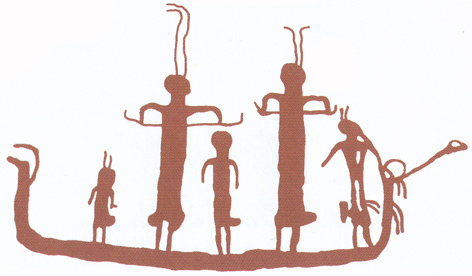
Wadi Abu
Wasil - fragment of an impressive rock art tableaux - ca. 4.000 BCE, after
Wilkinson, 2003.
In pointing to the West, the
place were the Sun set, these petroglyphs support a funerary interpretation.
In many scenes, there are human figures with upraised, curved arms. We
find this feature in three dimensional clay
figurines deposited in Predynastic graves. The posture figures on Nagada
II pottery, and is rarer in settlements than in cemeteries. Although early
egyptologists saw the gesture of curving the arms as mimicking cow horns
(cf. Hathor and the cult of the great Moon goddess),
Wilkinson rightly points out "that it may have
represented an attitude of mourning" (2003, p.155). Indeed, often
there is a central cabin, which, from later parallels, may represent a dead
person, accompanied by a mourning crew and watched over by a presiding
deity (represented by a tall figure with two plumes).

Wadi
Barramiya & Funerary Boat near Kanais - ca. 4.000 BCE, after
Wilkinson, 2003.
The theme of a journey by boat
remained central to the Egyptian concept of the afterlife, and returned in
the Pharaonic Period. Not only did Pharaohs place these sacred boats near
their tombs,
either in miniature form or full-size, or near the "naos"
in their temples, but the theme became fundamental in the New Kingdom Books of the
Netherworld and their rich iconography. These vessels accentuated the
nurturing role of the Nile, and point to the spiritualization of the
river, which carried the dead to the various levels of the eternal
afterlife. The spiritual Nile led the deceased out of the mortal world of
time, if they were deemed worthy, into the timeless eternity of the
afterlife and its paradise.
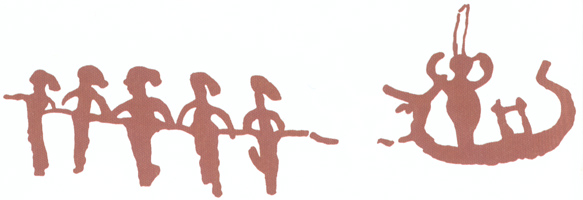
Wadi Abu
Wasil - Boat being dragged - ca. 4.000 BCE, after
Wilkinson, 2003.
In Predynastic Egypt, the image of the bark of
a deity
dragged by attendants was carved on rock. Three millenia later, the
journey of the Solar
Bark adorned the walls of most royal tombs. These continuities provide
backing for the hypothesis that the founding elements of Dynastic Egypt
are rooted in the cultures of the Predynastic Period. With the Gerzean
(ca. 3600 BCE), a decisive turn was taken, culminating in the unification
of Egypt and the start of history (ca. 3.000 BCE). The "canon" established
in the Old Kingdom bears the traces of its Predynastic origin, as does the
first religious corpus of humanity, the Pyramid Texts.

The
Twelfth Hour - Middle Register
Tomb of Pharaoh Tuthmosis III - ca. 1426 BCE.
►
balancing eternal rhythms : the role
of
precreation
In the Late Predynastic Period (ca. 3600 BCE), the influence of the Solar cycle
(recorded since the Neolithic) on the old Lunar faith (going
back to the Upper Palaeolithic) becomes clearly traceable. The process of
theo-political centralization of power in male
rulership, whereby the sacred forces of the great goddess were assimilated by
male chiefs, had already been at work ca. 4000 BCE and
before (cf. the stone calendar circles of Nabta -ca. 7000 BCE- and, around
5000 BCE, the start of the
Neolithic in Egypt, with the presence of small village communities with a
local horizon).
Rhythms defined Ancient Egyptian culture. On a terrestrial, microcosmic level,
there was
the Nile with its annual inundation, bringing economical abundance or
famine (the Sothic or agrarian rhythm). On a cosmic, macrocosmic level, there were
the cycles of the Moon, the Sun and
other stars, representing the fundamental divine powers of nature : Re
(Sun) and Osiris (Moon). Both rhythms
had to be balanced out. The plummet of this balance, offered by
Pharaoh to his father, was set in motion by the "two
scales" : the human (the heart, weighed in the Osirian mysteries) and the divine (the
feather of Maat, daughter of Atum-Re, the celestial creator-god). Maat (also
written as
"Ma'at") being the true, just and real equilibrium,
the proper, hierarchical (pyramidal) and natural order of things.
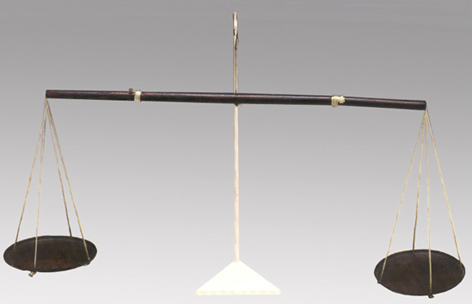
Scales -
Amarna House U36.41 - XVIIIth Dynasty.
The dynamical, natural equilibrium represented by Maat is not easy to realize, for a
constant struggle between, on the one hand, the created order (divine, in
particular Re and Osiris, as well as human, in particular the king)
and, on the other hand, destructive chaos (i.e. the untamed natural world, especially wild animals,
unsettling Nile floods, the primordial Nun and Seth's "isefet") animates
life as a whole
and is fundamental to it. The notion of the "Dual Kingdom" reflects a
fundamental dualistic approach of reality, at work in all parts of the
cultural form. Creation has no inherent harmony and left to its own will
return to a state of undifferentiated chaos.
"The idea of the Dual Kingdom always appealed
greatly to the emerging Egyptian consciousness as giving evidence of the
most exalted example of what constituted virtually a national obsession,
the expression of all the most important characteristics of the society
-divinity, beliefs, customs, the very order of the universe- as being
bounded by a duality : for the one there was always the other, in king,
gods, nature and the ways of men." -
Rice, 2003, p.95.
The deities do sustain creation,
but they get exhausted doing so. At dusk, even Re seeks rejuvenation. Creation
is able to endure, because it, paradoxically, is rejuvenated by
returning to the eternal moment of the beginning before creation, the
autogenesis of Atum and the pantheon in a first moment happening outside
creation, but within the abyss of Nun ! Creation endures, because the deepest
darkness conceales the strongest light. The path to and from this
hidden light, is the midnight mystery of Ancient Egyptian spirituality,
the core of its teaching.
To eternally rejuvenate, the "netjeru", i.e. the superpowers, divine natures, primordial types or
natural differentials of N*t*r (Nature), need to harvest the strongest
power possible, envisaged as ultimately one, absolute and precreational,
i.e. outside the natural cycle. Only Atum, the "undifferentiated one" may
autogenerate himself and the deities anew. In the first time, Atum, as Ba
of Nun, does precisely this for all of
eternity. In this eternal moment, he
simultaneously splits in Shu and Tefnut, and the Ennead comes into being
and with it the completed power of the new creation, the new day.
► the mystery of darkness : bark, temple and tomb
The darkness of the undifferentiated waters is inimical to life and order.
A direct contact between order and chaos annihilates the former.
Complexity, heterogeneity and the multiplicity operating the Two Lands
point to a pyramidal hierarchy of divisions. To endure, these
organizations need to remain separated from Nun. The deities guarantee the
endurance of creation, but invest their power while doing so. They
compensate this by retrieving the everlasting surplus of power available
in the "zep tepy".
The Bark of Atum-Re protects the fire of the creator-god against the
primordial waters. It is there to assure consciousness is
not possessed by the collective unconscious. It protects against the
powerful forces of the deep. In psychological terms, the bark is the
border or edge of consciousness, defining the capacity of the cargo.
Atum-Re is the light and brightness of consciousness, its ability to be
aware of itself and its existence. The Solar Bark is the domain of
Re's consciousness, able to transport millions of souls for millions of
years. The image of Re in his Solar Bark travelling day and night, points
to an optimized steering capacity, a Self fully individuated and in a
balanced way in touch, after dusk, with the powerful, rejuvenating forces
of the river. In the dark, they allow consciousness to rejuvenate itself
and heal from the various attacks it suffers during the day ...
"... the path that follows the temple's straight
central axis leads upward along a gradual incline of steps and ramps ; at
the same time the ceiling becomes increasingly lower, the rooms darker and
narrower. When the Nile overflowed its banks, it flooded the column rooms
of many temples, and thereby reified the illusion of the primordial
swamp." -
Hornung,
1992, pp.123-124.
So the Egyptian temple served the secret procedure of reducing light,
creating a narrowing darkness in order to approach the "holy of holies" and its
shielded "naos". This sanctum sanctorum was withdrawn
from the world of light and had to be approached by series of courts,
halls and gates. Only in this remote place outside phenomenal time,
could a hidden alchemy or mysterious conjunction take place, namely
between, on the one hand, the cult-statue of the presiding deity who's
spirit enjoyed the sublime, stellar life, joined with the followers of
Atum-Re, and, on the other hand, the officiating high priest, representing
Pharaoh. This crucial activity took place at dawn, and so the Egyptian
Temple is a diurnal instrument of transformation (the tomb, by contrast,
is a nocturnal ritual tool). But again, and despite the morning, darkness
plays a central role.
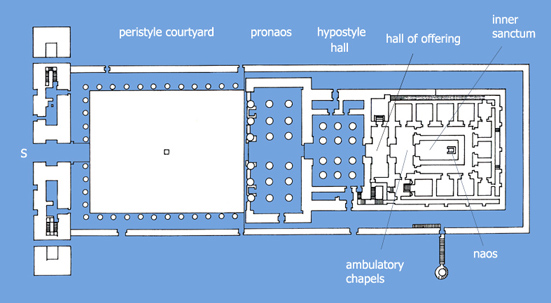
The temple of
Horus - Edfu - Ptolemaic Period (after Old Kingdom examples)
its central axis runs parallel to the Nile
"The conclusion may be drawn
that temple building and religion in ancient Egypt shared a universally
valid framework in which there were many individual variations, and which
itself did not remain unchanged but was constantly expanded by
developments within the religion."
Kurth,
2004, p.12.
Once a day, at dawn, the high priest entered the
inner sanctum. The darkness there was deep. The candle lit the
previous Morning Ritual had consumed until only darkness remained. In this
sacred area, with carved and brightly painted walls, stood the sacred
barque on its pedestal, in the back was the naos with its cult statue, an
altar with offerings and a wooden coffer with ritual implements. The door
of the naos was clay-sealed. At the very instant when the Sun rose on the
horizon, with the first words of the Morning Song, the seal was broken and
the two door-leaves were drawn towards the high priest, who faced the
cult statue, saw it and identified with it.
"I was
presented before the god, being an excellent young man while I was
introduced into the horizon of heaven (...) I emerged from Nun, and I
was purified of what ill had been in me ; I removed my clothing and
ointments, as Horus and Seth were purified. I advanced before the god in
the holy of holies, filled with fear before his power." -
Sauneron,
2000, p.48 - statue - Cairo museum 42230.
This assumption of the godform, the singular climax of all temple
ceremonies in Ancient Egypt, causes a conjunction between (Pharaoh's)
consciousness and the archetypal representation of the deity, between the
"son" of Re (or his representative) and Re (or one of his family members).
It is a Morning Ritual, opposing dusk and the Beautiful West. Egyptian
temples are always Morning Temples. They have a celebrational function,
not a funerary. They do not exclude funerary themes (like the Osiris
drama), but focus on the actual presence of the deity in the naos
during the day. This sacral actuality is the numen præsens, the
presence of its many "doubles" and "souls", i.e. outer and inner
operational (and intermediate) states of divine consciousness. As the tomb
allows the deceased to ascend and descend, so does the temple allow the
deity to be effective on Earth or not. After dusk, together with Re as
described in the Books of the Netherworld, the deities meet the midnight
mystery of the Duat to be regenerated and return their souls and doubles
to Egypt the next morning.
At the end of the elaborate Morning Ritual, the face of the deity was
concealed again by shutting its double door, sliding the doorbolt slut and
locking it with a clay seal to bar access until the following morning. For
an unknown duration, a candle was left burning. In the Midday Ritual and
the Evening Ritual, the sanctuary remained closed and the deities received
no more food until dusk. The Evening Ritual was a repetition of the
Morning Ritual, except that all rituals took place in the side chapels
surrounding the inner sanctum. This daily cult took place
simultaneously in almost exactely the same form, in every Egyptian temple.
Of course, in smaller temples with only one or two priests, there would
have been no pomp and certain adaptations necessary.
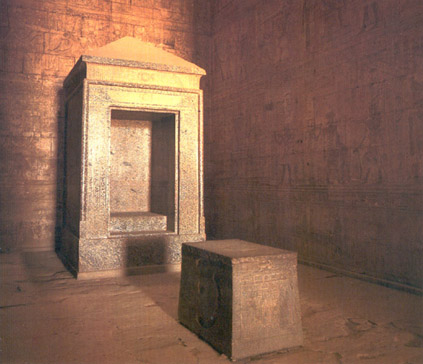
Naos of Pharaoh Nectanebo II
(ca. 350 BCE) with altar for Sacred Bark.
Inner Sanctum of the Temple of Horus at Edfu
Because of the enduring offerings made to the
statue during the day (the Midday Ritual and the Evening Ritual), the Ka or "double" of the deity was fed and energized. The Ba
or "soul" of
the deity would then be gratified and so bless the temple by its presence
(while its Akh or "spirit" abided in the sky). The Akh was hidden, secret
and remote, of name unknown, but the souls and doubles of the deities
could come down by means of the proper sacrificial consecration. On Earth,
the gods and goddesses had to be "nourished" by offerings and
voice-offerings (cf. the noun "nTr" as "god" and the verb "s-nTr" meaning
"to consecrate, to cense" - the latter being the causative derivation of
the phonetic root "nTr"). The Egyptian concept of "god" is therefore more
like a differential equation, a series of relationships describing the
functional behaviour of a particular, well described natural phenomenon
(whether material, psychic or spiritual). Ritualism is then like "solving" the equation,
i.e. applying the formula (cf. "senetjer").
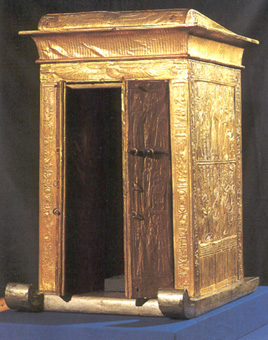
Miniature shrine - XVIIIth
Dynasty - ca. 1325 BCE.
The darkness of the naos hiding the deity.
"Comme l'obscurité et le
silence, le vide est une négation : elle exclut toute présence concrète de
telle sorte que le 'tout autre' se réalise en acte." -
Otto, R. : Le Sacré, Payot -
Paris, 1995, p.109.
The parallel of the diurnal temple (feeding the
presences of the deity during the day) is the nocturnal tomb (the joining
of the deities in the afterlife and the return to the tomb). The Egyptian
tomb is a space consecrated by the presence of a mummy, a ritual corpse
allowing the intermediate states of consciousness to ascend and descend
the ladder between life "on Earth" and "the sky" (cf. the step-pyramid).
The "false door" of the tomb works both ways. The deceased rise to the
sky, but are free to descend and enter our physical, coarser plane of
existence.
As the subtle stellar
light of consciousness reflects down and solidifies in coarser modes of
conscious being, funerary magic aims to control all conscious states and
possibilities, and to do so, conjectures various intermediary states of
consciousness and its expression, such as the "shadow" ("Khaibit"),
"heart" ("Ab"), the "double" ("Ka"), the "soul" ("Ba"), "name" ("Ren"),
"spirit" ("Akh") ... If the aim of the Egyptian tomb was to guarantee the
deceased a good Egyptian life in the afterlife, then this life is one of
participation with the living. This side of the funerary equation has been
often overlooked. The deceased did not (as would the Greeks and the
Levantine religions) try to escape this world to never return. They wanted the best of
both visible and invisible realms, in short : the whole of creation,
living and death. As death is another way of living, the deceased
family-member of today is to be expected tomorrow and can even be written
to.
The liberated ones "true of voice", justified & blessed, are able to return to all their previous states and
stations (cf. the role of the mummy in the formation of the ritual "sah", the
noble body of resurrection). They may enter the physical
world and commune with those still incarnated in the "net of the body".
This materialization of their spirit is the result of a completely
successful spiritualization of matter. Hence, the spiritual ideal of
the religion of Kemet was a liberated,
free, light, radiant, sublime and effective (creative) state of conscious
awareness. The life of the
Akh-spirit flows over and adds reality to the real. The magician makes monumental
voice-offerings to glorify these differentials of N*T*R, to attract their
attention and blessing (as the effective presence of their inner and outer
powers).
Pharaoh's time and sacred timelessness
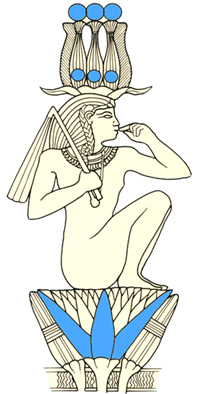
Pharaoh Iuput as Horus the
Child
adapted from faience plaque - XXIIIth
Dynasty
A new day does not being with the emergence of light. The day is born at
midnight, and emerges as a child at dawn (cf. Harpocrates, touching his
lips with a finger). We may well see this dawning as the beginning, but
the origin of its glorious power lies hidden in the secret of the night
(as birth results from conception). This secret is ipso facto the
great silence, the midnight mystery of creation. Dawn is hence the end
result of the process of integration of the surplus acquired by Re when
united with the mummy of Osiris (cf. the mysteries of Sokar and Amduat,
6th Hour). Thanks to this singular conjunction, the nocturnal, hidden
light becomes effective, repolarizing the cycle of Re, which then moves
from differentiation to integration (instead of vice versa). At midnight,
the roots of the Lotus of Creation are fed by precreation and rises from
the primeval waters. Its flower opens at dawn.
The appearance of Pharaoh on public occasions, is
like the first diurnal manifestation of light at dawn, like the face to
face encounter of the high priest with the cult statue during the Morning
Ritual. To behold a perfect godman, is to share in his being. Seeing is
being. Blindness (the destruction of the eyes) is annihilation (of
identity - cf. the Eye of Horus).
He who sees the dead Osiris will never die.
Book of the Two Ways,
Coffin Texts, Spell 1050.
When Pharaoh is enthroned and coronated, a profound change occurs. Pharaoh
"appears" before the protective divinities of the lands of Egypt. The king
is always crowned twice. The coronation marked, on each occasion, a new
beginning and a renewal of time. The Egyptians counted time from the
coronoation of each Pharaoh. The rite was postponed until a new cycle of
Nature began. Hence, phenomenological time is measured by a divine
standard. Time is always sacred and thus subject to eternal renewal. Time
is Pharaoh's time.
Cyclical rhythms define the dynamical features of phenomenal time, its
repetitive ongoingness. Enduring states reflect the architecture of time
itself. So two meta-cycles concerning time itself are conceptualized and
made to work in the verbal system of the Egyptian language ("aspect" or
kind of action indicated by a verb vorm), namely completion versus
repetition. The former indicates a finished, the latter a recurrent
action.
"Pharaoh's lifetime is eternal repetition.
His limit is eternal duration."
Cannibal Hymn, Unis, Utterance 274.
The Egyptians had two words for the timeless, spiritual, precreational mode of
time : "djedet" or "everlastingness" (eternal
duration) and "neheh" or "eternity" (eternal
repetition).
These transpose the aspect of time-as-station (passive, static) versus time-as-state
(active, dynamic) on the spiritual dimensions outside the natural order.
This distinction thus incorporates the myths of Nun and Atum
(the latter hatching himself out of the primordial egg hidden within the former).
"Neheh-time" is the sacred timelessness lived by the
Ennead
in eternity, i.e. the eternal repetition of the divine cycle of Atum's creation. "Djedet-time" is
the no-time of the undifferentiated Nun, the primordial, homogeneous,
everlasting chaos in which neheh-time lay dormant and began as the "first
time" of the autogenerated Atum, the Ba (or inner effectiveness) of Nun.
The "time of eternity" or "neheh-time" is the first
moment of time, not yet time (the first "At" of the time-line),
the first instance of the "first time" ("zep tepy"). Eternity
is always "in the beginning" and is brought into existence by Atum-Re, who
raised creation out of the dark everlastingness of chaos into the ever-brightful eternal
repetitions and repetitive movements of
neheh-time, which is the beginning of phenomenal time, the first instance
of Pharaoh's time (cf. Atum creating while masturbating).
On the one hand, djedet-time is, mythologically, a reckoning before
neheh-time (for there was a time when Atum was only potential). This
aspect refers to
Nun, the night, and the Judgement of Osiris, which is precisely the answer
to the question : "Does the deceased need to be forsaken to the
everlasting oblivion of djedet-time ?"
"To see the rays of the Sun for only one instant,
is worth more than to rule for all of eternity over the netherworld."
on the statue
of a priest of the
XXIIth Dynasty - Karnak
On the other hand, neheh-time, this timeless instant
born out of eternal repetitions (the recurrence of the same natural
cycles), co-exists with Atum hatching out of his egg and immediately splitting
into Shu and Tefnut. In the "zep tepy", the pantheon of
conscious divine spirits come into being. As an Ennead, the Akh-plane of unmixed and unsullied, pure lights
emerges out of the One God of neheh-time : Atum-Re. This dynamical mode of
eternal time "happens" in everlastingness, for the first time is not yet
creation.
"Neheh is often associated with the day and
the sun god, Re ; correspondingly, djet tends to occur in reference
to the night and to the ruler of death, Osiris. Neheh is often
characterized as dynamic, djet as static ; and as the etymology of
the terms reveals, they connote 'flow' and 'duration' of time,
respectively." - Hornung,
1992, p.68.
So neheh-time refers to the eternal repetition of the path of Atum-Re and
the pantheon, the differentials of Nature, Pharaoh included. Because it occurs in Nun,
neheh-time is an eternity-in-everlastingness.
Djedet-time reflects the static aspect of sacred timelessness, the eternal
duration of the passive and undifferentiated (primordial) Nun, i.e.
everlastingness tout court. Clearly djedet-time transcends creation
and neheh-time upholds it (eternally repeats it).
|
Summary of the Ancient
Egyptian view on time
|
|
Phenomenal Time "of men on
Earth" |
at
("At") |
moment, instant
small
portion of time, culmination time |
unit of
phenomenal time |
ahau
("aHaw") |
period, space of time
lifetime, man's age |
collection
of time-units |
|
Eternal time : the
repetition and duration "of the
gods" |
neheh
("nHH") |
timelessness - first
time
eternity, eternal and
unending repetitions |
Atum-Re, the deities
and the blessed
dynamical, cyclic |
djedet
("Ddt") |
no-time,
to be permanent,
stable, enduring, everlasting |
Nun, the
Ogdoad and the
mysteries of Osiris
static, linear |
►
the night or the opportunity, art and magic of
instantaneous renewal
By wearing the horns of gazelle and ibex, the Predynastic hunters of the
eastern savannah practiced sympathetic magic. While the psyche identifies
and assimilates the features of the sacred object, consciousness takes on
its form and a strong auto-suggestion is released into the
unconscious. This deliberate, conscious disequilibration prompts a
reaction (to allow for reequilibration, cf. the mechanisms of psychic
equilibrium discovered by Jung). However, as the injected seed has
universal symbolical connotations, the reaction stems from the collective
unconscious, triggering the emergence of an archetypal representation. The
splitting off of the outer shell of the archetype produces a bi-polarization of the archetype (cf. the psychoïd
nature of archetypes) and the eventuation of synchronicities and
parapsychological effects (telepathy & telekines).
The "magical" and "supernatural" phenomena accompanying successful
sympathetic magic are unique, not repeatable, immediate, direct, but not
hallucinatoric, for inter-subjectively valid.
These sympathetic identifications of the prehistoric Homo sapiens sapiens
would benefit the hunt (reducing one's fear of death), but also an existential nearness with the natural
cycle. By imagining their deities and assuming their powers, the chaotic
world could be ordered as well as dominated. The practice envolved a
movement away from phenomenal time "on Earth", into a sacred (set-apart)
timelessness "of the gods".
By reducing the presence of the natural
cycle, by dampening the rhythms of the natural cycles of "below", by
opening the doors of the dark "naos" after wide, spaceous courts, halls
and inner sanctuaries, by placing the magical mummy in the protected space
of the sarcophagus in the burialchamber, by imagining Re and the deities
to be reborn at midnight, the original Upper Palaeolithic,
Neolithic and Predynastic "shamanistic
trajectory" was refined. Having become quite complex by the time
of the Old Kingdom, the
basic principle had remained the same : a move from profane to sacred,
from consciousness (via the collective unconscious), to a higher, more
aware state (cf. "turîya"- the "fourth", superconscious state in Hinduism,
besides waking, dreaming and the dreamless sleep). This envolved the daily
repetition of the same process of rejuvenation involving the midnight
mystery and the secret of darkness.
This interiorizing trajectory, or Ars
Obscura, involves the
voluntary stimulation of the neural
"God-spot" in the right amygdala (for the right-handed), which is part
of the limbic system. In its complete form, this trajectory was at work in
the
Homo sapiens sapiens and leads, in optima forma, to a positive,
evolutive & constructive frontal-limbic spirituality (characterized by the
double balance of hemispheral synchronization and frontal-limbic
equilibrium),
involving a set of complex procedures to :
-
reduced sensoric input :
bracketing/changing the sensoric input in parts of the brain
(deafferentiation, to set a range to afferentiation), calling for darkness
and narrowness ;
-
atmosphere : steering the
limbic system, especially these parts which are "normally" not under
voluntary, cortical control (such as hypothalamic status -aroused versus
relaxed-, amygdaloid monitoring sensitivity and hippocampal retrieval of
strong emotional images), by flickering candles, music, dance and incense ;
-
gnosis : experiencing the
Divine by travelling along with the Re in his bark of "millions of years" in
the Duat, confrontation with the cult statue in the "naos" or justification
by Osiris in the afterlife ;
-
agape : make a "safe return"
to waking consciousness able to symbolize the experience linguistically &
artistically and afterwards function in society, hence rejuvenation at dawn,
the blessing of the deity sending its doubles and souls, spiritualization of
matter into the Akh-spirit and safe return to the tomb at will.
The goal of this trajectory has been constant over
the millenia :
-
consciousness escapes the "one-dimensionality" of the
phenomenal world ;
-
is offered a direct experience of the Divine ;
-
while the resulting state deepens the meaning of
life.
The cycle of waking and sleep (dreamless or not) is a
microcosmic expression of the vaster cycle of life and death. At dusk, Re
is old and weary. The night rejuvenates him and allows him to come to
emerge renewed
at dawn. Entering the cold of the night along with Re, is to confront the
Moon of Osiris, who is a mummy, i.e. a sacralized physical body. Death
loosens the net of the physical body, and the intermediate states of
consciousness can now escape : the shadow, double and soul need a new
vehicle to travel. This is the "sah", the glorious and noble body of
resurrection, with as prototype the mummified corpse of Osiris, the "seal"
of everlastingness. Indeed,
every entombed mummy in its sarcophagus ("eater of flesh") or coffin is
"an Osiris" and undergoes the same procedure as the mythical "king of the
netherworld".
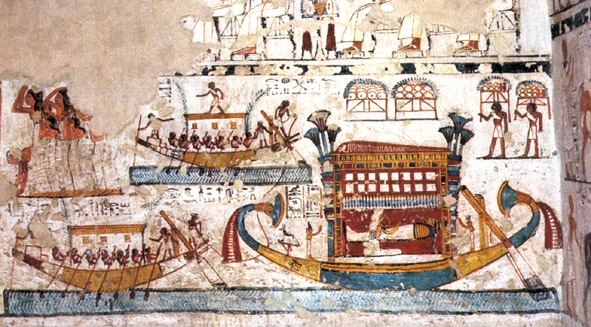
Tomb of Simut (Kyky),
official of Pharaoh Ramesses II ca. 1279 - 1213 BCE.
Funerary voyage by flotilla of Kyky to Abydos.
The core of consciousness is believed to be the light
of the imperishabe stars, and the ultimate expression of consciousness was
the station of the "Akh" or light-spirit, the spirits of the gods,
goddesses, ancestors and blessed deceased, the company of stars. The
return to this ultimate abode of the enlightened ones was the funerary
goal of Egyptian religion. The core of consciousness is awareness, the
capacity of consciousness to be aware of itself.
Atum-Re : the awareness
of consciousness of itself : What ?
Bark of Re : the
extension of consciousness : How much ?
Horus : the identity of
consciousness : Who ?
Pharaoh the magician, Horus and son of Re, is
ultimately protected (as the sailor on his bark), because he is able to go
to and return from eternity-in-everlastingness, i.e. the eternal
repetition
associated with his father Atum, the soul of Nun "Who-bore-Atum".
He returns to neheh-time without loosing consciousness
(avoiding the drop to merg with the ocean by representing the ocean in the
drop). This dialectic between heterogeneity (consciousness) and
homogeneity (unconscious), between order ("maat") and chaos (cosmic as
"Nun" and moral as "isefet"), between a "good Nile" and social ruptures, is
fundamental to understand Ancient Egyptian civilization in all its
aspects.
"TO BECOME A MAGICIAN.
O you nobles who are in the presence of Lord Atum, behold, I have
come to you !
Fear me in proportion with what you know !
It is I whom the Sole Land made before there came into being the
two meals on Earth ; when he sent forth his sole eye ; when he was
alone, going forth from his own mouth ; when his million Kas were
there, the protection of his companions ; when he spoke with Khepri, with
him, over whom he rules ; when he took Hu upon his speech.
It is I who am the very son of Who-bore-Atum, born before he had a
mother.
I am under the protection of the command of the Sole Lord.
It is I who give life to the Ennead.
It is I who act as he pleases, father of gods, lofty of standard, who
make the gods effective in accordance with the command of Who-bore-Atum.
The august god who eats and speaks with his mouth.
I have kept silence, I have bowed down, I have come shod, O Bulls of
the Sky, I have seated myself, O Bulls of Nut, in this my dignity of
'Greatest of Lords of Kas'.
Heir of Atum !
I have come, so that I may take possession of my throne and that I may
gather unto me my dignity, for all was mine before you came into being,
you gods. Go down upon your haunches ! For I am a magician !"
Coffin
Texts, spell 261 (III, 382 -
389), Middle Kingdom (ca. 1938 - 1759 BCE) - text in coffin of Asyut
(Cairo 36444) and in inner coffin of Msht (Cairo 28118) - hieroglyphic
text in
Buck 1935-1961, my italics.
Psychologically, with every day that goes by, consciousness grows more
complex. To sustain its evolutionary momentum, total oblivion (as it were merging with the collective unconscious)
should be avoided. Awareness, identity and extension need to be vigorous,
strong and healthy. Re
rejuvenates because he unites with the principle of his own physical
existence, the being of consciousness, represented by Osiris, the one resurrecting in his mummy, in
the material, outer form of his subtle, invisible, inner "noble body" of
resurrection, the "sah".
At this point, in the Sixth Hour of the Duat, the
soul of Re enters this "sah" of Osiris, and a remarkable
rejuvenating singularity is
established : the drop (the soul of Re) contains the ocean (the "sah" of
Osiris, the "king of the netherworld", never leaving the night).
Before this point, the forces of the netherworld were depleted and
joyfull to be rejuvenated by Re's coming. In a way, this aged Re even more, who
enters total silence (differentiation of Re's power). After the point of singular
conjunction of the awareness of consciousness (Re) with the divine being
of Nature itself (Osiris), as it were allowing Re to harvest the
infinite, autogenetic power of Atum outside the natural order, the
deities receive
"new clothes" and may participate in the regenerative power acquired by
Re (integration of Re's power).
So in the Sixth Hour of the Duat, when the deepest and darkest point of the night
is reached, Re (conscious awareness) steps outside of his normal habitat (the
natural realm of conscious awareness) and becomes one with the unconscious abode of
the Moon-god, who represents the unaware being of Nature itself
(consciousness included). This conjunction of Re and Osiris causes
new forces to pour into conscious existence, whereby new vigour is granted
and rejuvenation initiated.
This point of singular conjunction, achieved by entering the "Cave of Sokar" (Fifth
Hour) and being encircled by the five-headed serpent "Tail-in-Mouth"
(Sixth Hour) preludes a creative, vitalizing movement. This may be stopped by
the mighty serpent of evil, Apep, who gulps down the spiritual Nile and
leaves the Solar Bark on the sand (Seventh Hour). In this Hour, all could be lost, and the
dawning of the new, rejuvenated awareness could be hindered, bringing eternal
darkness (the disruption of the eternal repetition of dawn). But because the principle
of evil (represented by Set) has been vanquished (cf. the Osirian cycle),
the "Eldest Sorcerer" himself is called in to cancel the forces of evil, giving
new impetus to the movement of the Solar Bark (for (-1) x (- 1) = + 1),
integrating all divinities before he finally dawns.
In what follows, the Book of the Hidden Chamber will be studied
from various perspectives.
In Section 1, the historical, philological, schematic, thematic and
lexicographic features are considered. Relevant passages of the Amduat will be translated.
In Section 2, the paraphysics of creation comes to the fore.
The Ancient Egyptian view is confronted with contemporary cosmology,
quantum physics and chaos theory.
In Section 3, a Jungian approach clarifies the meaning of the process of
the Duat in terms of the dynamics of the psyche, in particular the
equilibrium between conscious and unconscious. How can consciousness
complexify (individuate and acquire superconsciousness) thanks to a
healthy daily approach of the archetypes ? The magical interpretation will focus on the role of the
instantaneous instant of conjunction and the way this projects
consciousness outside the natural cycle of events to swing back into
phenomenal reality empowerd by a sharp increased of one's awareness and creative energy-potential,
to be used with regard to every thing created. The practical applications of this
knowledge to be "a man of eternity" ("s n nHH") or an "immortal". Every
Hour and/or series of Hours contains ritual information,
depth-psychological individuating insights and spiritual techniques to be
used in healing, balancing-out, enduring creative process and unending
spiritual growth.
The central theme of this work, the Midnight Mystery, exceeds the
boundaries of egyptology as well as the philosophical study of Ancient
Egyptian thought. For to fully circumambulate it, speculative thought
(metaphysics) has to be called in. Care has been taken to back
the present attempt at reconstruction of Ancient Egyptian thought with
historical data and to translate the preceived Egyptian pattern or canon
to the best of my abilities. Although ante-rational thought has a wide
span, it lacks decontextualized categorization. So the rational
reconstructions involved are mine alone. Where such abstraction and
theoretical constructs are used, the broader context and scope of my
philosophical
investigations are presupposed, in particular,
postmodern logic,
methodology and
neurotheology.
1 A short history of Ancient Egyptian royal funerary ideas.
It took
Lehner (2001)
many decades to finish his study on the complete pyramids of Egypt. Were all
mysteries solved ? Certainly not. Their daring architecture continues to baffle
us. Moreover, the fundamental text on the history of the architecture of
prehistoric Egypt has yet to be written ! In most cases, its would-be authors
would have to limit themselves to the results of contradicting archeological
studies. Indirect sources would be the best ground data available. But there is
reason for optimism.
"The incredible amount of quality
excavation and survey over the Nile Valley has allowed a very good picture
of predynastic material life to emerge. With aid from hieroglyphic
writing, early Dynastic religion, and other historical sources, cognitive
interpretations must be made using the same artifacts which have been used
for only material ends in the past. As mentioned earlier, this is
beginning to take place in Egyptian archeology." -
Czerwinski, 1995,
p.39, my italics.
The present outline is a summary of the evolution of Ancient Egyptian
funerary ideas put into evidence by royal burials, starting in the Early Dynastic
Period and leading up to the decoration of the burialchamber with
the Book of the Hidden Chamber, "presented in the
form of a huge papyrus unrolled on the walls" (Lamy,
1981, p.89). In the course of this long period, we witness :
-
a thinking
tradition : Pharaonic civilization was
verbal (let it be said) and
textual (let it be
written). Although writing, as in Mesopotamia, developed hand in hand with
economical and administrative persuits, the
deification of hieroglyphic script (and its co-relative eternalization of
spoken words carved in stone or painted on the walls of dark tombs) contributed
to the survival of important literary texts.
"... the primary purpose of literary composition was to
maintain life, whether that of the gods, of the king, or of mankind generally."
- Gardiner,
1938,
p.168.
These (and how many are lost ?)
reflect the multi-layered approach of Egyptian
ante-rationality and the thinking tradition of the
scribes & the priests of the House of Life, an institution of knowledge
initiated in the Old Kingdom. As death was viewed as the door
to more life, a rich
funerary literature ensued, stretching from the simple Offering List, to the elaborated
Heliopolitan Pyramid Texts, followed by the Coffin Texts, the
Book of the Dead and the New Kingdom Books of the Netherworld ;
-
interiority : at first, in the
Old Kingdom, Pharaoh was the only person with an "inner life" (a "Ba").
Ethics was defined in terms of proximity to Pharaoh and his residence (in the
Old Kingdom, only the Memphis area exemplified the "canon"). Ordinary humans hid
in the Beautiful West of the Netherworld, while Pharaoh flew to the sky ! This
notion was left behind, as was the Pyramid Age, itself embroidered with myth. In
the Middle Kingdom, the feudal monarchs hoped to
become "an Osiris" in the afterlife. Everybody had a soul ! Funerary
rituals called for the correct spell to master the trials awaiting each
particular deceased. Ethics was represented in terms of the weight of one's
heart, i.e. mental states, conscious intentions, acts of will. These are to
balance the feather of truth and justice (Maat), or no justification before
Osiris is possible, no resurrection. Without the latter (by Osiris) there can be
no ascension (to Re). The heart is eaten and one's personal identity is for ever
lost. In the New Kingdom, with the advent of
internationalism, imperialism and the
New Solar Theology,
personal spirituality is added to the picture. Everybody could take "god in the heart".
Had Akhenaten not forced them to do so ? Amun
listened to all prayers and his divine will decides, nothing else ;
-
centralization :
the unification of Egypt under the "Followers of Horus" ended centuries of
Predynastic divisions. This political event was translated in theological terms
and although Pharaoh was the institution of Egypt's unity,
Amun-Re would become the "king of the gods" and eventually, at the end of the
New Kingdom and later, the true Pharaoh.
1.1
From Early
Dynastic tombs to the Pyramid Texts.
On the one hand, shamanism regards the human
skeleton as the enduring within man. Of a deceased human being, an architecture
of dead bones is left. Fossilized, they are traceable for millions of years,
nearly everlasting. The skeleton is the ultimate fixation of individual imprint. Take
away the skeleton, and no identification is possible (of age, gender, physical
health, cause of death). On the other hand, when the transitional nature of the
skeleton is emphasized, this static approach is superceded. Representing a door
to the afterlife, the ever laughing skeleton detains the secret of death, the
hidden knowledge of things beyond our current, physical situation. By contrast,
it points to the spiritual dimensions of existence, to a better world beyond the
tomb. By extension, the skull itself became a metaphor of perennial wisdom and
the dark, deep secrets of the highest initiations. This knowledge also implies
danger, for who wants to know and die before his or her time has come ? Is there
something after death ? Nobody escapes the inevitable nature of this question.
The skeleton reminds us that in the last hour of life we are all equal. Even the
Egyptians, passionate with life, realized the futility of trying to escape death :
"Follow you heart and your happiness.
Do your things on Earth as your heart commands !
When there comes to You that day of mourning,
the Weary-hearted {Osiris} hears not their mourning,
wailing saves no man from the pit !
Make holiday,
do not weary of it !
Lo, none is allowed to take his goods with him !
Lo, none who departs comes back again !"
Song from the tomb of Intef,
Middle Kingdom.
The Neanderthals probably performed the first funerary rituals. Flowers were
placed on the corpse before it was enterred. The sense of desolation and the
horrible emotions the loss of a loved one entails, was accommodated by rituals.
To those left behind, they gave meaning to the event beyond the severing of all
physical ties. They also assisted the deceased to cross the limbo and reach the
afterlife well protected. Once arrived, the spirit was liberated and could intercede for the
community it had left. Especially the Cro-Magnon developed a rich funerary
symbolism. It was believed the deceased would benefit from the presence of grave
goods. These were physical symbols of the expected afterlife.
Indeed, the discussion whether the
Homo Neanderthalensis had religious awareness, circumambulates the status of
entombed objects other than the actual physical body of the deceased.
Distinct floral offerings have been found in late Neanderthal graves, and other
evidence suggestive of their religious awareness of death. In the brain of the
late Homo sapiens (ca. 500.000 - 30.000 BCE), so
neurotheology
suggests, an exclusively limbic spiritual sense may have been computed. But,
elaborated symbolism is typically Cro-Magnon (ca. 100.000 - 10.000 BCE),
requiring an angular gyrus and a developed prefrontal cortex to process the more
abstract variables.
These data point to the high potential of humans of the Upper Palaeolithic. They were equipped with hundreds of tools, lived in complex social
networks, spoke a common language and shared crucial symbols, covering
agricultural, procreational, magical and religious issues. The way of the
paleontologists who identify the start of history with the presence of cultural
forms gains ground. Writing is not the first signal of symbolized cognitive
activity. Nevertheless, as Derrida has recently again underlined, the beginning
of logocentrism and its adjacent mummification of the spoken language in writing
is fundamental to objectify knowledge (and detrimental to understand thought).
As such, the simultaneous rise of hieroglyphic writing and Egyptian kingship is
to be noted.
► Predynastic graves & mounds
In Egyptian funerary rituals, the tomb
was a dark, underground structure, dug out in desert sand or rock and completed
with offerings to accompany the dead. Throughout human history and next to
burial, various methods to dispose of the corpse have been invented ;
exposure to the sea, a Viking rituals practiced on the open seas,
dismemberment practiced by the Tibetans and burning common in India. But in
Homo sapiens sapiens burials, offerings are a cultural constant. This would
remain so during the Neolithic and Predynastic Periods.
In the Predynastic millenium (ca. 4000 - 3000 BCE) preceding the Pharaonic Period (ca. 3000 - 30 BCE), the tombs
were simple holes in the ground, with wooden walls and mats. Little is known of
what was on top of them, and so scholars hesitate to categorize these
constructions as funerary architecture. On the outside, a mound of sand or
gravel or perhaps a simple wooden construction may have served as a marker. Most
Predynastic corpses were completely dried out because of the desert sand. Was
this a prefiguration of the Pharaonic practice of removing all fluids with
natron (during mummification) ?
From Naqada II (ca. 3600 - 3300 BCE) onwards, highly differentiated burials are
found in cemeteries in Upper Egypt. These élite burials contained large
quantities of grave goods, with exotic materials such as gold and lapis lazuli.
These burials point to an increasing hierarchical society and the wish of the
deceased to keep their status in the afterlife !
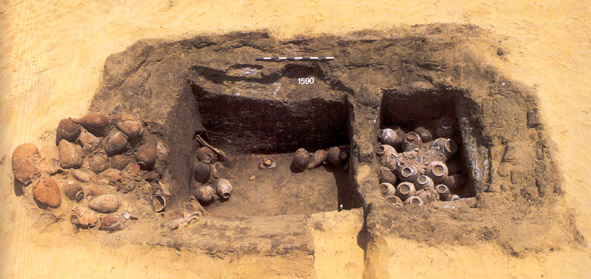
Naqada III tomb
- Minsjat Abu Omar - Eastern Delta - ca. 3300 BCE.
First seen in the Amratian culture, there was, during the second phase of
the Gerzean culture, a distinct acceleration of the funerary trend, whereby a few individuals were buried in larger,
elaborate tombs, containing richer and more abundant offerings (cf. the Painted
Tomb at Naqada).
These Gerzean cemeteries develop a wide range of grave types, ranging from small
oval or round pits, poorly provided, to burials in pottery vessels and
rectangular pits subdivided in partitions (to put the funerary offerings). There
were coffins of wood or airdried pottery, and indications of the wrapping of the
body in strips of (expensive) linen (cf. the Double Tomb at Adaïma near
Hierakonpolis). Various burial-sites appear, and also the richer tombs of the
chieftains, the predecessors of the Pharaohs.
"In the Neolithic period the dead were desposited in oval
graves in foetal position, with the head at the south. In Lower Egypt the
deceased was placed on his right side, his face turned towards the east, while
in Upper Egypt, as all along the upper Nile, the dead person was placed on his
left side, looking west. Often the body was wrapped in a cloth or an animal
skin, the head resting on a cushion." -
Lamy,
1981, p.27.
On the treshold of the First Dynasty (ca. 3000 - 2900 BCE), the graves of the
rulers and the élite consisted of neat mudbrick boxes, sunk in the desert and
divided, like a house or an imitation palace, into several rooms. The tombs of
the first Pharaohs followed this pattern, but with increased complexity.
Situated far out in the desert near the cliffs at Abydos, they were marked by a
pair of large stelæ and covered by a mound. These mounds of sand and gravel can
be traced back to the modest pit graves. The pyramid form is deemed an
elaboration of this architecture, itself rooted in the myth of the primordial
hill emerging out of the eternal "zep tepy". This "risen land" is the "first
land" to come into being (in phenomenal time).
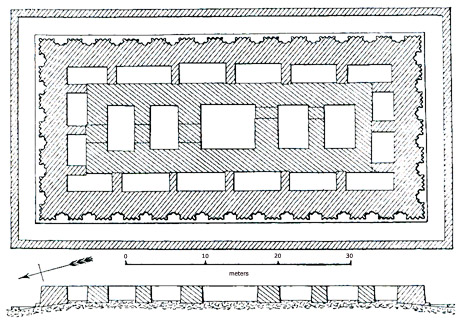
Palace façade
style mud-brick tomb - Queen Neithhotep - First Dynasty - ca. 3000 BCE
The burialchambers were incorparated at ground level -
Wilkinson (1999).
► the advent of
the dual kingship
At Naqada, Abydos and Hierakonpolis, the end of the Naqada II phase brings
separate political centres to the fore. At the end of Naqada III, we witness a
new style of "royal" burial. The first hieroglyphs appear.

Predynastic
names of kings - Names not to same scale -
Wilkinson (1999), p.53.
Egyptian kingship expressed a unique feature :
the harmony or equilibrium of opposites. The dual nature of the
monarchy was all-comprehensive and reflected in the regalia, in the
royal titulary, in the royal rituals and festivals.
Frankfort (1948)
called the presence of Pharaoh and his institution of "transcendent
significance". It was a unique phenomenon in the region, if not in the
world. Other civilizations of Antiquity had remained fragmented and
political unity was foreign to them. Centuries of political
centralization, administration & economy were unknown to them. The crucial
outstanding feature of the Egyptian solution was to institutionalize
Pharaoh's dual nature : he was the Lord of Upper and Lower Egypt, as well
as human and divine. At first, in the Early Dynastic Period, the
Falcon-principle inherent in Horus (the sky-god) was deemed to incarnate in each king.
Later, in the Old Kingdom, Pharaoh was the son of Re, i.e. the
sole divine being abiding in full on Earth (the Akhu or spirits of the deities
remain in the sky and only send their doubles and souls). His mythical
counterpart was Osiris, the "king of the netherworld".
This crucial witnessing quality of the "great house" ("pr-Aa" or
Pharaoh), associated with the images of the watchful and surging Falcon
and the mighty and fertile Bull (cf. the consort of the great goddess), help to explain the centrality of the
institution to Egyptian culture and the longevity and endurance of
Pharaonic principle, form and canon. The end of the fragmentation of
prehistory, the "chaos" to which no return was possible, and the advent of
hieroglyphic writing, would eternalize the new Pharaonic, political
ideology : the king oversees the "Two Lands", is the sole Lord
of the Dual Kingdom, and this in order to keep Upper and Lower Egypt
together and united while always defining them as distinct. This
activity keeps the balance of Maat in equilibrium ; the daily
voice-offer of Pharaoh to the creator-god Re (for like Ptah, what Pharaoh
says, is done - cf. the
Memphis theology). This
offer maintains creation and causes a "good Nile". This
Egyptian symmetry or play of equilbria, verbal, visual and written, utilizes the duality
of opposites as part of a careful strategy to master the whole. The power
of pairing lies in the combination demarcating and underlining a greater
unity.
Thanks to the presence of Pharaoh, the cycle of the natural
order may be transcended through a witnessing consciousness, a Self
participating by :
-
the use of its inherent overseeing capacities (in the
sky) -to keep dynamical divisions united- and
-
a strong, creative output (on Earth), to engage other
people in community-building activities. These works make the natural
order and its dynamical equilibria endure for "millions of years" ...
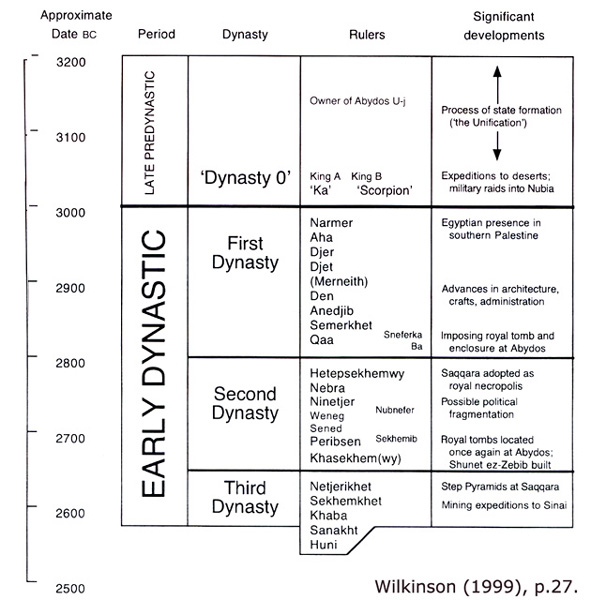
Late Predynastic
and Early Dynastic Chronology
► the royal tombs
With the arrival of the institution of kingship, a "royal" funerary cult came
into existence. The Pharaohs of the First Dynasty were buried at Abydos (the
cult place of Osiris), an indication of the Upper Egyptian origin of the
Egyptian state. From these beginnings, the institution of kingship was strong &
powerful.
The superstructures of the first royal tombs at Abydos were simple mounds of
sand held in place by a mudbrick revetment. Scholars conjecture the burial mound
recalls the primeval mound which emerged from the waters at the time of
creation. The mound is Solar, and refers to the first ray of Re shining on the
first day after the waters receded. In the tombs of Pharaohs Den and Adjib
(First Dynasty, ca. 3000 - 2800 BCE), the entrance stairway approaches the
burial-chamber from the East and the rising Sun. The symbolism speaks for
itself. Like the rising Sun, the king will rise up to the sky.
In the tomb of Pharaoh Qaa, who closes this dynasty, a change to a northerly
orientation is effectuated (and maintained thereafter). The entrance corridor is
a large ramp pointing northwards toward the circumpolar stars ("ixmw-sk" or "the
ones that know not destruction"). Funerary ideology became stellar. The pyramids
reflect a stellar ideology made possible by the local horizon delimiting the
cycle of the Sun. They are made to assist Pharaoh on his celestial voyage to the
stars.
In these ideological considerations, the change from mastaba to step pyramid,
from primordial mound (of the Sun) to celestial ladder (to the stars), reflects
the increased importance of the celestial, stellar terminus of Pharaoh, the
divine king. The influence of Re rose and a pre-rational and Heliopolitan
henotheism saw the light. Its core consisted of Re and his son the king, ruling
the pantheon and creation. But by the end of the Vth Dynasty (ca. 2487 - 2348
BCE), Osiris had become the "second player" in funerary theology and the
unsettling tension between the "duat", the netherworld, and "pet", the
sky, was left unresolved. In some mysterious way, Osiris' Field of Reeds and
Re's Field of Offering were adjacent salvic conditions with conflicting
ontological features (prefigurating the Christian distinction between
"purgatory" and "heaven" ?).
Although the tombs left by the kings of the Early Dynastic Period are monumental
in size, they do not approach the scale suddenly emerging in the IIIth Dynasty
(ca. 2670 - 2600 BCE), under Pharaoh Netjerikhet or "Djoser" (ca. 2654 - 2635
BCE) and his grand architect Imhotep.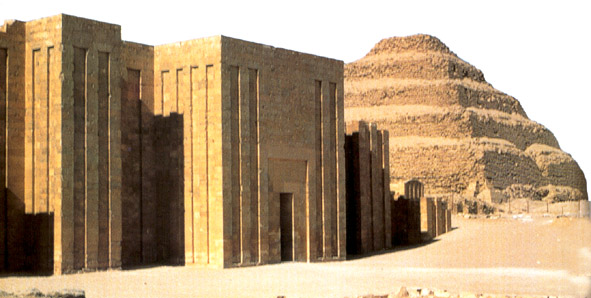
Pyramid of
Djoser and part of its surrounding enclosure wall.
"The Step Pyramid
of Djoser heralded the classic pyramid age, the 4th to 6th dynasties, also known
as the Old Kingdom. During these centuries the Egyptians built pyramids for
their god-kings in a 72-km (45-mile) span of desert, between Abu Roash,
northwest of Giza, to Meidum in the south, near the entrance of the Fayum.
Excluding the pyramids of Djedefre at Abu Roash and Sneferu at Meidum as
outliers, the 21 major Old Kingdom pyramids stand like sentinels in a 20-km
(12-mile) stretch west of the capital the 'White Walls', later known as Memphis,
clustering at Giza, Zawiyet el-Aryan, Abusir, Saqqara and Dahshur." -
Lehner,
2001, pp.14-15.
The Step Pyramid represents a significant leap in architectural size and
sophistication. A limestone wall, 10.5 m high and 1.644 m long, contained an
area of 15 ha (then the size of a large town). This is the barrier between the
outer world and the domain of the god. The complex, with functional and
dummy buildings, large terraces, façades, columns, stairways, platforms, shrines
and life-seized statues, reflected the dual nature of the afterlife : the
half-submerging dummy buildings "must have signified the
chthonic, underworld aspect of existence after death" (Lehner, 2001, p. 84), while the Step Pyramid itself, rising in six steps to
a height of ca. 60 m, reflects the route of celestial (stellar)
ascension/descension taken by the Solar Pharaoh after he died, was mummified and
entombed. Even after death, Pharaoh was still "at work" in his tomb,
which is a stairway to the sky. This depicted the fundamental duality of the
afterlife : on the one hand, the Lunar underworld ("Dwt", "Duat") and, on the other
hand, the Solar sky ("pt", "pet"), the "imperishable" circumpolar stars
(Alpha Draconis rather than Alpha Polaris), about 26° to
30° above the northern horizon in the area of the pyramids.
|
Lehner,
2001, p.19 |
DJOSER type |
MEIDUM TYPE |
|
Orientation |
North - South |
East - West |
|
Parts |
N - S sequence |
E - W axial
symmetry |
|
Enclosure wall |
niched,
no inner wall |
smooth outer
wall,
at times niched inner wall |
|
Entrance |
South end of
East side |
Centre East side |
|
Ka tomb |
South tomb, no
satellite pyramid |
Satellite
Pyramid |
|
Temple |
N or S temple |
E temple, N
entrance chapel |
In the reign of Pharaoh Sneferu (ca.
2600 - 2571 BCE), the first Pharaoh of the IVth Dynasty, radical changes in the
overall plan of the Pyramid complex happened. A new form was sought. The royal
tomb altered to a true pyramid. A new orientation was applied (the main axis of
the complex was now from East to West instead as the previously North - South
direction), and the mortuary temple was built against the Eastern face of the
Pyramid (Djoser's is to the North). It was linked by a causeway to a valley
temple, close to the edge of the cultivated area further to the East, which
provided a monumental entrance to the complex as a whole ... This standard
so-called Meidum-type arrangement was amplified by the gigantic Giza complex of
Pharaoh Khufu, and remained unchanged throughout the Old Kingdom. Only in
the Middle Kingdom, when the earliest Meidum-type were fading into ruin, did
pyramid builders return to the basic elements of Djoser's complex, with a long
North - South rectangular enclosure, defined by a decorated wall with a single
entrance at the far South end of the East side.
During his reign, Pharaoh Sneferu
finished in half a century three giant pyramids at Meidum and Dahshur. But the
largest pyramid, 146.59 m high, would be built by his son Khnum-khuf ("Khnum is
his protector"). The only known figure of him is a tiny figurine around 7.6 cm
high with his name on its throne !
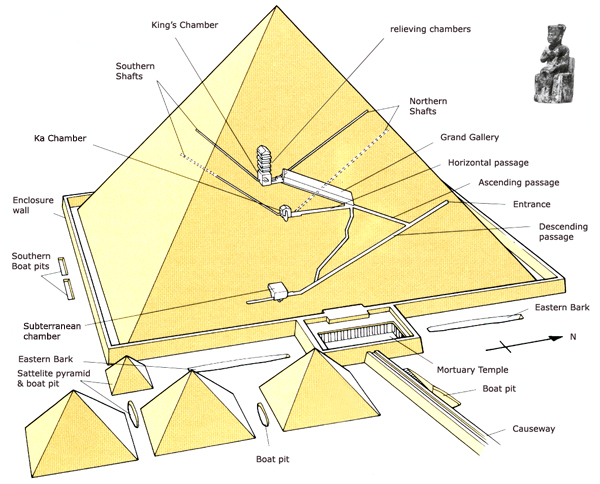
Plan of the
Pyramid-complex of Pharaoh Khufu (ca. 2571 - 2548 BCE). The northern ventilation
shaft pointed directly to Alpha Draconis, the Pole Star. But once every 24
hours, the three stars in Orion's belt passed at culmination above the southern
ventilation shaft of the burial-chamber ; a combination of the myths of Re and
Osiris.
Even if we allow Pharaoh Khufu (ca. 2571
- 2548 BCE), a reign of 30 to 32 years, his workers and builders would had to
set in place 230 m³ of stone per day, i.e. a rate of 1 average-size block of 2.5
tons every 4 or 6 minutes (working in day and night shifts), to finish his
pyramid, causeway, two temples, satellite pyramids, three queens' pyramids and
official's mastabas (a combined mass of ca. 2.700.000 m³). Although this king
did not equal his father's total mass of monuments, he surpassed his pyramids in
sheer size and accuracy. After a few failures, the principle of pyramid-building
had been mastered and the building of the king's tomb became state policy.
The base of the Great Pyramid
(containing about 2.300.000 blocks of stone weighing on average ca 2.5 tons) is
level within 2.5 cm (290.33 m) with an angle of slope of 51°50'40", the average
deviation of the sides from the cardinal points is 0°03'06" degrees of arc and
the greatest difference in length of the sides is 4.4 cm. The pyramid alone
covers 5.3 ha. The finished pyramid was surrounded by a 8m Turah limestone wall.
The Great Pyramid has three chambers. : a King's Chamber for the
sarcophagus and the royal mummy, near the western wall ; a Ka chamber with the
statue of the king, the so-called "Queen's Chamber", never intended for the
burial of the queen and the Subterranean Chamber, 30 m below the plateau
surface, reached by a Descending Passage cut straight into natural rock. Some
think the lower chambers were "mistakes", while this seems unlikely (in view of
the triune architecture of royal tombs, with burialchamber, antechamber and
Ka-chamber). What is typical for these "Stellar" pyramids of Sneferu (Bent Pyramid
as well as North Pyramid) and Khufu is the elevated position of the King's
Chamber. In both, the funerary symbolism is clearly celestial. The expanse of
the sky was celestial Nile, with banks on the West and on the East.
The Milky Way was called "the beaten path of stars" and paradise was invisioned
as the Nile Valley at inundation : the Field of Reeds (Osiris) on the eastern edge and
the Field of Offering (Re) further North.
By elevating the King's Chamber, the architects of the Great Pyramid underlined
the celestial goals of Solar Kingship, and, by doing so, made it possible for
him, the "son" of Re, to unite with the celestial, stellar corpse of Osiris,
associated with the Orion constellation and the star Sirius (the Southern
shafts). By the bright appearance of the Dog-star in the dawn sky in July, the
annual Nile inundation was heralded. This star, associated with Isis, was called
"the Bringer of the New Year and the Nile flood". Osiris, the brother and
husband of Isis, was identified with Orion : the announced renewal of life by
the heliacal rising of Sirius, entails the blessing of Osiris, the vegetation
god. Moreover, the Ba of Pharaoh Khufu, son of Re, could rise in its "sah"
("sAH", "noble") and
be transformed into an "Akh" ("spirit") helped by Osiris and Isis in their stellar,
celestial form (in the South), and so rise to his final destiny : the
Imperishable Stars.
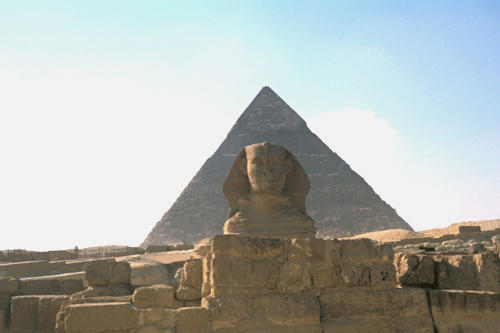
The Great
Pyramid with Sphinx
In this remarkable architecture, we may "read" the same
ambiguity, apparent in the Pyramid Texts, between the sky of Re ("pet"),
creator of the deities and the universe, and the netherworld ("duat") of Osiris,
its king hidden in the darkness of the subterranean
world ; between, on the one hand, the royal Solar/Stellar prerogative and, on the other hand,
the influence of the popular (Lunar and Predynastic ?) Osiris, with whom
eventually (in the Middle Kingdom), every deceased would identify. The Pharaohs
of the IVth Dynasty (ca. 2600 - 2487 BCE) emphasized the Solar component of
divine kingship, the direct manifestation of a deity on Earth, but Heliopolitan
theology tolerated (even incorporated) Osirian thematics, albeit insofar as these notions help to secure the
celestial terminus of the deceased king, a son of Re returning to his father.
► Osiris and the
stellar function of the pyramid
Since time immemorial, Osiris and funerary ritual were linked.
Although the origins of Osiris remain unclear, we speculate he was a "tribal
ancestor". Predynastic Egypt was a multiverse of deities and their communities.
In each small town, the sphere of activity of the "divine inmate" of the area
(or "nomes") encompassed the entire range of communal intrests. The kingdom of
Osiris represented, ex hypothesi, the mythical "golden age" of Egypt, before writing and
the advent of kings who
alienated their divine power by patrilineal transmission. In the mythical age of
Osiris,
the rule of the great Lunar goddess was absolute, as it had been in the
Neolithic and before (cf. the Cro-Magnon of the Upper Palaeolithic). In
Predynastic Egypt, the rulers and kings received
their power directly through the great goddess. The king was her consort.
Because of this connection, the "Bull of his mother" evidenced male power,
fertility and abundance. In the Osiris myth, the role of Isis is crucial. She
brings the scattered parts of Osiris' body together, is able to trick Re,
receives the assistance of the Lunar Thoth, conceives Horus, is able to raise &
protect him etc.
The advent of history changed this situation. In the Early Dynastic Period, the
king figures as an incarnation of the sky-god Horus. The royal nation state is
given administrative body. In the Old Kingdom, the divine king affirms the
divine status of his "Ba" by partly assimilating the Lunar deities. A patrilineal
system is invented, lasting for more than three millenia and based on Solar and
stellar considerations. Nevertheless, in the Egyptian cultural form, the Lunar, contextualized,
wandering, matriarchal line of transmission (of which the original is rooted in
the Upper Palaeolithic) is never relinquished. Without the female side of
Nature, no balanced equation is deemed possible. Pharaoh is nurtured by the milk
of the goddesses and in all major dynastic turns, the role of women was of
extreme importance.
Pharaonic Egypt remembered the mythical family of (Lunar) Osiris, his wife Isis
and their son Horus. People identified and played the dramatic episodes of their
lives, including in their musings his assassination, dismemberment, restoration,
resurrection and rejuvenation. The mystery of his becoming the "king of the
netherworld" completed the picture. Whether Osirian faith was already popular in the Early
Dynastic remains disputed, although a Predynastic origin of Osirian faith
concurs with the fertility cults of the Neolithic (the "Bull of his Mother"
pointing to his role as consort of the great Neolithic fertility goddess), both
agrarian (grain, flood) as communal (just ruler).
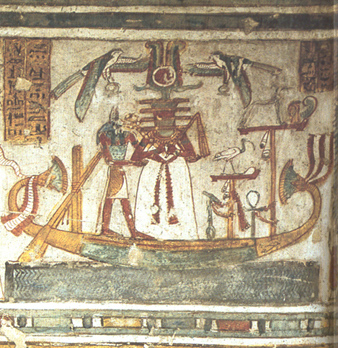
Tomb of
Neferrenpet - Thebes - XIXth Dynasty - ca.1250 BCE.
Osiris as Djed-Pillar with Anubis and Thoth (as Ibis).
The "djed" (or "djet", "tjet") may point to a crucial link
between history and prehistory : this backbone of Osiris
serves as a mortuary amulet of stability and everlastingness. It is a necessary aid
in the transformation of the human body into the spiritual body of glory assumed
by the dead in the afterlife. With it, the shamanistic beliefs of old are
maintained but refined. The divine dead bone is there to transmute. The
restoration of the body of Osiris and his "resurrection" in the noble, spiritualized,
beautified and stellar body ("sAH"), given by Isis thanks to Re and
Thoth, is completed when Osiris receives the
Eye of Wellness (the
Left Eye) from Horus, the
Lunar Eye of Re. Restored, resurrected and resuscitated, Osiris is then the
"king of the netherworld".
The
"djed" Pillar Festival was held annually. It was a time of enthusiasm and
rejuvenation for the people. On the first day of Shomu, the season of
harvesting, the priests raised up the "djed" Pillar, and all payed homage
to the symbol. People conducted mock battles between good and evil. Oxen were
driven around the walls of Memphis ...
"Although the god Osiris is not attested by name until the
Fifth Dynasty Pyramid Texts, the probable antiquity of many of these texts makes
it not unlikely that he was recognized at an earlier period, perhaps under the
name Khentiamentiu. A central element of the later Osiris myth, the pairing of
Horus and Seth, is attested from the middle of the First Dynasty." -
Wilkinson,
1999, p.292.
The majority of cemeteries were situated to the West of the Nile, the region
where the Sun set. Already in the Neolithic, the West was the principal mortuary
direction. Deceased Badarians faced West (ca. 5000 - 4000 BCE). The Solar
horizon had been assimilated. The steady rise of kingship and piecemeal
centralizations followed. Dating to the Late Predynastic Period, Khentiamentiu,
"the Foremost of the Westeners", the god of the Abydos necropolis, was depicted
as a jackal. He also navigated Re's nightly voyage in the Duat. His cult was
popular in the First Dynasty (cf. seals of Pharaohs Den and Qaa) and in the Old
Kingdom, Heliopolitan theology associated him with Osiris, who also bore the
epithet "the Foremost of the Westeners". We have to wait until the First
Intermediate Period before Abydos has become a cult centre explicitly dedicated
to Osiris.
In the Heliopolitan account, Osiris belonged to the last generation of deities,
those sustaining the mythical kingdom of plenty of Atum-Re, the sole, unique
creator of it all. Osiris, Isis, Seth and Nephthys are the differentials or
natural types covering the ideal state of affairs for human beings. Osirian faith
appealed to the common majority.
"The four children of Geb and Nut are not involved in this
description of the universe. They establish a bridge between nature and man, and
that in the only manner in which the Egyptians could conceive such a bond -
through kingship. Osiris was the mythological form of the dead ruler forever
succeeded by his son Horus." -
Frankfort,
1978, p.182.
As the "Bull of his mother", he represented the
myth of the "perfect king", empowered not by patrilineal logic, but by the
self-possessed and unalienated power of the great goddess and her dark secrets
of resurrection, rejuvenation and rebirth (associated with the Duat rather than
the sky). His assassination by Seth evokes the discontinuum of moral evil
("isefet"), rooted in a natural divine will to harm, hurt and
cause suffering for the sake of dominion, love of power and the persistent
gratification of perverse desires (cf. the Isis & Horus cycles of the Delta). It
underlines the power of evil and destruction, and invokes the fragility of life
and order, in all directions under seige by evil, annihilation, death and chaos.
The tragedy of evil's power does not lead to pessimism, for in Egyptian thought,
the soul of chaos is the author of light, life and order. If chaos itself it to
be avoided, not so its efficient, auto-generative potential. The latter
regenerates the deities and sustains creation.
"But it will be discerned at once that the Osiris myth
expressed those hopes and aspirations and ideals which were closest to the life
and the affections of this great people. (...) In the Osiris myth the
institution of the family found its earliest and most exalted expression in
religion, a glorified reflection of earthly ties among the gods." -
Breasted,
1972, p.37.
Paradoxically perhaps, a pyramid tomb is not an expression of Osirian
faith as profound as the "Heb Sed" or "Sed Festival", in which Pharaoh assumed
the costume and insignia of Osiris, enjoying the same resuscitation by Isis and
Horus. This does not (as Egyptian thought teaches) exclude Osirian components,
connotations or assimilations (such as a subterranean chamber). But the Pyramid
Age was of Heliopolitan inspiration. Pharaoh finally adheres to his own
divinity ("son of Re") and evidences his authority on a gigantic scale. In
the Pyramid Texts, Osiris is present but at times avoided. Pharaoh
passes-by Osiris (and is, as the latter, resurrected in the Duat), but does not
stay in the Duat. As a bird, he flies away to be transformed into a stellar
spirit, joining his father Re in the sky. A strange division is, at times,
maintained between Osiris in the Duat and Re in the sky. In the pre-rational
mode of cognition, such conceptual tensions are left unresolved.
"May You (Pharaoh) split open your place in the sky among
the stars of the sky, for You are the Lone Star, the companion of Hu
(authorative speech). Look down upon Osiris when he commands the spirits, for
You stand far off from him. You are not among them and You shall not be among
them (the spirits of Osiris)."
Pyramid Texts, § 251, utterance
245.
"May Osiris not come with his evil coming. Do not
open your arms to him ..."
Pyramid Texts, § 1267, utterance
534.
More than two thousand years later, we read :
"The gods are in their chapels and the Divine Ennead in
their hall ; the Hidden One (Osiris) is hidden in the Hidden Seat (Edfu as
crypt), and the gods of heaven are in their place above his horizon." -
Kurth,
2004, pp.56-57.
A pyramid was the tomb of a divine king of Egypt,
and so the focus of a temple complex, with a dedicated priesthood and regular
priests, daily maintaining the Ka of the deceased king to gratify its Ba or soul
and clearing a safe passage from and to the tomb. As such, a royal mortuary temple was an
spirito-economic motor, employing people and redistributing goods for the sake
of a spiritual economy of transformation of material offerings into "food" for
the Ka of the king, who would bless Egypt. A funerary complex was also a "false door" or "gate" allowing the enlightened spirit of the deceased (justified to
realize the station of the Akh-spirits) to return as Ba and/or Ka. This divine presence of the spirit in
its tomb on Earth, is always indirect (never absolute). It happens through the
intermediate states of consciousness, such as the Ba and Ka of the divine
son of Re.
The pyramid ensured Maat, the turning of days and seasons, as well as a "good
Nile". How ? It allowed Pharaoh to "transform" ("kheperu") into an "Akh", a
glorified spirit-being of light, effective and equipped in the afterlife.
The pyramid was his way to ascend. Arrived in heaven as an Akh, Pharaoh allowed
his divine incarnation to pass to his son (from Osiris to Horus) and the pyramid
"is better understood as the meeting point of life and
light with death and darkness" (Lehner, 2001, p. 20). It was a "cosmic engine" set in motion after
mummification and the appropriate funerary rituals, bringing the glorified body
("sah") into being (cf. the ritual of "Opening the Mouth").
As an Akh-spirit, the deceased king could choose to bring down his souls and
doubles on Earth. If so, he would use his tomb and mummy as a point of entry
into the physical plane of existence. In this way, the presence of the ancestor
could continue to influence the living.
The names given to the pyramids or associated with them, reflect the crucial
spirito-economical role of royal tombs : "horizon", "radiant place",
"endures", "flourish", "established", "pure", "divine", "perfect" etc.
Indeed, the focus of any tomb, including the
king's, was the "false door" and adjacent "offering place". This imaginal
gate was the point of departure to or return from the netherworld. The success
of this bi-directionality of the justified, blessed deceased in the afterlife (from
the tomb to the sky and back) depended on the funerary rituals, as well as on the
offerings placed in the tomb. During their daily rituals, the priests (endowed
by the son) fed the Ka of his father and placed the sacrifices near the "false door". In
this way, the "lowest" point of the transformational chain would be kept active.
The subtle energy (or "Ka") of the offerings gratifies the Ba and attracts the attention of the Akh, who returns in the
tomb with its "sah", completing the cycle by uniting with the mummy. This ideal of Egyptian religious life was
only attained by the deities
and the justified dead. Pharaoh ascended, while common men hid ...
In short, the royal funerary rituals had two main goals :
-
the transformation into an
Akh-spirit, with enduring ascending/descending functions and
-
the transfer of kingship from the
deceased to the
living king.
► major
changes : the henotheist religion of Re
As Papyrus Westcar puts into evidence, the
beginning of the Vth Dynasty saw major changes in Egyptian religion.
The powerful influence of Re made the first
Pharaoh of the Vth Dynasty (Pharaoh Userkaf - ca. 2487 - 2480 BCE)
highpriest of Re and begotten by Re himself. Re had visited the wife of
Userra, a highpriest of Re. The result was the birth of a divine child.
"In the royal and state temple theology, Osiris is lifted to
the sky, and while he is there Solarized, we have just shown how he also
tinctures the Solar teaching of the celestial kingdom of the dead with
Osirian doctrines. The result was thus inevitable confusion, as the two
faiths interpenetrated." -
Breasted,
1972, p.160.
The popular Osiris and the crucial battle between
his son Horus and Seth, were apparently not ousted from the royal mindset.
On the contrary, his divine family-drama became part of the cycle of the
"Great Re", the overarching & overseeing deity. Osiris became the "Sun of
the night", although an essential tension between both myths continued to
exist throughout the Old Kingdom.
"From the 3th Dynasty we have the evidence for a new
emphasis on a single creator, eclipsing the balance between the good Horus
and the anarchic Seth. The battles of Horus and Seth do no disappear in
the new, classical Egyptian arrangement of divine powers, but they become
a smaller part within the general scheme of a single all-powerful
creator." -
Quirke, 2001, p.83.
The pyramid of Pharaoh Userkaf was built at North Saqqara, close to the
north-eastern corner of Djoser's enclosure. It evidences a truly
substantial re-evaluation of the rigid monumentality of the previous
Dynasty (cf. its small size : side = 73.5m and height = 49m) and less
painstaking methods of construction.
The main surviving architectural achievement of Pharaoh Userkaf was his
temple dedicated to Re, the Sun-god. Six of the seven Pharaoh's of this
Vth Dynasty would do the same in the next eighty years. Re became a state
god and Pharaoh the son of Re. These temples were personal monuments to
each Pharaoh's continued relationship with Re during life and in the
afterlife. The qualities of Pharaoh were transferred to Re. The latter
became a celestial reflection of the earthly sovereign, a notion to be
developed in the Middle Kingdom, when Amun-Re would be called "the king of
the gods" and "lord of the thrones of the two lands".
The funerary ritual was also elaborated, and in the Vth Dynasty, the
Lector-priest, or "Kheri-heb" appears in scenes. He was a specialist, and
master of the mortuary rituals for the royals. He was attended by the
"Heri-shesheta", the "Head of Mysteries".
These developments evidence an increased interiority. This involves
writing to realize its first internal structure : words joined together in simple sentences. Internalization led to the
formation of pre-concepts, i.e. word-images created through imagination
and the interplay of meaningful objective relational contexts.
Subjectivity was expressed as a function of an objective state. The
actions of the "I"-form are objective states which are not yet (self)
reflective. The opacity of the material side of presence prevailed. The
subject has no transparancy of its own.
However, two central natural types
emerge : on the one hand, Pharaoh, his residence and magical power to
assure a "good Nile", and, on the other
hand, the creator-god Re, the "father of the gods", the giver of
life. This is Atum, the
"Ba of Nun", the potential to autogenerate floating in the inert
waters of chaos. Pharaoh, being the son of Re, returns the "right order" to his
father (as the sole god on Earth, he is the only one able to do so). Because he worships his father
properly (effectively), he is blessed by the latter and
receives a "good Nile". Thanks to the tomb, his father may descend from
the sky and assist his son. The dead would thus continue to rule and Egypt
would last for millions of years ...
Because of this emphasis on Re, a constellational henotheism ensued. To
evidence unity, multiplicity is not eliminated. To operate the multiple,
the original unity of the divine is not eclipsed. The various natural
types work together under the overarching order of Re, who is their
beginning and end. Every night they are reborn with him. Likewise, his son
Pharaoh is present in more than hundred temples simultaneously and he
alone effectuates the necessary rituals to make the god find his shrine
pleasant and become united with his statue. Deities only communicate with
other deities. A human coming face to face with the god dies.
► major changes : the
titulary
Changes in the royal funerary rituals had
already been monumentally expressed by Pharaohs Sneferu and Khufu, but under
Khufu's son, Pharaoh Radjedef (ca. 2548 - 2540 BCE), the signs of
far-reaching religious change are visible. Re surpassed all other deities,
even Horus, the sky god and emblem of the "Followers of Horus". Pharaoh
Radjedef, who provided himself with the name "belongs to the firmament",
is the first to bear the name "son of Re" ("sA Ra").
His brother or half brother Pharaoh Khephren (ca. 2540 - 2514 BCE)
incorporated the royal title "son of Re" in his official, royal titulary.
This titulary
("nxb.t") consisted of 5 titles or "rn wr","great names". Each of these express a specific view-point on
kingship. As the
name of someone or something was crucial and all-important for its
survival and effectiveness, the royal name was the "name of names". To
know and understand Pharaoh's names revealed his power in life and to have
one's own name written next to his, guaranteed success in the afterlife.
As the "son of Re", Pharaoh Khephren added a fifth name to his four other
titulary names, thereby expressing the idea of Pharaoh being the human form
of Re at birth, i.e. Re begets Pharaoh, who rules over
Egypt in the former's name.
"From this time onward every king of Egypt, whether
of Egyptian origin or not, called himself the 'son of Râ'. In later days,
when Amen, or Amen-Râ, became the King of the Gods, it was asserted by his
priesthood that the god assumed the human form of a man and begot
the king of Egypt." -
Budge, 1989, p.33, my italics.
The definitive form of the royal titulary was
attained : it began with the Horus Name of the Early Dynastic Period and
ended with the name of Pharaoh at birth (as a prince), preceded by "son of
Re". When enthroned, Pharaoh received a "prenomen", a divine name referring
to Re. Both names were enclosed by an oval ring (suggestive of the Solar
cycle), a cartouche. The "nomen" name is phenomenal. The "prenomen" name
is for all of eternity. This enclosure may be compared with the wall
surrounding the temple. Thus it reflects the Solar horizon of the Sun-disk
and assures the clear distinction between the divine and the profane.
Just as the "sah" is the result of "senetjer" or ritual consecration,
Pharaoh becomes the "son of Re" in actu exercito only after having
received his throne-name. As a prince, he was the son of a divine father,
as Pharaoh he is a Lone Star, the son of the unique creator-god and god of light, Re,
the star of stars. By adding "son of Re" to the birth name, the divine
birth (not yet divine right) of the royal prince was underlined. At his
coronation, he received the "form" of kingship ritually, but his divine
nature was already present at birth, for he was conceived by Re himself.
The five names of the royal titulary, a temporal as well as a spiritual
declaration of divine rule, are :
-
the Horus name, Banner name or Ka-name
:
designating Pharaoh as the manifestation of Horus, the elder sky god
(Horus in the palace, not yet Horus, son of Osiris, although both were
confused), the divine prototype and patron
of the Egyptian kings. The
earliest divine kings, the "Followers of Horus", ruled with this Horus
name alone. In the Early Dynastic Period,
the perched falcon of Horus was part of the name of the king. King Aha, for
instance, was "Horus-Aha", or "Horus who fights".
In the New Kingdom, "Mighty Bull" was added at the beginning of the
name, but it was usually quite variable.
Although it would continue to be used throughout the entire Ancient
Egyptian history, it lost its importance to the prenomen en nomen from
the end of the Old Kingdom on. This name was not the birth name of the
king, but it was given to him when he ascended the throne. During the
Early Dynastic Period and the early Old Kingdom, it was the king’s
official name. His name of birth would not appear in official
documents.
This name is often written within a rectangular frame, at the bottom
of which is seen a design of recessed panelling, such as we find in
the facades of early tombs and in the false doors of many private
tombs. The Ancient Egyptian name for this facade was "serekh".
When speaking of the (palace) facade, this
name is often used in modern texts as well. On top of this "serekh" is perched the falcon of Horus,
hence the appellation "Horus-name". In more elaborate New Kingdom
examples, Horus is wearing the double crown and is accompanied by the
Sun and an Uraeus ;
-
the Nebti name or "Two Ladies" title :
first met in the reign of Pharaoh Aha, Nekhbet and Uadjit ("wADiit") were the protective goddesses of
Upper and Lower Egypt respectively (a vulture & a cobra, each atop the
basket for "Lady"). These two refer to the dual kingdom Pharaoh unites
as "Lord of the Two Lands". The "Two Ladies" correspond to these "Two
Lords", and to the royal gods Horus and Seth (Lower and Upper Egypt
respectively). The concept that the king
embodied both goddesses highlights the reconciliation of opposites to
maintain the balance, here on a geographical level ;
-
the Gold name,
Golden Horus name or Falcon of Gold name : this name of gold, a
falcon atop a beaded collar (meaning "gold"), is first attested in the
IVth Dynasty and is represented by a Horus falcon atop a beaded collar
("nbw" - gold). The name might refer to the wealth and splendour of Pharaoh's
divinity,
as well as to his enduring qualities (gold was considered to be the
untarnished "flesh" of the deities). The Papyrus of Ani
(chapter 77) makes the Falcon of Gold refer to the Sekhet
Hetep, the Field of Peace.
The notion of "gold" may thus be linked to
neheh-time & its eternal repetition. The burial-chamber in the royal tombs of the
New Kingdom was often called the "golden room", not (only) because of
the presence of actual gold, but because it was there for all of
eternity. The gold name may convey the same notion of eternity,
expressing the wish that the king may be an eternal Horus, i.e. he and
his kingdom endure ;
-
the Throne name (prenomen) : is preceded
by the "nswt-bitii" title, which translates as "he of the sedge and
bee", "King of Upper and Lower Egypt" or "Dual Kingdom" and is
enclosed (in a cartouche). The first
known example of this title is dated to the reign of Pharaoh Den, when
it was often combined with the Nebti-name. It would take until the end
of the IIIth Dynasty before it came into use and eventually replaced
the Horus-name as the most important official royal name. The
systematic presence of the name of Re in the prenomen (starting with
Pharaoh Khephren) indicates it was given to the king when he ascended
the throne. It put him in a narrow relationship with the universal
Solar god Re. More recent
scholarship conjectures the name to be a statement regarding Pharaoh
and his policies (instead of a theological statement concerning the
god). It was compounded with the name of the Sun god Re (including the
hieroglyph of the disk of the Sun), written first (cf. honorific
transposition) ;
-
the personal name of Pharaoh (nomen - our
family-name) : always preceded by the epithet "son of Re". It
is the name given to the prince at birth. After coronation, it was
also enclosed in a cartouche. It affirmed Pharaoh was by
birthright a god. A "cartouche" or "royal
ring" depicts a loop formed by a rope, the ends tied together. This
conveys the notions of "eternity" and "encompassing the entire
creation". The loop can be seen as the cycle of the Sun itself, the
celestial ecliptic (in reality, the elliptical movement of the Earth
around the Sun). The crucial role of "Tail-in-Mouth" in the VIth Hour
of the Amduat
refers to this "encircling of creation".
On a single royal
monument, all five names
seldom appear together. When only one name was used,
the Throne name was the most common. Usually, it was also used when the
king had died, avoiding the necessity to add numbers to the personal
names, a method in vogue since the time of Manetho, an Egyptian priest of
the third century BCE, who wrote a history of the Dynasties (of which only
fragments have survived). For example, by his contemporaries, Pharaoh
Amenhotep III was named "Nebmaatre", his Throne name, or "Re is the Lord
of Maat" and not "Amenhotep", or "Amun is pleased", the name given to the
royal prince at birth.
The complexity of the titulary tries to encompass the supernatural
effectivity of Pharaoh's presence on Earth. He is a human being with a
personal name, but also a divine being. This nomen underlines his divine vocation. Although in the
titulary, the prince is be called "the son of Re", he does not use this
epithet as long as his father rules. The kings of old were named by their
Horus name, suggestive of the overseeing qualities of the Falcon flying
over the "Two Lands". After the theological changes brought
about by the Old
Kingdom, the throne name was preferred.
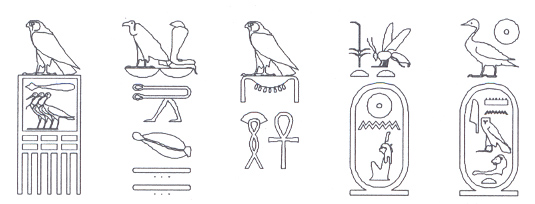
the complete
titulary of Pharaoh Amenemhet III (ca. 1818 - 1773 BCE)
Middle Kingdom, XIIth (Theban) Dynasty :
Mighty Horus
Great of Might
He of the Two Ladies
Taking possession of the inheritance of the Two Lands
Horus of Gold
Permanent of Life
King of Upper and Lower Egypt
Maat of Re (Nimaatre).
Son of Re
Amun at the Head
The king dies, long live the king !
Crowned, Pharaoh is no longer called by his nomen name. When this name is used,
it is preceded by "son of Re". As a king, only his throne name is heard. As
his father, justified by Osiris, had become an Akh-spirit (with Re), i.e. a
deity, his former son, now Pharaoh, is himself become a manifestation of Re.
This the prenomen specifies. The transformation is completed between the moment
the old king died and Pharaoh was enthroned.
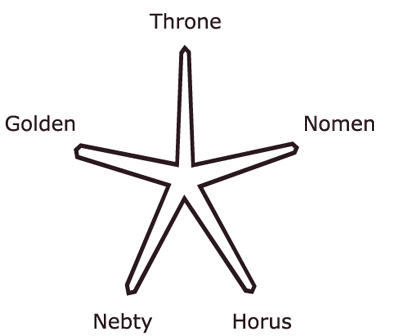
The royal
titulary arranged around N14 ("sbA" or "star"), a Pentagram.
The royal titulary reflects the
unity of the spiritual (eternal) and political (temporal) rule of
Pharaoh. It identifies the five parts of his "name" ("rn"). Together, they
constitute the fundamental "formula" of his rule, both religiously
(magically) as politically (his program for Egypt). To know this name,
confers the nature and goal of the "great house" of living Egypt, a
dual king, human (by birth) and divine (by nature). The first two parts of
the titulary, the Horus name and the Nebty name, refer to the Early
Dynastic Period, when the rule of the "Followers of Horus" united the "Two
Lands" of Upper and Lower Egypt. Duality has been transcended in the rule
of harmony, truth and justice (cf. Maat). The last two names reflect the
theology of Re, in particular the fact the Pharaoh is the son of the
creator-god. The Golden Horus name, standing in-between, adds panache,
like the flamboyant monumentality of the Great Pyramid dazzling in the
Sun-light. It affirms the king was headed to paradise, a state associated
with nourishment and peace. Like gold, Pharaoh's reign endures. Like the
flesh of the deities, he lives forever !
► the pyramid of Unis
and the
Pyramid Texts
Pharaoh Unis (ca. 2378 - 2348 BCE) was the last
Pharaoh of the Vth Dynasty. His pyramid
at Saqqara is at the South-western corner of Djoser's enclosure. The
complex, a model for subsequent rulers, is almost diagionally opposed to
the pyramid of Userkaf (ca. 2487 - 2480 BCE), the founder of this
Heliopolitan Dynasty. Pharaoh Unis is the first to include
hieroglyphic
inscriptions in the tomb, namely in the
corridor,
antechamber,
passage-way and
burial-chamber
(not in the
Ka-chamber).

Cartouche of
Pharaoh Wenis.
The inscriptions carved and filled with
blue pigment on most walls of the royal tomb underneath the pyramid of Unis (or
Wenis), contain, in 234 of the more than
700 known utterances, the first historical account of the (Heliopolitan)
religion of the Old Kingdom. Nearly three centuries after the Old Kingdom began,
these important "spells" were recorded and entombed for the first time
by Pharaohs Unis, Teti, Pepi I, Merenre & Pepi II. This
"eternalized" body of texts includes drama, hymns, litanies, glorifications,
magical texts,
offerings rituals, prayers, charms, divine offerings, the ascension of
Pharaoh, the arrival of Pharaoh in heaven, Pharaoh settled in heaven, and
miscellaneous texts. It is the oldest body of theology in the world, and
precedes the textualization of the Vedas (ca. 1900 BCE).
"... from internal references in the Vedic literature we
can now state with some certainty that the Rig-Veda was not composed, as
maintained by many scholars under the spell of the Aryan invasion model, around
1200 BC, but at least more than eight centuries earlier. The hymn
composers knew of an environment that simply ceased to exist around 1900 BC.
What more concrete evidence could anyone wish for ?" -
Feuerstein, Kak & Frawley,
1995, p.105.
The texts from the tomb of Unis are available
online as well as
Sethe's standard edition of the
Pyramid Texts (1910). This
exclusively royal funerary corpus consists of a series of "utterances",
so called because the expression "djed medu" ("Dd" = "words" ; "mdw" = "speech")
or "words to be said", i.e. "to recite" is, as a rule, at the head of most. In
Sethe's edition, 714 Utterances are given, whereas
Faulkner (1969)
brings the total to 759.
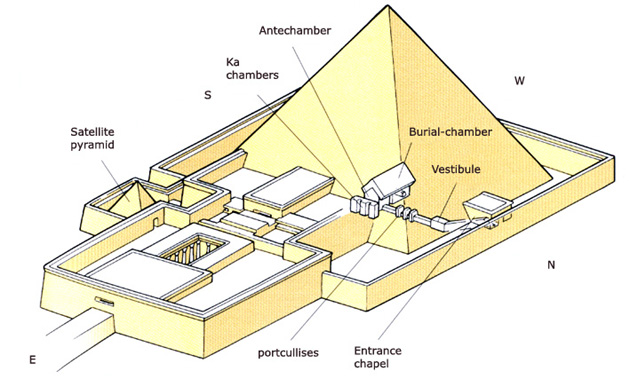
Plan of the
Pyramid-complex of Unis (ca. 2378 - 2348 BCE).
The Pyramid was 57.75 m², 43 m high, with a slope of 56°.
The causeway to the pyramid of
Unis was 750 m long and was equal to Pharaoh Khufu's. In its roof, a slit
was left open, so a shaft of light could illuminate the gallery of
brightly painted reliefs, of which only fragments survived. A wide array
of scenes once covered the wall : boats transporting granite palm columns,
craftsmen working gold & copper, harvesting scenes (grain, figs & honey),
offering bearers, battles with enemies, bearded "Aziatics" ... Two boat
graves (each 45 m long) lay side by side South of it. By the New Kingdom,
the complex had fallen into ruins.
The antechamber of the pyramid tomb lies directly under the centre axis of
the pyramid. In the East, a doorway opens to the uninscribed Ka-chamber
with three recesses. The middle recess of this Ka-chapel (intended for sitting
statues of Pharaoh Unis ?), lies exactly behind the false door of the mortuary
temple.
The sitting statue is attested in the funerary domain from the
Early Dynastic Period onwards. It is the three-dimensional realization of
the picture of the Slab-stela, representing the enthroned tomb owner in
front of an offering table, to which he is stretching out one hand. The
stretched (mostly right) hand is shown resting on the thigh, the left hand
often on the breast (but variants in gesture and garment exist). During
the IVth Dynasty, the sitting statue is a formal part of the Giza
cemetery. It was placed in a closed "serdab" (the Arabic for "cellar"). In this "inner" cult place
-dedicated to the provision cult for the deceased- the Ka-statue is the
"double" of the tomb owner, representing the latter as corporally intact,
provided and able to receive provisions by way of the mummy enshrined in
the sarcophagus, and by way of the Ka and/or Ba visiting the tomb and recognizing its own image in the Ka-statue.
On the ceiling of the tomb, golden, pentagram-like stars were carved in
relief on a sky-blue background. The tomb is made of Tura limestone,
except for the West wall of the burial-chamber and the western halves of
its North and South walls, opposite the ends of the granite sarcophagus,
which are in albaster, cised and painted to represent a reed-mat and a
wood-frame enclosure (cf. the Early Dynastic Period and earlier). Sunk in
the floor to the left of the foot of the sarcophagus was the canopic chest
(near the South Wall).
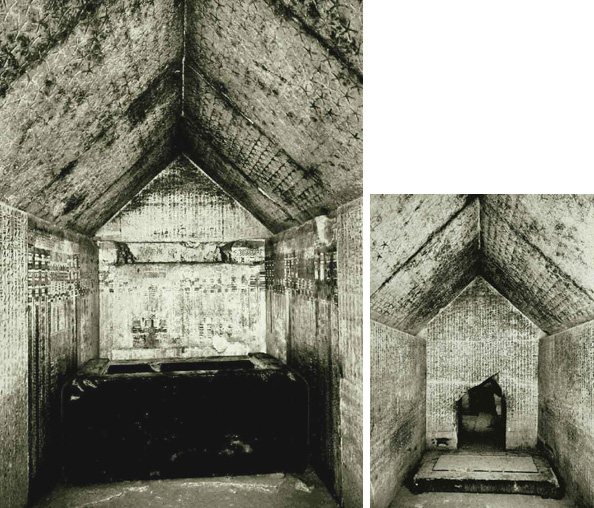
Burial-chamber
- pyramid of Pharaoh Unis.
Sarcophagus West, western half of North & South walls in albaster.
Canopic chest to the left (South) of the foot of the sarcophagus - Piankoff
(1968).
These texts constitute, together with
those on the walls of the tombs of Pharaoh Unis' VIth Dynasty successors (Teti,
Pepi I, Merenre & Pepi II), the oldest corpus of Ancient Egyptian religious,
funerary & theological literature. Moreover, Pharaoh Teti's pyramid followed the prototype
established by Pharaoh Unis. Its dimensions are practically identical with those
of the pyramids of Pepi I, Merenre & Pepi II.
When Pharaoh Unis decided to adorn his tomb with sacred hieroglyphs, in order to assure for himself
-through the
magic of his
great speech-
his ultimate realization in the afterlife,
Osirian faith was already popular and its incorporation in the Pharaonic
funerary rituals had already begun. So the name "Osiris" is inserted before
Pharaoh's name wherever it stands at the head of the utterance. This is omitted
in all cases when it occurs in the text (except in Utterances 25 & 38).
Breasted (1912)
concluded the editor must have been "Osirian", working hastily and mechanically
...
"While there is some effort here to correlate the functions of Re and Osiris,
it can hardly be called an attempt at harmonization of conflicting doctrines.
This is practically unknown in the Pyramid Texts. (...) But the fact that
both Re and Osiris appear as supreme king of the hereafter cannot be reconciled,
and such mutually irreconcilable beliefs caused the Egyptian no more discomfort
than was felt by any early civilization in the maintenance of a group of
religious teachings side by side with others involving varying and totally
inconsistent suppositions. Even Christianity itself has not escaped this
experience." -
Breasted,
1972, pp.163-164.
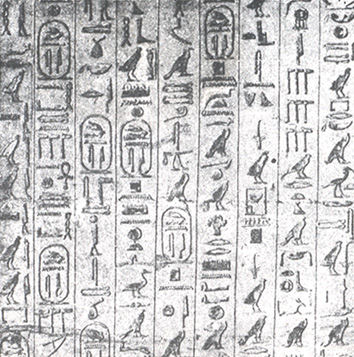
Text-fragment in
the tomb of Unis - Piankoff (1968).
Although historical traces of Osirian
faith predating the Pyramid Texts are sparse, popular Osirian beliefs
had, during the previous Dynasties, already slowly infiltrated the Solar state
religion. Had predynastic religion identified Osiris with the fertile waters of
the inundation, with soil and vegetation (cf. Orion and the Dog-Star in the
South, the direction of the inundation) ? The ever-waning and ever-reviving life of
Egypt's soil through the Nile was entrenched by the story of the murder &
resurrection of Osiris and the triumph of his son Horus over Seth, the evil
uncle. As a result, and despite its popular origin, Osirian faith entered into
the most intimate relationship with the ideology of divine kingship, causing a fundamental
tension to be resolved later, when Osiris, as god of the dead and king of
the netherworld, was increasingly seen as the nocturnal aspect of Re (cf.
the New Kingdom Solar theology).
So, although the religion of the state was a Solar faith focused on Pharaoh, the
Pyramid Texts evidence an ambiguous relationship with Osiris, the god of the
common people and popular beliefs. The Predynastic Osiris cult, probably local
to the Delta, involved a forbidding, stern & repellent hereafter. Osiris was a
Nile-god and a spirit of vegetable life, a harvest-god. But, as a king of Egypt, he
had been killed by his brother Seth, recovered and restored by his wife Isis (with
the help of the secret name of Re) and resurrected by his son Horus, who avenged
his father by overcoming Seth in a battle presided by Thoth. When Osiris
migrated up the Nile from the Delta, he was identified with the old mortuary
jackal-god
of the South, "the First of the Westeners" (Abydos, Assiut). His kingdom was
conceived as situated below the western horizon, where it merged into the
netherworld. He became the king of the dead below the earth, the "Lord of
the Duat", monarch of a subterranean kingdom.
"... in the Solar faith we have a
state theology, with all the splendor and the prestige of its royal patrons
behind it ; while in that of Osiris we are confronted by a religion of the
people, which made a strong appeal to the individual believer. (...) In the
mergence of these two faiths we discern for the first time in history the
age-old struggle between the state form of religion and the popular faith of the
masses." -
Breasted,
1972, pp.140-141.
According to
Breasted, nothing in these primordial myths proved Osiris
to have a celestial afterlife. Indeed, the Pyramid Texts evidence
survivals from a period when Osiris was even hostile to the Solar dead. There
are exorcisms intended to retain Osiris to enter the Solar tomb with evil intent
(cf. supra).
However, the popularity of Osiris among the common people forced the theologians
to incorporate him into the Solar creed. In this way, Heliopolitan Solar
theology got slowly Osirianized.
The resurrection of Osiris by Horus and the restoration of his body was affirmed
to be Pharaoh's privilege. The Osirian hereafter was celestialized. Osiris was
now called "Lord of the sky" (PT, §§ 964, 966a) and Pharaoh was announced
to Osiris in the sky precisely in the same way as he had been announced to Re in
the Solar theology. Hence, we find Pharaoh ascending to the sky and then
descending among the dwellers in the netherworld (PT, § 1164),
implying that the Duat became somehow accessible from the sky. In the
Osirian cult, the netherworld became the lower region of the sky, in the
vincinity of the horizon, below which it is also extended (Breasted). An
important link between Re and Osiris was the former's death every day in the
West, the place of the dead. The dead Pharaoh and the dying Sun corresponded
well, as did the resurrection of Osiris (as king of the dead) and the dawning of
the Sun (as the child Harpocrates, who is the father of the king of the living).
"The fact remains, then,
that the celestial doctrines of the hereafter dominate the Pyramid
Texts throughout, and the later subterranean kingdom of Osiris and
Re's voyage through it are still entirely in the background in these royal
mortuary teachings. Among the people Re is later, as it were, dragged
into the Nether World to illumine there the subjects of Osiris in his mortuary
kingdom, and this is one of the most convincing evidences of the power of Osiris
among the lower classes. In the royal and state temple theology,
Osiris is lifted to the sky, and while he is there Solarized, we have just shown
he also tinctures the Solar teaching of the celestial kingdom of the dead with
Osirian doctrines. The result was thus inevitable confusion, as the two faiths
interpenetrated." -
Breasted,
1972, pp.159-160.
The Pyramid Texts evidence the emergence of a composite mortuary
doctrine. But what used to be viewed as a separate "Osirian" destiny of the king
"has more recently been recognized as one aspect of his
celestial cycle - the regenerative phase through which he passes before 'rising
in the eastern side of sky like the Sun' (Pyr. 1465d-e)." (Allen,
1989, p.1).
In the ca. 650 years between ca. 3000 BCE (the beginning of the Dynastic
Period) and ca. 2348 BCE (the death of Pharaoh Unis), the written language had considerably developed. But although
words could be joined together in simple sentences and the latter in pragmatical
groups (dealing with honors & gifts, offices, legacies, inventories, testaments,
transfers, endowments, etc.), the additive, archaic quality of the literary
style was pronounced.
In the Old Egyptian of the Pyramid Texts, the composition between
semantic groups is
loose. Subjectivity is still objectified. Pre-operatoric activity is
limited by the immediate material context. Older structures were mingled with
new ones and many traces of earlier periods were left over. The extent of this
layeredness has been called in to reject the possibility of Ancient Egyptian
philosophy. The language, which has the style of the "records" of the Old
Kingdom, is often additive and offers little self-reflection (which starts with
the
literature of the First Intermediate Period).
Didactic poetry (precepts)
and lyrics in which
personal emotions & experiences
are highlighted are nearly absent.
Various types of parallelism occur : synonymous (doubling or by repetition),
symmetrical, combined, grammatical, antithetic, of contrast, of constraint, of
analogy, of purpose and of identity. Metrical schemes of two, three, four, five,
six, seven or eight lines occur (the fourfold being the most popular). The play
of words is the commonest literary feature and depends on the consonantal roots
of the words. Alliteration, metathesis, metaphors, ellipses, anthropomorphisms
and picturesque expressions are also found.
The Pyramid Texts have their own particular problems and difficulties.
They are a set of symbolical "heraldic" spells which mainly deal with the
promotion of Pharaoh's welfare in the afterlife. These spells were recited at
various ceremonies, mostly religious and especially in connection with the
birth, death, resurrection and ascension of Pharaoh. These texts are to a large
extent a composition, a compilation and joining of earlier texts which
must have circulated orally or were written down on papyrus many centuries
earlier. Some of these go back to the oral tradition of the Predynastic Period,
for they suggest the political context of Egypt before its final unification (as
Sethe pointed out). Others, although the archeological record is limited, were
used in this-life rituals, and have
initiatoric connotations.
The relative rarity of corruptions is another important fact which makes their
study rewarding.
"The Pyramid Texts were not the work of a single man or of a single age.
They are entirely anonymous and of uncertain date. And they are religious
literature which reflect more or less clearly the conditions of religious
thought in ancient Egypt previous to the Seventh Dynasty - more like the
Psalms than any other book of the Old Testament." -
Mercer, 1956, p.2.
The contemporary school of egyptological literalism
equates the earliest temporal layer of any text with its historical date of composition, mistrusting
the presence of literary antecedents. In the case of the Pyramid Texts,
they would agree to push the date of inception with a few centuries (the margin
of error for this period being ca. 100 years) but try to avoid a
Predynastic figure. Indeed, comparisons with the architectural language of the
period, makes it likely that under Pharaoh Djoser, the Egyptians had the
conceptual framework of the Pyramid Texts at their disposal. King Djoser, the "inventor of stone" and his Leonardo da Vinci, Imhotep, the "great
seer" (or prophet) of Re at Iunu, "the Pillar", 40km northeast of Memphis (the
Greek Heliopolis, the Coptic area of contemporary Cairo), layed the foundations
of the Old Kingdom "canon" which ruled all aspects of the life of the
Ancient Egyptian elite,
including writing, art & religion.
1.2
Funerary logic of the tomb of Unis.
► spatial semantics
In Ancient Egyptian thought, measurements and spatial relationships between
parts of a building were considered significant from a religious and ceremonial point of
view. Spatial semantics played a role in the arrangement of texts on papyri &
stelæ (cf. the
Shabaka Stone). Surely identical
considerations animated the architecture of Pharaoh's tomb ?
The texts in the tomb of Unis do not provide us with a straightforward narrative of
their ritual performance. The latter is never decontextualized, but was partly
iconified in architecture and architectural decoration. Both antechamber and
burial-chamber have as central theme the resurrection of the king and his ascent
to heaven. Offering rituals, one of the instruments of resurrection, accompany
the presentation of offerings. But, on the East gable of the burial-chamber, the king establishes his independence of food
supply.
"Exploitation of a narrative coherence in
representation of the ritual falls far behind symbolic and spatial
ordering as a principle of decoration : the ordering of the ritual
material is to a considerable extent defined by general principles of
a largely symbolic nature, modified by the ad hoc resolutions
necessary to fill the space available." -
Eyre,
2002, p.44.
This symbolico-magical use betrays the deeper intention of the hieroglyphs : the wise has seen
how the Ka of former Pharaohs had no longer been fed and they introduced
written food offerings and voice-offerings as a magical alternative (Sethe,
1908). The inscriptions served this magical
purpose. To the subtle body of the Ka, the sacred script represented the subtle
energies of what was represented. It "read" the sacred words and was "fed" even
if the priests forgot to perform the offering ritual. If the script contained
images of dangerous animals, the sign was crippled ...
► reading a tomb
?
For
Sethe (1908), the
texts found in these pyramids were a free collection of magical
utterances, which, by virtue of their presence, assisted Pharaoh de
opere operato in his resurrection & ascension, dispensing with
the need for daily priestly offerings to his Ka. The presence of
texts of offering fed the subtle bodies of the deceased. Sacred words
not only describe objects but embody their double (cf. the Lascaux
pictures and the Eastern desert petroglyphs). Hence, once properly
recited (by the dead), they became efficient (for all of eternity).
These are the deified elements of Egyptian ante-rational epistemology
: "Sia" (understanding), "Hu" (authorative speech) and "Heka"
(efficient power or magic). These natural types of cognition in an
Egyptian mode, form the core of the mental spirituality of the
Egyptians. The hidden, secret, dark potential of hieroglyphs was
evidenced by the sacrificial rituals found in mortuary literature. The
Ba of the deceased read the words and manifested their meaning.
"We have already pointed out that the spells of
the so-called sacrificial ritual, i.e. the texts used in the provision
of supplies, were inscribed in a prominent place where they could be
seen by the dead person resting in his sarcophagus. (...) In other
words, texts were written down so that the dead themselves could
'proclaim the provision of supplies' ("nis dbHt-Htp") instead of this
being done by unreliable priests. This was the nucleus around which
the texts crystallized." -
Morenz,
1996, p.229.
Schott (1945) &
Ricke (1950)
advanced the thesis that at the time of the funeral, these texts were
recited in the various chambers, corridors and courts through which
the procession passed on its way to the pyramid. But it was not easy
to identify which spell was recited were ! For
Spiegel (1953 &
1971) the texts were an integral part of the funerary ritual performed
in the tomb and hence were recited in the area were they were
inscribed. They reflected the royal burial ritual. This hypothesis was
criticized. In 1960, Morenz wrote :
"This bold, learned and ingenious interpretation
can properly be accessed only by one who has examined it in terms of
the vast and diverse material. When this is done, it appears that
quite serious objections may be levelled against numerous points in
the argumentation and thus against the thesis as such." -
Morenz,
1996, p.228-229.
Nevertheless,
Altenmüller
(1972) agrees with Schott & Ricke that these texts were recited in the
mortuary temple, as well as in the pyramid, involving priests assuming
the god-forms of Re, Horus, Seth and Thoth.
Eyre (2002) suggests the training and
initiation of these priests points to this-life rituals.
"The promise of divine assistance, resurrection, and safe
passage to the afterlife is not, however, a concern purely of funerary
ritual, and the markedly initiatory form of parts of the mortuary
literature must be taken as a pointer to contemporary 'this-life'
ritual that is otherwise lost from the archaeological record." -
Eyre,
2002, p.72.
In "Reading a Pyramid",
Allen
(1988) compared the
location of the texts within the
tomb of Unis with
other Old Kingdom pyramids and tombs (cf.
Morenz, 1960). He was able to establish a coherent model
describing the funerary ideology of these royal tombs. The
position of particular groups of texts within Unis' pyramid corresponds with the
placement of the same texts in other pyramids. Spells recited during the burial ritual
were
also
eternalized as
divine words
on the walls, further complementing
the symbolism of the general layout of the mortuary complex in general and the
royal tomb in particular. Assmann (1983, 1989) notes :
"The Egyptian describes this function of the
spoken word with the causative derivation of the phonetic root (i)Ax,
thus arriving at s-Ax 'to transfigure')." -
Assmann, 1989,
p.137.
Recently,
Naydler (2005) has suspended
the funerary presupposition, and considers, together with
Quirke (1992), the use of the word
"mortuary temple" mistaken. The texts also reflect a this-life
spirituality and so represent a variety of rites performed by the
king during his life. As they involved regeneration, they were also
useful to him in the afterlife. Indeed, most kings started to erect
their temple shortly after their coronation and most probably
celebrated Sed Festivals there.
The overall Egyptian mentality seems to favour
an enduring canon of broad schemes adaptable to immediate
circumstances. As each Pharaoh had his own titulary, he had his
own royal ritual, reflecting a variety of local
(nomic) traditions at work around him. They existed by the grace of
the "good Nile" he alone, being divine, could guarantee. His death was
thus a major calamity, and could perturbate the agricultural cycle,
leading to famine, conflicts and death. His burial provided him with a
ladder between heaven and Earth, and so the first thing he would do,
arriving in the Field of Offering, was to provide Egypt with a new
king and a "good Nile".
The reciprocal function of the tomb has to be emphasized. The Ba
returned and the Ka could be reanimated. The liberated "Akh" has
freedom of movement and time. It is bright, light and radiant. While
it stays in the sky, the spirits make their souls and doubles come
down and unite with their statues. The destruction of a tomb, implies
the end of its role as "interphase" with "the other side" of the false
door.
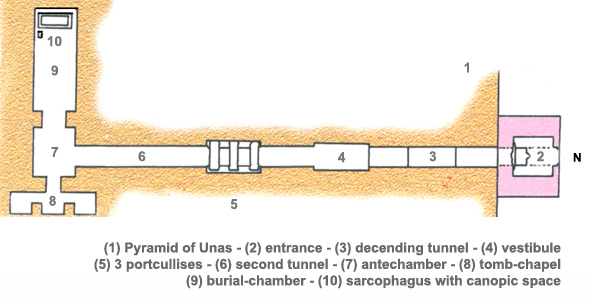
Plan of
the royal tomb underneath the pyramid of Unis.
"Allen's analysis of the sequence of spells in the pyramid
of Unis defines the architecture as a material representation of the passage of
the king through death to resurrection, exploiting themes familiar in the
Underworld Books of the New Kingdom. From the darkness of the earth he passes to
life in the light of the sky, progressing from the burial chamber as underworld
(duat) through the antechamber as horizon (akht) where he becomes Akh, through
the doorway leading to the corridor -ascending by ladder- to heaven (pet), or
passing like the setting sun from the west to his rising from the mouth of the
horizon in the east, or exploiting the image of the king passing from his
sarcophagus -the womb of Nut- through her vulva to birth at the door of the
horizon. (...) Allen's analysis focuses on the principle whereby the position of
discrete units of ritual text asserts a functional identity between the theology
of the text and the architectural symbolism of the pyramid substructure, and so
the reality of the king's passage to resurrection". -
Eyre,
2002, p.44-45 & 47.
The direction of the texts
was thus identical with
the soul's path through the tomb, moving from the innermost parts of the
burial-chamber
(the "Duat" in the West), through the
antechamber
(the Eastern horizon or "Akhet"),
to the outside of the pyramid via the
second northern
tunnel, flying to the Northern stars, reaching the Field of Offering.
-
the Duat
(burial-chamber) : though a part of the world, but neither Earth or sky,
the underworld is inaccessible to the living and outside normal human
experience. It is separate from the sky and reached prior to it. This Field of
Reeds is the realm of the deceased and the deities and the mystery of Osiris.
Pharaoh has perpetuated offerings, and stands at the door of the horizon to
emerge from the Duat and start his spiritualization ;
-
the Horizon
(antechamber) : "Axt" ("Akhet"), translated as "horizon", is both the
junction of sky and Earth and a place in the sky underneath this point (before
eastern dawn and after western dusk), a secret interstitial zone reached and
crossed by boat. It is a zone of
transition and a "radiant place", the "land of the blessed".
The horizon is the place of becoming effective, the locus of the becoming "Ax"
("Akh"), an effective spirit. Note (as did
Allen,
1988), that the
Cannibal Hymn, thematically belongs
in its place (the East gable). It summarized Pharaoh's passage through the night
sky to the Sun at dawn. The process of spiritualization ends with the emergence
of the new light. In this hymn to Pharaoh, the king prepares the deities for his
meal ;
-
the Imperishable
Sky
(northern tunnels) : the process of transfiguration (ultimate
spiritualization) being completed, the Akh-spirit leaves the tomb and ascends to
the northern stars.
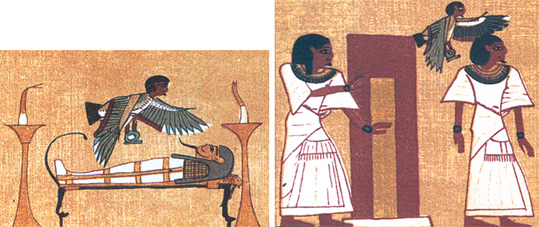
Ba of Ani rejoining the mummy - Ba leaving the tomb
Papyrus of Ani - ca. 1250 BCE - New Kingdom.
►
Pharaoh's great speech
If we understand these utterances as magical devices, and realize each
monarch had his own preferences, then it seems likely each Pharaoh made his
own choice out of the available body of religious literature, maybe adding a few
spells of his own. By doing so, he left to posterity an elaborated theo-literary
testament. This was his
magical "great speech",
exclusively serving Pharaoh's welfare in the afterlife, elevating him above all possible beings and making him even rise above the
deities themselves (cf. the
Cannibal Hymn).
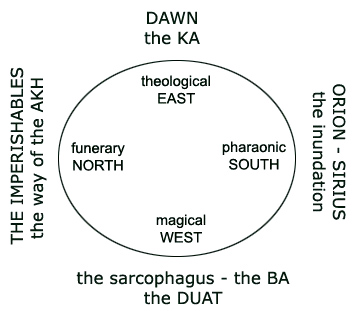
the
symbolism of the compass points
"In each instance maat is in concrete forms undoubtedly
the divenely-established pattern of government, and the pharaoh, by virtue of
his divine nature, receives it substantially like a sacrament. It will at once
be clear that in this process the king is not regarded as an individual person
but as the bearer of the royal office. One must assume that the maat at work in
the ruler was thought to be of benefit to each individual Egyptian." -
Morenz,
1996, p.121.
So
the "djed medu" or the recitative use of these texts should not be
surprising. With the tomb as cosmos, the material image of the texts magically
assisted the process of the Pharaonic rite of passage, transforming the king
into a spirit efficient enough to bless his son with a "good Nile", guarantee of
the unity of Egypt.
|
The four compass points
and the Heliopolitan ritual.
|
EAST
dawn
|
The rise of Re's rebirth
at dawn, the place of light, rebirth and the Ka-statue (the false door).
"Khepri", the end result of the nocturnal regeneration of the deities
thanks to Re and his (re)union with Osiris - Horus as a child ; |
SOUTH
zenith
|
The culmination of Re at noon, the heat of
Seth, the place of birth of the Egyptian state, the slaying of Osiris, the
mourning of Isis, the fierce battle between Horus and Seth and the
justification of the former as the "avenger of his father" - Horus as king
;
|
WEST
dusk
|
Re at dusk and his entry
into the netherworld to regenerate. Thanks to the magic of Isis and Thoth,
Osiris rose in the realm of the dead. When Pharaoh Horus brought his
restored eye to his father, Osiris was pulled out of his slumber and
became the king of the "beautiful West" ;
|
NORTH
nadir
|
During the twelve hours
of the night of the netherworld, Re travels (and countless Ba's with him)
on his Bark of Millions of Years. At midnight, the darkest point is
reached. The stars shining in Osiris' netherworld are in the upper sky,
the abode of the Imperishable Stars, the spirits of Re, the pantheon, the
sons of Horus and Pharaoh.
|
►
The Egyptian
psyche and funerary
rituals
Antiquity views matter as subdivided in gross & subtle
strata, allowing for different aggregates, on different material
layers or sheets, ranging from gross & physical to subtle and
spiritual. So gross matter is the lowest degree of spirit and subtle
spirit the highest degree of matter. Such an ontic pluralism is found in the Vedas,
in Yoga (Hinduism) as well as in Ancient Egypt. In the West, it would
return in Pythagorism, Hermeticism, neo-Platonism, Gnosticism, the
Qabalah, Sufism and Hermeticism (Renaissance Hermetism). In the East, it
would influence Yoga, psychology and cosmology. In his Ochêma of 1954, Poortman
suggested the term "hylic pluralism" in order :
"(...) to give expression to the fact that
it is not in the first place a question of matter as a
philosophical point of view, as in 'materialism', but rather a
question of several forms or subdivisions of matter. (...) The
view that the soul does not possess one ochêma or vehicle, but
several ochêmata or vehicles of matter, of decreasing density,
is sometimes encountered, for example, in the case of the
neo-Platonist Proclus." -
Poortman, 1954, p.8.
According to hylic pluralism, the entities existing in the house of the
living body operate on different levels of material density or vibration.
On each level, a given state of consciousness is housed by its adjacent
material vibration. As a result, their functions vary.
In Ancient Egypt, a jargon was developed
to describe this family of the psyche caught in the net of the living body.
As they were deemed to escape the body at death, they were essential in
the description of what happened to the deceased. These entities also
played a considerable role in the spiritual mechanics of the temples (for
the presence of the deities is through their double and souls), in the
tomb (cf. the Ka-chapels, the sitting statues) and at night (Re enters the
Duat as a soul). Egyptologists
have had a very difficult time explaining these, especially because it
seems that the Ancient Egyptians themselves did not always understand
them and so misused them.
"The unconscious is the land of dreams, and
according to the primitive view the land of dreams is also the land of the
dead and of the ancestors. From all we know about it, the unconscious does
in fact seem to be relatively independent of space and time, nor is there
anything objectionable in the idea that consciousness is surrounded by the
sea of the unconscious ..." -
Jung, 1977, vol 18, §
754, pp.315-316.
The dawn of the masculine, Pharaonic order heralds awareness of conscious
unity, a divine, Solar witnessing, transcending the dualities of
prehistorical, Lunar myth. In Pharaonic Egypt, adhering to a Solar
henotheism from the start, the Lunar component was partly assimilated by
the divine king, partly retained in the Osirian beliefs. The celestial
Nile, the hidden naos, the subterranean tomb, the Midnight Mystery of the
Duat and the darkness of dream and dreamless sleep all refer to the
primordial myths, the first time and the Lunar unconscious from which
consciousness escapes, return and escapes again.
"Es ist klar, dass uns der Gang in die Tiefe mitten
in die Bildwelt und Traumwelt des Unbewussten führt. Wie bei der
Schöpfung, ist die Sonne auch im Jenseits das ordnende Prinzip, das
schaffende Bewusstsein, dem in der Berührung mit dem Unbewussten neue
Kräfte und neue Lebendigkeit zuwachsen." -
Hornung,
1998, p.8.
Re, the Solar component, represents the active, luminous & creative
awareness of consciousness. Osiris, the Lunar component, is the passive,
(re)generative being-as-such of consciousness. Horus, concluding the
Ennead, is the divine Pharaoh and represents the identity of
consciousness, its "I-am-ness". The field of consciousness, the edge or
frontier of this awareness of Self is the Bark of Re, the vehicle assuring
Re safe passage travelling on the Nun, the great waters.
At the end of the day, conscious awareness is weary. The force is depleted
and needs to be renewed. In the morning, energy celebrates the day. The
power to do things is optimal and effortless activity is possible. At noon
the power of Re reaches its zenith. At midnight, reaching the nadir, the
point of ultimate depletion is approached. But before the death of
awareness is reached, a surplus from outside creation is added to
creation, consciousness and its awareness are rejuvenated and "existence
is extended". Each night, Re, the deceased and those who sleep are reborn
thanks to this Midnight Mystery.
This mythical "outside" is nothing other than the first time, the time of
eternal repetition, the neheh-time of Atum, the Ennead and Horus, Pharaoh.
These primordial Akh-spirits (or spirits of Re) are realized when the
power of conscious awareness (at its lowest) merges with the ground of
consciousness, i.e. with the divine, luminous stuff out of which it is
made. This merging of awareness (the reflection of consciousness to
consciousness or soul of consciousness) with the being or body of
consciousness itself, this conjunction of the effective power of conscious
awareness (the Ba of Re) with the noble, ritual body of Osiris, this
secret singularity between soul and body of consciousness, between what it
reflects and what it is, allows consciousness to reinitialize and realize
its primordial origin, ascend to its ultimate cause. This autogenic
capacity, outside Nature, is for all times. But when the orb of the
conjunction is no longer zero, integration occurs, and soul and body
split. Both have harvested the surplus from the primordial origin ; Re
realized his body and Osiris realized his soul.
"The Egyptians were the first to practice a Jungian
psychology of archetypes and to recognize the fundamental restorative
power of the unconscious. They realized that in sleep and dreams, one
experiences the depts as a psychic reality in which one may encounters
gods and the deceased alike." - Hornung,
1992, p.95.
Atum floating in the inert waters of Nun, the deity uniting with its statue in
the hidden naos of the temple, the subterranean tomb of the mortuary
complex, the Midnight Mystery of the Duat, the darkness of the
dreamworld and dreamless sleep, etc. all refer to the capacity of
consciousness to harvest an energy-surplus and regenerate. Darkness is
absence of response and herald of radical change.
When the power of conscious awareness no longer invests in the responses it caused, i.e.
stops differentiating and projecting out (cf. the 2th, 3th & 4th Hours of
the Amduat), it is able to witness its own substance (the stuff it
is made from) and unite with it (cf. 5th & 6th Hours). It is this
spatiotemporal witnessing of and fusion with the own light-stuff (micro)
which spiritualizes consciousness to the point of realizing (becoming) the uncreated condition (macro) of its own created existence
(autogenesis).
This witnessing (or awareness) of one's mind-stuff, makes the soul of consciousness
enter its body or light-stuff, the driver with the vehicle, the active with the
passive, the Solar with the Lunar. It is this
alchemy of singularity which produces the regenerative energy-surplus.
"One of the most important aspects of the Egyptian
conception of the body is that its resurrection does not occur only on
Judgment Day at the end of time. Rejuvenation and resurrection take place
every night in the depths of the underworld, where the deceased once again
exercise full power over their bodies. Human being enjoyed a continuous
existence interrupted only temporarily by the dissolution of death."
-
Hornung,
1992, p.172.
The Egyptians saw the physical body ("khat") as a magical vessel. It housed
a variety of entities, among which a
divine soul ("Ba"). The container carrying the Self and the rest
of the psyche had to be kept
elegant and healthy. So during life, the physical body was
a temple ; clean and ready to serve the deity. Obesity was a terrible
weakness. Especially when it died, the
body was treated with respect, reverence and awe. For royal burials,
expensive, complicated and long funerary procedures were common practice.
The first thing to do was to change the physical body into a mummy. The
latter, when properly activated, allowed the "sah" to accommodate the
soul.
"Unlike ancient artists who concentrated
on a person's individuality or beauty, Egyptian artists wished
to present the enduring, suprapersonal part of the human being
that, removed from time, lives on in the hereafter. While not
ignoring the physical side of existence, the Egyptians realized
that the human being had a variety of spiritual or mental
components as well." -
Hornung, 1992, pp.174-175.
The most important element of an individual was his or her name ("ren").
This was more than a portrait or a way to identify someone. It represented
the "power" ("sekhem") of an human being, in particular that of unifying
the various entities of the psyche. This Egyptian approach is consistent
with name magic.
"Word and name magic are, like image magic, an
integral part of the magical world view. But in all this the basic
presupposition is that word and name do not merely have a function of
describing or portraying but contain within them the object and its real
powers. Word and name do not designate and signify, they are an act."
-
Cassirer,
1955, vol.2, p.40.
The Ancient Egyptians introduced three ontic levels, overarched by the
person's name :
-
the Akh-level :
spiritual : Re and the station of the spirit ;
-
the Ba-level :
transitional : Osiris and the station of the soul ;
-
the Ab-level :
incarnational : the station of the body.
The station of the body ("khat") is
represented by the heart ("ab"), the Lunar "ego" or "I have" of
consciousness. Here we have the inner, lower focus of consciousness, the presence
of a functional "I" in command. This heart is linked with the vital
power surrounding the body as an aura or double ("ka"). This vitality is
the outside of the person, and represents the particular vibration of
another, subtle layer of matter (cf. "prânâ" in Yoga, "chi" in Taoism,
"etheric double" in Theosophy) accompanying the physical vehicle. The role of the shadow
("khaibit") is in doubt. Physical body, heart, vital force and shadow are
the first ontic layer.
The station of the soul ("ba") represents the Solar "Self" or "I am" of
consciousness. This is the effective (creative) focus of consciousness and
proximity to the spiritual. Happiness on Earth seems to be the hope of the
soul. But initiates prepare for their eventual meeting with Osiris in the
afterlife. So their soul may have been at work with them while on Earth.
After having
faced Osiris, they are ready to rise and be transfigurated. After death,
the soul received a vehicle called the "sah", the noble body. The soul and
its noble body are the second ontic level.
The station of the spirit ("akh") represents the stellar, transcending
superconsciousness of the One (Atum) and the Ennead. Its body was the
light of the stars ("khabs"). This is the ontic level of the ultimate
cause. The soul transfigurates into an Akh-spirit. Incarnate, nobody could attain
this spiritual level of existence consciously. Pharaoh was
the only embodied divine Akh. All ordinary deceased could hope to be
justified by Osiris and become a spirit of Osiris (Field of Reeds). Only
Pharaoh and his royals flew to the sky (Field of Offering). The spirit and its star-body are the
third ontic level.
Only when the physical vehicle dies, do double, heart, shadow & soul
-during Earthly life bound together by the name- escape and temporarily entertain independent
status. Each component is addressed. The double and the noble body ("sah")
are dealt with during mummification and in elaborated funerary rituals.
The heart is activated (after the mummy) and weighed in the afterlife.
When justified, the soul enters its noble body (Osiris) and transfigurates
into a spirit (Re). The Akh-spirits enters the "sah" when it likes. The
soul is able to return to the mummy and bless the physical plane by way of
an overwhelming divine presence and breath of life ... Ordinary humans
hope for the netherworldly Field of Reeds (the spirits of Osiris). Re, the
Ennead and Pharaoh (the primordial Akh-spirits) live in the Field of
Offering, in the northern sky.
|
REN : THE COMPONENTS OF THE
EGYPTIAN NAME : REN |
|
HIGHEST
SUBTLEST
ETERNAL
Re and Osiris
|
akh
(spirit) |
the essence of every thing
is the divine, luminous radiance (of Atum), i.e.
cosmic consciousness achieved through ritual transfiguration : the
Akh-sphere of Re (in the sky) and the Akh-sphere of the transfigurated &
justified deceased (spirits of Osiris in the Duat) |
khab
(spirit-body)
|
the bodies or vehicles of the Akh-spirits
are made out of the light of the stars (around Re or in the Duat) |
HIGHER
SUBTLE
TRANSITIONAL
the soul
Osiris |
ba
(soul) |
witness at judgement, justified by Osiris,
freely existing in its sah-body and gratified by the offerings to the Ka,
the effective, inner, intimate side of the individual, his or her true
soul-power (of change), reunited every night with the body in de depths of
the underworld, the experience of yourself as yourself, the Self as
a complete, living, conscious being, higher states of consciousness |
sah
(soul-body) |
liberated as the result of mummification and funerary rituals, the result of ritual work and so charged as a function of
dedication, devotion and offering |
|
LOWER
GROSS
TEMPORAL
the Two Lands
abode of Pharaoh
|
ab
(mind)
|
restored and weighed -only the truth is light
enough-, free will, conscience, mental frame, memory, waking state of
consciousness |
ka
(personal
lifeforce) |
free to move, the double remains near the
mummy and is fed by offerings or images - it belongs to the universal
vitality of life and is the outer, public side of the individual, his or her
vital force |
khaibit
(shadow) |
free to move, but linked to the Earth,
contains repressed emotions and frustrations ? |
|
khat
(corpse) |
the mummy does not decay - mummy and tomb are
a magico-spiritual symbolization of eternal existence, a talisman
celebrating the enduring nature of the eternal cycle of spiritualizations
and materializations |
1.3
The Coffin Texts
& the Book of the Dead.
►
political & economical players
At the end of the Old Kingdom, what had been a stable
Pharaonic system, slowly broke down. During the nine decades of the reign
of the last Pharaoh of the VIth Dynasty, Pepi II (ca. 2246 - 2152 BC) -the
longest reign in history- the way was paved for the collapse of the Old
Kingdom under the pressure of internal weakening. No serious dangers
threatened Egypt from western Asia or Nubia, although attacks on Egyptian
expeditions seems to have been more frequent. For this collapse only
internal reasons prevail. One important factor was the increase in the
number of cults freed by royal decree from taxes and other obligations,
placing a burden on the royal treasury, diminishing is power and majesty
(cf. the number of buildings built). Low Nile floods are also to be noted,
as well as a climate change ca. 2200 BCE (probably a world-wide small ice
age). The combination (low reserves) proved fatal.
"But the decisive factor was that the archaic,
patriarchal structure of the adminstration was no longer adequate to meet
the more specialized demands of the era and thus not suited in all
respects to the tenor of the times." -
Hornung,
1999, p.41.
Economic need occupied the center of attention in biographical
inscriptions which emerged in this period. After Pharaoh Pepi II, the
construction of pyramids stopped and in rapid successions at least a dozen
kings resided in Memphis. Egypt was divided between the "kings" of two
major nomes : Heracleopolis in the North (IXth & Xth Dynasty) & Thebes in
the South (XIth Dynasty). The unity broke up and great monuments were no
longer erected to consolidate the power of a unified state. These facts
initiated the First Intermediate Period (ca. 2200 BCE).
Around ca. 1980 BCE, after a century of disunity, Herakleopolis fell and
all of Egypt was again under the rule of a single Theban Pharaoh, namely
Mentuhotpe III (ca. 1945 -1938 BCE), who took the title of "King of Upper
and Lower Egypt" and who's death marks the end of the First Intermediate
Period.
Pharaoh
Amenemhet
I ("Amun is pre-eminent" - ca. 1938 - 1909 BCE), initiating the XIIth
Dynasty and with it the Middle Kingdom (ca. 1938 - 1759 BCE), moved the
royal residence away from Thebes to the North, thus removing the centre of
activity elsewhere. Thebes lost much of its political power but became the
home of
Amun, the "king of the gods". Pharaoh Amenemhet returned to the
old forms, but invested with new meaning. More modest and less
enduring than those of the Old Kingdom, the Middle Kingdom pyramids
evidence the return to the traditional form of the royal tomb.
With this XIIth Dynasty, the "Feudal Age" started. It was a thousand years
since the first pyramid had been built. The priesthood, left without
support, had forsaken the immense monuments and temples. The cemeteries lay
encumbered with sand, hiding the ruins of massive architectures. No doubt this
solid waste land impressed the descendants of its builders. Around 2000
BCE, they must have been struck with awe before the transient nature of
existence, the colossal futility of these ruins and the gigantic ancestral
accomplishments ... The Middle Kingdom was provincial. The nomarchs reinterpreted divine
kingship (its exclusivity and enduring "good Nile"). The kings gave the deities
their king (Amun-Re). The latter move would accomodate the blossoming of
henotheism and proto-rational monotheism in the New Kingdom (cf. Solar
worship in the XVIIIth Dynasty : Re, the
Aten,
Ptah and
Amun after
Amarna).
►
a radical change of perspective
The collapse of the Old Kingdom (from Pharaoh Djoser to
Pepi II, a period of ca. 430 years) and the subsequent decentralization
which eventuated, put Egyptian culture in a state of crisis. In the
population as well as in the organs of state, this triggered a most rewarding
re-equilibration. An internal "prise de conscience" regarding good
(Maat) & evil (Nun, Seth & "isefet") and the importance of the role of
the provincial individual in the state came into effect.
From the First Intermediate Period (ca. 2198 - 1938 BCE) onwards, and
especially in the Classical Age (or Middle Kingdom), Pharaoh was no longer
the absolute, sole justification & justificator. The collapse of the Old
Kingdom heralded the beginning of Egyptian individualism. Before, morality
had been based on one's place in the Pharaonic state and the just actions
one had performed as a member of it. Its collapse caused rumination on the
condition of man and the Egyptian state. How to guarantee the order of
creation ?
The morality of the individual was deemed more important than
belonging to the retinue of Pharaoh. As the latter had failed, people
turned directly to their deities and sought to develop a personal
morality. Later, in the Book of the Dead, both themes animated the
so-called "Judgement before Osiris", or "Judgement of the Dead", the
justification of the deceased before the throne of the king of the dead.
This theme would become very important in the funerary rituals of the New
Kingdom and was influencial on Mediterranean spirtuality as a whole (Armstrong,
1989).
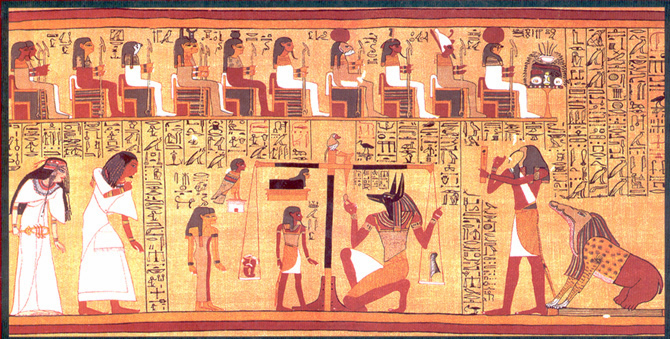
The Weighing of the Heart
Papyrus of Ani, Plate 3 - early XIXth Dynasty - Faulkner (1998).
This final breakdown of the pre-rational, pre-conceptual
value system of the Old Kingdom came as a shock which also caused the rise of
pessimistic, sceptical tones (cf.
Discourse of a Man with
his Ba). These, however, did not carry with them any large body of the
Egyptian people, but are remarkable testimonies.
As a result of this collapse, three major changes
in the cultural form of Egypt ensued :
-
political & economical
: local
potentates acquired the necessary goods for themselves and their subjects. Raids
on neighboring regions and the peasants were common. The latter therefore formed
armed bands. Safety was lost. Art sank to a provincial level. But in the walled
homes of the rulers of the nomes (the nomarchs), an urban middle class was
formed, focused on the accumulation of private property. These "nedjes" (a
pejorative word for "small") designated these new "bourgeois" who made the
cities into political centers. Some became powerful enough to claim kingship for
themselves, albeit nominally, for the division of the Two Lands remained a
political fact ;
-
psychological, inter-subjective,
social : the struggle against the return of the banished chaos of the
pre-Pharaonic era, triggered a flowering of literature such as Egypt had never
produced before. With the decline of the monarchy, the identification of Maat
with the Great Speech of
Pharaoh broke up. So the questions : What is good ? What is evil ? became all
important. For the intellectual elite of the First Intermediate, the divine
shepherd had forsaken his human flock. Even the blessed afterlife was
questioned. New ways to formulate thoughts were sought, especially to break away
from the formulaic & archaic literary style of the mortuary cults. For the first
time, individuality was truly expressed ;
-
theological & spiritual : the
cultic importance of Pharaoh as sole mediator between the sky and the Earth
became less important than the deities themselves. They stepped into
the foreground and their temples & cultic requirements increased. Especially
Osiris, the "king of the dead", Amun-Re, "the king of the gods", and the
Pharaonic Ptah of Memphis gained in worship from the Middle Kingdom onward.
Osiris & Re were harmonized in ways no myth or pre-rational construction had
ever done before. The sole "son of Re" on Earth had not been enough to continue
the glorious tradition of the Old Kingdom. The latter was idealized and
canonized. But individual righteousness had become the path to justification
(resurrection in the "sah"), automatically leading up to the state of the
Akh-spirits. Everybody had a soul and could become "an Osiris", but only Pharaoh
rose to the sky.
The intellectual elite, like senior priests, scribes & top
administrators, aware of recent history and the futility of the brontausoric
building projects (for order had been disrupted anyway), were forced to fashion,
out of their shared memories of past sorrows (not shunning exaggeration and
caricature), new cultural forms. Egypt posed the "great question" of order
versus chaos, initiating the Classical Age of
Egyptian literature, and
developing a "standard" hieroglyphic system for writing theology, namely
Middle
Egyptian.
This new form was made possible by the emancipation of cognition from the
pre-rational to the proto-rational mode, i.e. from the pre-concept to the
concept, albeit contextual & pre-formal. The concrete-operatoric operator came
into being (cf. the standardization of the verb-forms in Middle Egyptian). The
Old Kingdom became an ideal charged with nostalgia. It had been construed
exclusively around Pharaoh and Memphis. It represented the "old" mythical
and pre-rational mode, not shunned, but deemed responsible for the "canon" of
the Egyptian cultural form as such.
In the Feudal Age, Pharaoh left existing "dynasties" in place and created
new ones. In this way, a "provincial" geo-sentimental approach to power rose,
and Pharaoh had to maneuver to maintain his by now foremost political role as
"king of Upper and Lower Egypt" and maintainer of the cult. His
presence as such became institutionalized (no longer the original power he
represented in the Age of the Pyramids). In the Old Kingdom,
the Memphis area had been the sole place of power and monumental prestige. These
times were over. The state was no longer a "unit" (although unity was not lost),
but "federal". The temples could become and became powerful states within
the state. Pharaonic exclusivity of power, both spiritual and temporal, would
only re-emerge in the New Kingdom, when monarchism was again very strong (cf.
the necessity of a strong military to eradicate the Hyksos and the borders of an
imperial Egypt).
The Old Kingdom had produced an admirable pre-rational form,
rooted in mythical thought. Its destruction triggered a decentration, a crisis.
Ancient Egyptian civilization entered the proto-rational stage when it
discovered a stable first person singular and was able to harmonize the
unresolved tensions between Solar and Osirian theology, namely through
syncretism. The advance of a single deity is to be noted, a movement
rooted in the Old Kingdom (cf. Re and Pharaoh). Osiris is Re of the Duat.
Amun-Re is made "king of the gods". Pre-concepts
were abandonned and contextualized concepts emerged. The great leap forward in
language was taken, and Middle Egyptian was put in action. New theologies could
be developed (cf. the New Solar Theology of the New Kingdom -
Assmann, 1995).
► the "democratization" of the hereafter
In the Old Kingdom, a revered, justified person,
deemed "true of voice", was a moral being surviving in the
Beautiful West thanks to a tomb near Pharaoh. A living god like Pharaoh, was an immortal being. His
death only implied a transition, not a change in essence, for he already was a
god on Earth and he alone could resurrect & rise to reach the abode of his Akh
as well as the Akhs of Atum and his Ennead.
After the collapse of the Old kingdom, the commoners could also attain
immortality, but not as a human being, but as a living god !
Although people longed for immortality, they would never attain this as
a human being. Hence, a change of essence had to happen, for a mortal
human had to be transformed into an immortal deity, into an
Akh-spirit in the retinue of Osiris.
With the coming of the Coffin Texts of the Middle Kingdom, the
epithet "justified" got appended to the name of every dead person. In the Pyramid Text,
this procedure had been exclusively used for Pharaoh and his royalty.
In funerary literature, this important transition was conceptualized by naming every deceased "Osiris".
The deceased was a
king. Even in burials of simple people, royal insignia were laid beside
the mummy or painted on the inside of the coffin. As the felicity of the
departed was democratized, the masses took up and continued the mortuary
practices of old, in which the cult of Osiris had played a considerable, if not
dominant, role. But contrary to the commoners of the Old Kingdom, these
individuals were aware of their individual resurrection,
securing for their souls a way to exist in the afterlife among the blessed, in
the company of the spirits of Osiris.
New funerary practices emerged. Magical utterances were adapted to the needs of
common people. They were written on the inner surfaces of heavy cedar coffins.
Before put together, scribes filled their inner surface with pen-and-ink, with
great carelessness and inaccuracy. Apparently, at times, the surface had to be
filled up as quickly as possible and so the same chapter was written over
twice or three times in the same coffin (in one instance the same text is copied
five times in the same coffin). About half of these collections were taken from
the Pyramid Texts. But new texts were invented. Textual criticism and
editing exist in these texts. Indeed, changes were common, and :
"the underlying reason might have been that a well-read
nobleman had personal preferences as to how a spell should be recorded on his
coffin" -
Silverman, 1989, p.44.
► the Coffin Texts
The so-called Coffin Texts superceded the
Pyramid Texts as early as the VIIIth Dynasty. Their principal source is the
cedar coffins found in the cemeteries of the nomarchs of Middle Kingdom Egypt (XIIth
Dynasty). The largest number was found in Deir el-Bersha, the cemetery of
Hermopolis, the city of the god of writing, Thoth (who, in the Late Period, was
identified with Hermes "Trismegistus", the father of
Hermetism). Although
clustering in Middle Egypt, they can be found as well in sites in the North and
South. These spells (1.185 of them) mainly appear on coffins of officials and
their subordinates, but also on tomb walls, stelæ, canoptic chests, mummy masks
and papyri. The deceased was almost always spoken of in the first person
singular. Red ink was used for emphasis and to indicate divisions. Important
spells were entirely in red.
The complete corpus was published by
De Buck (1935
- 1961). Present-day divisions are based on this edition, although new finds
have increased the material. The first complete translation in English was
realized by
Faulkner (1973 - 1978) and in French
by
Barguet (1986). But with the discovery (in
1986) of
Coffin Texts on a shroud of the VIth Dynasty tomb of Medunefer in
Saqqara, the temporal stretch became vaster, spanning the late Old Kingdom
through the Middle Kingdom.
In the Feudal Age, massive tombs and extensive material equipment for the dead were
treated by some with scepticism. But the common people continued the old
mortuary practices. The tombs of feudal nobles were scattered in the nomes
throughout the land. The power of the word and its effectiveness on behalf of
the dead developed enormously. The Coffin Texts eliminate the royal
exclusivity of resurrection and transfiguration. Every deceased was an "Osiris NN", although the
principal group of people to make use of them were the nomarchs of the Middle
Kingdom and their
families. The tradition of these Coffin Texts came
to a close at the end of the Middle Kingdom, ca. 1759 BCE. In the XVIIth Dynasty
(Second Intermediate Period, between ca. 1759 - 1539 BCE), they were transformed
into the new Book of the Dead. Some important spells survived and were
used in the New Kingdom.
In the Coffin texts, we find the mingling of Solar and Osirian beliefs, which now
completely coalesce (instead of standing next to each other as in the
Pyramid Texts). As a result, Re is projected in the subterranean hereafter
of the Duat and lights up the kingdom of Osiris. The hereafter is still
celestial and Solar, but the Osirian subterranean Duat is integrated.
"The course of events may
be stated in somewhat exaggerated form if we say that in the Pyramid Texts
Osiris was lifted skywards, while in the Coffin Texts and the Book of
the Dead, Re is dragged earthward." -
Breasted,
1972, p.277.
► the Book of the Two Ways
The Book of the Two Ways (Coffin Texts, Spells 1029 to 1185)
in two extant versions, "is the earliest example of a
cosmography, through it still lacks the clear arrangement of the later Books of
the Netherworld" (Hornung, 1999, p.11).
Piankoff (1974) made the first full translation, and it was studied by
Lesko (1972),
Hermsen (1991) and
Hornung (1999). There is no coherent account of the funerary beliefs
embodied by these spells. The best introduction is by
Kees (1956). According to
Braguet (1986), the
text may be initiatoric and linked to the plan of the temple.
The Book of the Two Ways does not begin at dusk, but at dawn. On the
eastern horizon, the place where Re rises, the sacred journey of the deceased
commences. It is the first attempt at an organized description of the afterlife.
The Solar element is predominant, but it is crucial to heal Osiris. Remarkable
theological concepts arise : located in the middle of the description is the
region of Rosetau. It is the first goal or "way". The second way is the
superabundant Field of Offering, and in the middle of the two, the Lake of
Flames arises, an ambivalent place filled with a consuming fire which has
regenerative powers. These themes recur in the Books of the Duat, and help
to understand the complexity of the Amduat or the Book of Gates.
THE BOOK OF THE TWO WAYS
(spells 1029 to 1185)
"Trembling falls on the eastern horizon of the sky at the
voice of Nut, and she clears the paths of Re before the Great One when he goes
around."
Coffin Texts,
Spell 1029, opening lines of the book.
"SPELL FOR BEING A GOD FOR OSIRIS.
He who sees the dead Osiris will never die.
The gatekeeper is one who will gain through robbery."
Coffin Texts,
Spell 1050.
"Its name is 'The Lake of Fire of the
Knife-Wielders'.
There is no-one who known how to enter the fire, for he is turned back from it ;
it means that he inherits the path. SPELL FOR THE TRUE LAKE."
Coffin Texts,
Spell 1054.
"I have come here from the lifting up of the horizon
that I may show Re at the gates of the sky and that the gods may be joyful at
meeting me. The perfume of a god is on me, and the destroyers will not attack
me, nor will the gatekeepers exclude me, for I am he of the chapel of the god at
the proper time to which I have attained, who is in charge of the chapel of him
who is bound, for this is the shrine which I have reached in the land of the
tombs."
Coffin Texts,
Spell 1060.
"SPELL FOR THE PATHS OF ROSTAU.
These paths here are in confusion. Every one of them is opposed to its fellow.
It is those who know them who will find their paths. They are high on the flint
walls which are in Rostau, which is both on water and on land."
Coffin Texts,
Spell 1072.
"(...) I have opened up Rostau that I may ease the
suffering of Osiris ..."
Coffin Texts,
Spell 1079.
"This is the sealed thing which is in darkness, with
fire about it, which contains the efflux of Osiris, and it is put in Rostau. It
has been hidden since it fell from him, and it is what came down from him on to
the desert of sand. It meant that what belonged to him was put in Rostau."
Coffin Texts,
Spell 1080.
The collapse of the Old Kingdom ideal (eternal order
by virtue of the divine king, the sole son of Re), and the redefinition of
kingship as the institution of unity of a decentralized, provincial society, of
the king as the "Lord of Lords" of a Feudal State, "democratized" Re and his
Heliopolitan theology. In the Middle Kingdom, Re and Osiris became the two faces
of one deity, Re the diurnal and Osiris the nocturnal. Re was the "soul" of
Osiris, and Osiris the "body" reflecting down his radiance upon sublunar Earth.
Re was today, the light of the Sun. Osiris was yesterday, the pale light of the
Moon. Re, the radiant, lits the eternity of the netherworld, but is
eternity-in-everlastingness (Atum within Nun). Osiris, the sublunar, terrestial
and subterrestial, represents the fertility in darkness, the order rising out of
chaos, the resurrection after the annihilation of dismemberment, life after
death, the eternity of the divine cycle itself .... Sameness is the backbone of
the Osirian myth, and refers to the stability of the everlastingness of absolute
equipose.
|
SOLAR RE - DIURNAL |
LUNAR OSIRIS - NOCTURNAL |
|
the eternal cycle of dawn/dusk/dawn ("neheh") |
the perpetuity of darkness ("djedet") |
| Atum-Re is
hidden in Nun |
Osiris is
created by Atum-Re |
| Atum-Re is
self-created |
reassembled
by Isis (helped by Sobek)
healed by the Eye of Horus |
| Re thrones
the Akh-sphere |
Osiris
thrones the netherworld |
|
Atum-Re belongs to pre-creation |
Osiris is bound to creation |
|
Re is the spirit of matter or the awareness of consciousness |
Osiris is the matter of spirit or the being of consciousness
(its own-stuff) |
Re refers to eternity-in-everlastingness :
the One hatching within Nun |
Osiris refers to everlastingness and the endurance of absolute
sameness, the backbone of being itself |
►
the Book of the Dead : coming out by day
The "Book of the Dead",
is a group of mortuary spells, mostly written on
papyrus. The earliest were found on mummy cloths and coffins of the early New
Kingdom (ca. 1539 - 1075 BCE). The collection circulated throughout Egypt, with
Thebes at the head. Beginning with the reign of Pharaoh Tuthmosis III (ca. 1479
- 1426 BCE), spells began to be used by officials. In 1842, Lepsius published
the Turin Ptolemaic papyrus as "Totenbuch" and the numbering of the chapters in
use to this day. The ever-changing and recombined sections of the collection
were originally called "Book of Coming Out by Day", the heading of chapter 1,
preferred at the beginning (cf. "peret-em-heru").
"Here begin the praises and glorifications,
going out and in the domain of god,
having benefit in the beautiful West,
coming out by day,
taking any shape he likes,
playing at Senet, sitting in a booth,
and coming out as a living soul.
After he has arrived in port,
Osiris, the scribe Ani, said :
It is beneficial to him
who does it on Earth.'"
Book of the Dead,
Chapter 17 (Ani & Nebseni).
At first, the vignette, or a symbolic representation summarizing the intent or
content of a spell in concise pictoral form, was used for emphasis. By the
Rammeside Period, only few spells had no vignette. In the Late Period, the
vignette was used as abbreviation for an entire spell, without accompanying
text. These spells are a continuation of the Coffin Texts, available to
everyone who was someone. They remained also in use in royal tombs, namely on
tomb furnishings.
The book provisioned and protected the deceased. The "Judgement of the Dead" or
justification by the tribunal of the gods (of Osiris) is its central theme. As
nobody entered the next world spotless, some spells magically purged the
deceased of his or her sin. Most magical spells affirm the deceased to be "true
of voice", i.e. found worthy at the Weighing of the Heart. Damnation being the
result of those who's heart was too heavy.
"As for him who knows this chapter, he will be a worthy
spirit in the domain of god, and he will not die again in the realm of the dead,
and he will eat in the presence of Osiris. As for him who knows it on Earth, he
will be like Thoth, he will be worshipped by the living, he will not fall to the
power of the king or the hot rage of Bastet, and he will proceed to a very happy
old age."
Book of the Dead,
chapter 135.
As with the Pyramid Texts, we cannot exclude this-life rituals
entering the collection. The fact that these spells are
"beneficial to him who does it on Earth" should perhaps be taken
literally. In the course of their lifetime preparation for their meeting face to
face with Osiris, the Egyptian priests must have gone through various degrees of
initiation (reflected in the areas of the temple they could access). These
envolved "seeing" Osiris in his tomb (cf. the Osireon of Seti I and seeing =
being).
"Follow
the god as far as his place,
in his tomb which is found at the entrance of the cavern.
Anubis sanctifies the hidden mystery of Osiris,
(in) the sacred valley of the Lord of Life.
The mysterious initiation of the Lord of Abydos !"
Griffith,
tomb I, 238, lines 238-239, ca.XIIth Dynasty.
If they knew the book on Earth, they were
like Thoth, worshipped by the living, and enjoying a happy old age.
"I
am a priest knowledgable of the mystery,
who's chest never lets go what he has seen !"
Chassinat,
1966, pp.11-12.
1.4 The royal New Kingdom Books of the Netherworld.
► the archetypal forms of renewal
"This nocturnal journey of the sun
is the focus of all the Books of the Netherworld, and consistent with this, it
also furnishes the ordering and creative principle for the spaces in the
hereafter. This nocturnal regeneration of the sun demonstrates, by way of
example, that powers of renewal are at work on the far side of death. At the
same time, the journey occurs in the spaces of the human soul, in which a
renewal from the depts become possible. That it is an odyssey of the soul is
emphazised by the Egyptians through the indication that the sun god descends
into the depths as a ba-soul (and thus is ram-headed, since ba is
also the word for ram) ; herein lie significant antecedents of modern
psychotherapy."
Hornung,
1999, p.27.
Recently,
Abt and
Hornung (2003) have underlined the psychological importance of the Amduat.
This Book of What is in the Duat ("dwAt", netherworld, "Unterwelt", "monde
inférieur" or Rilke's "Weltinnenraum"), together with the Book of Gates,
the
Spell of the Twelve Caverns, the Enigmatic Book of the Netherworld,
the Book of
Caverns, the
Book of the Earth, the Book of Nut, the Book of the Day, the
Book of the Night, the Litany of Re, and the Book of the Heavenly
Cow were the new guides to the hereafter. "Amduat" was the
name given by the Egyptians to these "Books of the Netherworld". Contemporary
egyptologists only use this name to designate the first book of the collection, the
Book of the Hidden Chamber.
Contrary to the
Book of the Dead, which was a development of the Coffin Texts, it was
a new, foremost royal literary genre (even absent from the tombs of the
queens). The Book of the Dead continued to be an ever-changing
collections of spells (cf. the different papyri), but these religious books had
a permanent content.
As depth-psychology has put forward, the human psyche has a certain order and
movement. The former entails a topography of the psyche (involving mind, affect
and volition), begun by Freud, expanded by Jung and completed by Assagioli.
Cognition, emotionality, action and spiritual emancipation are not random, but
have (like the neuronal pathways processing them), architecture (the backbone or
highly probable features of stabilized evolution) and process (the movements
within the various parts of the whole). The topography together with the
diagrams of process yield a meta-cultural account of the human psyche.
The outstanding feature of the topography is the distinction between the
conscious and the unconscious psyche. In view of the limited neocortical area
involved to process our sense of I-ness (namely the prefrontal lobes), we may
speculate about the span of the unconscious (covering the dominated hemisphere,
large parts of the limbic system and the reptile brain). The subliminal region
of the unconscious is called "the personal unconscious". It is "near" the
conscious and contains its repressed contents, those the ego and its own refuse
to confront. Being subliminal, this "shadow" may be integrated. The collective
strand of the psyche, the so-called "collective unconscious", introduced by
Jung, cannot be made conscious. If parts of it emerge in consciousness over a
long period of time, drastic changes take place, altering the state of conscious
awareness radically and irreversibly. These universal patterns of psychological
functioning or archetypes influence the conscious mind through myths, dreams,
visions, intense events and altered states of consciousness (meditation, prayer,
trance, etc.). Assagioli forsaw an area bordering the collective unconscious
representing the spiritual experience of the individual as a soul, the
superconscious. This area would allow for a finer representation of the
psychology of mystics, saints and extraordinary creative individuals.
Archetypes can be traced back to Pythagoras (ca. 580 - 500 BCE), for whom the
natural word was based on archetypal laws. The latter can be expressed as
mathematical patterns such as numerical ratios and harmonic differentiation. The
"kosmos" is a dynamic harmony of opposites, a set of complementary forces,
giving rise to unity and multiplicity. Singularity (number one) was not a
number, but the essence of number out of which the number system emerges. The
Egyptian inspiration of these thoughts have been studied
elsewhere.
The Books of the Duat focus on the renewal of consciousness, represented by
the power, glory and brilliance of the Sun and the other stars. In a psychomorph
way, the natural cyle of consciousness (waking, dreaming, dreamless sleep) is
associated with the rising and setting of the Sun. The presence of being and
sense of I-ness represented by these, may be injured, for the core of the Sun
(the eye) is permanently threatened by the powers of darkness. The latter try to
stop the cyclic flow of the Solar force, visualized as the Solar Bark stranding
on land & sand. Rosetau, the "Land of Sokar, who us upon his sand" (Amduat,
Fourth Hour) is the central theme of the nocturnal journey of Re. In this and
consecutive
temporal areas of the netherworld, the midnight mystery occurs and a new day is
born. In the Amduat, this process takes four hours (IV - VII), a third of
the complete nocturnal arc. Consciousness rejuvenates, and Sokar, an aspect of
Osiris, holds the keys. Its remarkable teaching is that darkness, loss of
orientation and isolation prelude the moment of reversal, i.e. the start of
rejuvenation. This central theme is much more refined than in the Book of the
Two Ways, which probably belonged to an earlier, Middle Kingdom literature
initiating such reflections on the positive use of darkness, silence and
equipose.
►
a new royal prerogative
Royal tombs command exclusivity. In the Old Kingdom, a monumental architecture
was a grand story cast in stone. The resurrection and ascension of the divine
king were the two ways of the afterlife. The first way was of Osiris and
associated with his restoration by his son Horus. The second way was of Re and
an entry into the Field of Offering, the sky of the Akh-spirits of Re. At the end of
the Old Kingdom, the magical power of the written word was implemented in the
royal tombs. The Pyramid Texts are silent voice-offerings enabling
Pharaoh safe passage from the "duat" or netherworld of the western burial-chamber to the "akhet" or horizon of the eastern antechamber, ascending to the
"pet" or heaven of the northern passage. These texts are only used in royal
tombs.
In the Middle Kingdom, the effectiveness of magic and the Osirian cult rose,
although Re remained very important (cf.
Amun-Re). A new
synthesis between Re and Osiris was found (cf. the Book of the Two Ways),
and the royal Pyramid Texts gave way to the popular Coffin Texts
and the Book of the Dead.
The New Kingdom state funded research in the netherworld, combined the theology
of Re and Osiris with a temporal device (the 12 Hours). These books also express
the changed view on kingship : the divine king is expected to gather with Re in
his "Bark of Millions of Years" and participate in the Midnight Mystery for all
of eternity. As Pharaoh follows Re, the righteous follow Pharaoh, whose power is
no longer "sui generis" (as it had been in the Old Kingdom). The sky of
Re is projected in the course of Re. During the day, the Field of Offering is
guarded by gates of fire (Book of the Two Ways) and during the night, the
rejuvenation represented by the Field of Reeds, is realized in the "Cavern of
Sokar" (the 6th Hour). Both Re and Osiris are combined to realize this birth of
a new day in the darkest hour.
► the New Solar Theology
At the beginning of the XIIIth Dynasty (ca. 1759 BCE), Egypt withdrew from Nubia
and entered a period of great confusion. This is also the beginning of the
Second Intermediate Period, when the country was divided for a second time. If
the first time, the causes of division had been internal, this time, Egypt was
invaded from the outside, namely by the so-called "Hyksos" ransacking the North.
In the South, Kush (founded on Kerma, Upper Nubia) had become the most important
state in Nubia. The Kushite expansion into Lower Nubia & beyond (i.e. Upper
Egypt) could begin. They managed to penetrate the outer defences of Buhen and
capture & burn the inner fort. Extensive destruction followed. The Egyptians in
command gave the Kushite kings access to both the desert roads and the river
route to Upper Egypt. They traded directly with the new rulers of the Delta, the
Hyksos kings of Avaris (Lower Egypt). The presence of Egyptians at Buhen and
other forts points to a considerable egyptianization of Kerma culture.
The Theban princes, trapped between the Hyksos in the North and the Kushite in
the South (the latter seeking alliances against Thebes) moved to reunite Egypt
under their own rule. Kamose (Wadjkheperre), with whom the Second Intermediate
Period ends (ca. 1539 BCE), regained control over the 2th cataract and
reoccupied the fortress at Buhen. His brother Pharaoh Ahmose (Nebpehtire,
ca. 1539 - 1514 BCE) was victorious against both the Hyksos and the Kushites and
initiated the XVIIIth Dynasty and with it the "imperial age" of Egypt, the New
Kingdom ...
Again, the victorious Theban dynasty choose Amun as their national god. Its
priests tried to formulate a theology of Amun-Re which would be comprehensive
enough to include the traditions of both Amun and Re. By accumulation and
juxtaposition, their various features were combined, and Amun was worshipped in
the same way as the Heliopolitan Re. The Theban theology of the XVIIIth Dynasty
(ca. 1539 - 1292 BCE) may be called a continuation of the successful search for
a more unified articulation of the divine, initiated in the Middle Kingdom. It
is also the starting point of the quest for a brand new concept of the divine,
for the Sun god existed outside the constellations of the pantheon.

"O You, the
Great God, whose name is unknown."
Pharaoh Unis (PT
276c - ca. 2350 BCE)
In Amenism, the transcendent nature of Atum is emphasized. Re is the power
of powers, and where he is (i.e. in the Nun), there is no other with him ...
This realization is not yet a real monotheism. The New Solar Theology is a
henotheism finally accepting one deity at the pyramidion of the hierarchy,
beyond the hierarchy and in every part of the hierarchy. There is one supreme
deity,
hidden and manifest in the "millions" (of gods and goddesses).
In the course of the XVIIIth Dynasty, the Sun god Re was thus turned into an
all-embracing creator-god, manifesting himself under various names & forms. In
his Egyptian Solar Religion in the New Kingdom (1995) and The Search
for God in Ancient Egypt (2001)
Assmann
defined the "New Solar Theology" as :
"... the explication and representation of the course of
the sun in the non-constellative categories of explicit theology. (...) The New
Solar Theology arose as a cognitive iconoclasm that rejected the entire mythic,
pictoral world of polytheistic thought. All its basic principles can be
understood as theological explications of cosmic phenomena, specifically the
sun, its light, and its movement." -
Assmann,
2001, p.201.
Assmann points out that the phraseology of Middle Kingdom biographies reveals
the emergence of a new concept of man, i.e. the invention of an inner
universe of virtues. Likewise, the phraseology of the "eulogies" (or
predications in the nominal style of the specific nature of Amun-Re), which were
added as extensions of the Offering Formula, reveal the emergence of a new
concept of god, and also :
"... a conscious conceptual elaboration of certains
semantic complexes and problems, such as the 'oneness' of the divine, the
relationship of the 'one' and the 'many', the relationship between mythical and
historical, celestial and terrestial kingdom, between creation and preservation
and between cosmic and local rule."
Assmann,
1995, p.108.
|
Solar Theology in
Ancient Egypt |
FORM
of the ONE |
Syncretic
Result |
ANTI-FORM
of the ONE |
|
Terminal Predynastic Period and Early Dynastic Period |
|
HORUS |
|
SETH |
| |
PHARAOH |
|
|
CONFLICT BETWEEN HORUS & SETH SOLVED BY DIVINE KING
rest-problem : justification of kingship ?
result : the solarization of Pharaoh
The dual monarchy was born
out of the conflict between South (Seth - flail, whip) and North
(Horus - sheperd's crook). The unification came about when the
fierce, Nile-bound kingdoms of Upper Egypt unified and afterwards
annexed Lower Egypt and its open, dangerous marshes (in the Delta)
giving way to the sea. The foundation of Memphis shows the
importance of linking up Upper and Lower Egypt to maintain the
stability of Egypt (as a whole). The overseeing quality of Pharaoh,
associated with the "Lord of the sky", are the earliest trace of a
powerful transcendent element in Ancient Egyptian culture and this
right at the start of the Pharaonic Period. The preparations leading
up to such a tremendous leap forwards were made in the Predynastic
Period. The importance of the dual monarchy, makes it likely that
the Predynastic kings already envisaged themselves as "divine"
monarchs, incarnations of either Horus or Seth. The connection
between Horus, the sky-god, and the Sun, stimulated the solarization
of the "followers of Horus", the first divine kings. |
|
Old Kingdom |
|
RE |
|
OSIRIS |
|
CONFLICT BETWEEN RE-PHARAOH AND OSIRIS UNSOLVED ?
rest-problem : are Osiris and Re identical ?
result : slow undermining, erosion & final collapse of the "old"
order
Alongside the deification of
Pharaoh, we see a recuperation, by the Solar god Re and his
Heliopolitan cult, of the power of direct action in creation at the
expense of the rule of the divine king, who, by serving & honouring
his father Re (by offering "Maat"), kept the Two Lands united. The
Old Kingdom fashioned a mythical, pre-rational & henotheist
pre-concept : the divine god Pharaoh as (the) institution of Maat
(justice & truth), above but never against the pantheon. This
henotheism is pre-rational, and pre-conceptual. Godhead is not a
single deity, but a mandala of trans-nomic gods and their consorts
(Re, Ptah, Thoth, Khnum). The monotheist element remains
constellational.
In Heliopolis ("Iunu"), the Solar god took on the form of "Atum", a
name which carries the idea of totality. Atum was linked with the
primordial world of pre-creation ("Nun"), self-creation ("kheper"),
the mythical first time ("zep tepi"), the primordial hill or mound
("ta-tenen") and the manifestation of Shu and Tefnut out of Atum,
who is for ever rising out of the primordial ocean ("Nun"). Pharaoh
was linked with this Solar mythology, for he returned to his
heavenly father in the afterlife.
The popularity of Osiris (the everlasting "king of the netherworld")
created confusion and introduced a (pre-rational) conceptual tension
traceable in the
Pyramid Texts
and their Osirified Solar cult & Solarized Osiris theology. The
former is evidenced by the combination of resurrection and ascension
at work in the royal funerary beliefs. |
|
First Intermediate
Period and Middle Kingdom
|
|
RE |
|
OSIRIS |
| |
AMUN-RE |
|
|
The collapse of the Old Kingdom must have been
traumatic. The "old" order had been broken. The original notion of
Pharaoh as a unifier was not lost, nor was his claim to divinity
(the nomen name). The instability of Pharaonic rule (associated with
Re), brought Osiris to the fore, and with him magic, the netherworld
and funerary preoccupations. Scepticism is also recorded. The
question 'Who really knows what happens after death ?' became a
poetical theme, as was
suicide. Individualism
was born and if in the Old Kingdom non-royals could hope to be with
Osiris, they now claimed to be Osiris !
The unification of the Two Lands by the rulers of Thebes heralded
the breakthrough of their god
Amun, whose
exact origin is lost (in the First Intermediate Period, the god
Montu was also worshipped in the Theban area). Advancements in
proto-rational cognition are evidenced by the explosion of
literature in the "classical" Middle Kingdom and the stabilization
of the Egyptian language in its "canon" format (so-called "Middle
Egyptian").
These cognitive advancements produced a more satisfactory thought-form
regarding syncretism. Re was assimilated by Amun. The basic tensions
between Osiris and Re were also done with, for Osiris was seen as
the Sun of the netherworld. The first occurrence of Amun-Re as "king
of the gods" is to be found in the White Chapel of Pharaoh Senwosret
I of the XIIth Dynasty (Karnak, found in pieces within the Third
Pylon). At that time, Amun-Re already had his dedicated temples in
the Theban area. The departure of Pharaoh
Amenemhat
I for the North, had meant that Thebes lost much of
its political power. But in return, Amun-Re was promoted to
principal state deity.
His name is sparse in both the Pyramid Texts & the Coffin
Texts, although mentioned. The Middle Kingdom thus fashioned an
early proto-rational henotheism : Amun-Re as the king of the
pantheon and divine judge. The active (Re) and passive, hidden &
mysterious side (Amun) of the one creative principle was divided and
united in and by Amun-Re, who like a feudal lord (king and judge)
allowed each and every divinity (especially Osiris in funerary
matter) its uniqueness.
The conflict between Re and Osiris, which can be clearly felt at
work in the Osirified Pyramid Texts (with their Solarized
Osiris !), was solved by interpreting Osiris as the netherworld
counterpart of the Sun-god. Both embraced each other and became
"Twin Souls". Re supervised Osiris' funeral ceremonies and its
august magic. At the end of the Middle Kingdom, Amun-Re was firmly
established in Thebes, which, during the Second Intermediate Period,
became the stronghold of national resistance. The Theban Dynasties
reunited Egypt and initiated the New Kingdom. |
|
New Kingdom |
|
AMUN-RE |
|
ATEN |
| |
AMUN-RE |
|
|
In the New Kingdom, a
completely different outlook took over. The New Solar Theology, with
its naturalism, disenchantment and monotheism (Re above and -at
times- against all other deities), was initiated as a "religious
movement" in and around the court of Pharaoh. It was accepted by the
latter, but -as the reign of Amenhotep III, the Dazzling Sun,
proved-, it never acquired state approval against the other
deities, except in the short reign of
Akhenaten
and his, in principle, exclusive Aten monotheism.
The Aten-theology opposed and oppressed all other deities,
the Osirian netherworld as well as magic. This was revolutionary !
It envisioned a return of the Old Kingdom splendour of Re. Atenism's
arch-fiend was Amun, the hidden, whose name was erased from the
records (damnatio memoriæ). But this attempt to impose monotheism did not last. The
Egyptian mind never relinquished the pantheon. It is not
monotheist, but henotheist. Texts continued to mention the deities
collectively as "the gods", which is probably why Akhenaten attacked
the "plural" use of the word too.
Amun was restored by Pharaoh Tutankhamun (ca. 1333 - 1323 BCE), and
the Solar theology picked up were it had been interrupted before
Amarna. Theological speculation was intense. Amun-Re was the again
the "king of the gods" and mysteriously hid in every divinity (one
and millions). Theban, Heliopolitan and Memphite schools were
revived and very active. Top Theban theologians completed the
theology of Amun-Re. A stress on his hidden unity "in" as distinct
from "before" multiplicity (Assmann,
1998) was added. Moreover, Amun-Re could be taken in the heart of
the commoners and he listened to the prayers of the poor (the
age of personal piety -
Breasted, 1912). He was a personal
saviour, one who could intervene and change a person's life
if he so willed.
The intellectual elite, i.e. the theologians, high priests and
scholars of Thebes (and Memphis), developed a henotheist theology
with had a level of abstraction high enough to place Amun-Re side by
side with the emerging monotheist Mosaic theology of "YHVH ALHYM"
(Yahweh Elohim). Contrary to the authors of the
Memphite theology, who used archaisms to
convey a sense of tradition and endurance (cf. the importance of
Memphis in the Early Dynastic Period), these elitist authors & their
audiences played with words and composed original songs, revealing
astonishing structure and meaning.
Hence, these XIXth Dynasty Amun-Re "mysteries" explain the story
of a mature, even rational henotheist concept of God. Written at
the time of the Exodus of the Jews, Ramesside Amun-Re theology
predates the Judeo-Christian tradition. The latter cherished a
rational & monotheist culture of God based on revelation. In Ancient
Egypt, this concept of Amun-Re as the "One Great God" belonged to
the "secret of secrets". Just as in
Brahmanism
today, the worshippers of Amun never relinquished the idea (as did
the religions "of the book", namely Judaism, Christianity
and Islam) that the One Creator has millions of
forms & transformations.
Contrary to these monotheist religions, the Theban cult of Amun-Re
was not directed against all other deities, for each and
every god & goddess is a light-manifestation (Re) of Amun. They are
theophanies of His names or attributes. Moreover, He is not
opposed to the use of images in the cult (no iconical ban). And
finally, everybody who invokes Amun could be sure he listened. No
prophetic (Moses and the kings & prophets of Israel) or Divine
Filiation (Christ, unique son of God) is invoked to cross the gap
between Earth and heaven. Only Amun reigns and he is hidden as well
as near (cf. pan-en-theism, also found in
Qabalah,
Christian
mysticism, and
Sufism). |
1.5
The Pharaohs of the
Book of the Hidden Chamber.
►
the textual basis
The first fragments of the Amduat or "Sat im Dwat" ("Document of
what is in the Duat") are from the tomb of Pharaoh
Tuthmosis I (ca. 1493 - 1482 BCE).
Altenmüller
(1959) reckons with "stages of composition",
leading back to the Old Kingdom.
Hornung (1999)
considers a detailed description of the netherworld
"entirely unimaginable" for the Old Kingdom. We know the Amduat is
thematically akin to the Book of the Two Ways, part of the Coffin
Texts. This dates the earliest textual layer in the late Middle Kingdom (ca.
1759 BCE).
Before he died, Pharaoh Tuthmosis II (ca. 1482 - 1479 BCE) and
husband of Hatshepsut, chose his son Tuthmosis, the son of a harem wife, as his
heir. When Pharaoh Tuthmosis II died, the new king was still quite young and so
his queen Hatshepsut stood as regent. During this period, she still used the
titles as she was used to as queen of the deceased Pharaoh Tuthmosis II (cf.
"King's Daughter", "King's Sister", "God's Wife" and "King's Great Wife"). After
about two years of "helping" him, Hatshepsut made a bold move. She declared
herself Pharaoh, being the king, not the queen ! This put Tuthmosis out of the
picture, although he did join the army as a young man.
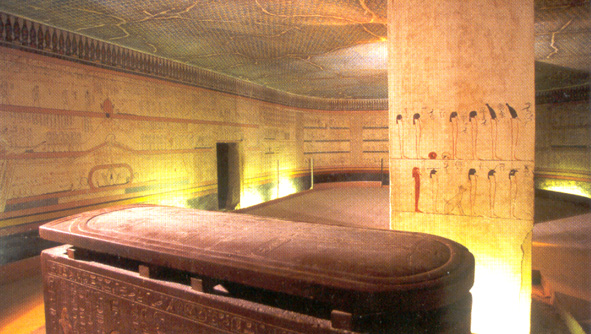
Burialchamber of
the tomb of Pharaoh Tuthmosis III - ca. 1426 BCE.
On the walls, the Twelve Hours of the Book of the Hidden Chamber.
Royal kingship reverted to Pharaoh Tuthmosis III (ca. 1479 - 1426 BCE) alone
sometime in the 20th or 21th year of queen Hatshepsut's reign (ca. 1479 - 1458
BCE). Now he wanted to establish his reputation, both for himself and for Egypt.
He did not dishonour the monuments of Hatchepsut until the last year of his
reign, and his monuments are extremely difficult to distinguish from those of
the "great royal wife" ... He established Egyptian dominance in Palestine and
southern Syria. He was active at the farthest southern point in Nubia and
established numerous monuments.
The first known complete versions of the Litany of Re and the Amduat belong to this
period (ca. 1426 BCE). Only in the tomb of Pharaoh Tuthmosis III are the
directions regarding the orientation of the 12 hours, given in the text and
envisaged as an ideal rectangle, strictly implemented. His vizier Useramun
attempted to follow the royal example, but the wall surfaces of his tomb could
not accomodate this.
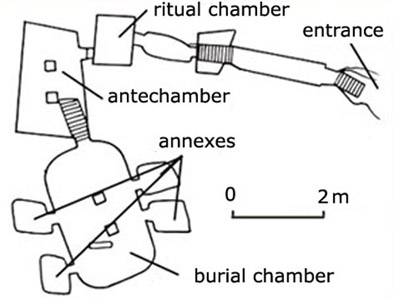
plan of the tomb of Pharaoh
Tuthmosis III
The orientation of the royal tomb has the entrance in the North, while the
burial-chamber deviates to the East, a tradition originating with the Middle
Kingdom pyramid of Sesostris II. As in the Old Kingdom subterranean tombs, this
complex path symbolized the regions of the hereafter, reflecting both Osirian
and Solar concerns. The tomb begins with a
stairway, a corridor, a second stairway and a second corridor before reaching
the ritual chamber. The ceiling of this chamber is painted with a blue sky and
yellow stars. After the ritual chamber, like most tombs of this period, there is
a 90° turn into the antechamber, which is then followed by the burial-chamber
with its four lateral annexes. While the passages are not decorated, other areas
were plastered and painted for the first time. The ritual body of the deceased
(the "sah") leaves the tomb in the other sense (Allen,
1988). The burial-chamber is the "duat", the netherworld. The antechamber is the
"horizon" of dawn and the ritual chamber and corridors are the stairway to the
northern circumpolars. The funerary ritual is sequenced : first the resurrection
of Osiris and then the ascension to Re.
The (upper) antechamber to the burial-chamber has two pillars, and is decorated
with the divinities of the Amduat, with the exception of the enemies of
Re. A
flight of stairs leads directly from there to the burial-chamber, which is oval
and also has two pillars. The cartouche-likel burial-chamber is common also to the tombs of
Pharaohs Thutmosis I and Thutmosis II.

Burialchamber of the tomb of
Pharaoh Amenhotep II - ca. 1400 BCE.
His son, Pharaoh Amenhotep II (ca. 1426 - 1400 BCE), would ignore the prescribed
distribution, initiating a sequential order. He placed the short version of the
Amduat at the end of the chamber. About this version, Hornung writes :
"Dieses Amduat-Exemplar ist das vollständigste von allen
erhaltenen und wird in der vorliegenden Edition in extenso gegeben."
(Hornung, 1963, p.XIV).
Pharaoh Tuthmosis IV (ca. 1400 - 1390 BCE)
left his burial-chamber empty and Pharaoh Amenhotep III (ca. 1390 - 1353 BCE)
again had the complete book decorate his burial-chamber.
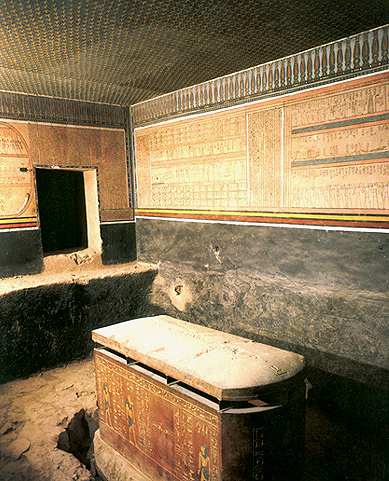
Burialchamber of the tomb of
Pharaoh Amenhotep II - ca. 1400 BCE.
on the left the end of the 12th Hour, and on the right the 1th Hour
the short version above and right of one of the entrances
After Akhenaten (ca. 1353 - 1336 BCE), the First Hour alone was represented in the
tombs of Tutankhamun (ca. 1333 - 1323 BCE) and Aya (ca. 1323 - 1319 BCE).
Horemheb (ca. 1319 - 1292 BCE) replaced it with the new Book of Gates as
did Pharaoh Ramesses I (ca. 1292 - 1290 BCE).
With Pharaoh Seti I (ca. 1290 - 1279 BCE), raised relief was extended all over
the royal tomb and the Amduat was used partly in the burial-chamber and
the rest in corridors and subsidiary chambers. Pharaoh Ramesses II (ca.
1279 - 1213 BCE) reserved for the short version of the Amduat a
subsidiary chamber of its own, and has two versions of the 12th Hour, of which
one is without parallel (in subsequent tombs, the short version was omitted).
From Pharaoh Merneptah (ca. 1213 - 1203 BCE) on, the Amduat was no longer
in the burial-chamber and down through Pharaoh Ramesses III (ca. 1186 - 1155
BCE), the 4th and 5th Hours had a permanent place in the third corridor, while
the place of the remaining hours varied. From the time of Pharaoh Ramesses III
until Pharaoh Ramesses IX (ca. 1127 - 1108 BCE), the only relatively complete
exemplar is found in the tomb of Ramesses VI (ca. 1143 - 1135 BCE), translated
by
Piankoff (1954). The hours are in sequential
order in the fourth and fifth corridors. The 7th through the 11th Hours are
abbreviated and the important 12th Hour is missing (these lacking parts were
perhaps represented on the lost tomb furniture). There are no New Kingdom papyri
containing the Amduat, and the first appear in the XXIth Dynasty (ca.
1075 - 945 BCE).
►
the Midnight Pharaohs
Assmann (2002, p.207) characterized the Egyptian
concept of the cosmos as "an indefinitely repeated
cosmogony", intimately linked with Re and the divine king. On the one
hand, the apparent motion of the former around the Earth, a journey by two
barks, one for day, another for night, called into being almost all the
important deities, and allowed for a complex delineation or speculative
interpretation of this circuit in terms of the origin of creation as well as its
frailty (order relapsing into the original chaos). On the other hand, Pharaoh
knew the scenic and constellational arrangements to be able to intervene in the
cosmic process effectively. He keeps the salvational (not redemptive) knowledge
present, renews and "keeps things going". Man interprets creation by investing
it with his own.
There is no supernatural, eschatological interpretation of life (as in
Judeo-Christianity), but a "natural science", a
"speculative identification" (p.211), a worship of
the effective powers of the cosmos, mobilizing order within man. The cult of the
Sun playes a crucial role as an "interface" (p.208)
coupling Earth and sky, establishing a link between above and below (between
macrocosmos and microcosmos, as
Hermetism would have
it).
Note that this crucial distinction, between the supernatural-redemptive and the
natural-cosmotheist approach of being, is a clear-cut dividing-line separating
the religious speculations of Antiquity from Greek rationality and the later
monotheist religions. The longing to be liberated out of this world (Greek
thought), redeemed from it (Judeo-Christian thought), or changing it into
something radically different and better (eschatological thought) is absent in
Egyptian thought. Instead, incorporation into creation and the unending
reconciliation of the human and the divine are focused.
"Salvation is the overcoming of the forces of stasis and
dissolution. (...) The mystery of solar rebirth is in fact the central
salvational element in Egyptian religion. Whereas the Greeks were fascinated by
the harmony of the whole, the Egyptians fixed their attention upon the process
of ongoing vindication and rebirth. To them the cosmos appears as the
quintessence of the death-defying fullness of life, as well a chaos-banishing
force of order." -
Assmann,
2002, p.209.
These cosmotheist speculations were at work in Egyptian civilization from the
start, but acquired fullness in stages :
Old Kingdom : Pharaoh knows
the mysterious speech enabling him to address the constellational, collective
pantheon of divine roles. This is a fraternity of the deities overarched by Re.
All the deities participate in the Solar circuit. The importance of Osiris is
acknowledged, but the Pharaohic ideal is Solar ;
Middle Kingdom : The
justified, and "Osiris NN" has been taught the correct names (of deities and
gate-keepers) and knows the spells to pass the netherworld of Osiris safely and
thus reach the Field of Reeds. Darkness (Rosetau) and the
restoration of Osiris become fundamental. Osiris is the "night-Sun" and
resurrection (the healing of Osiris) is necessary before transfiguration
(becoming and Akh-spirit of Osiris) ;
New Kingdom : in the New Solar
Theology, the Solar circuit is the "life-giving deed of
the one and only sun god, performed anew each day" (Assmann, 2002,
p.212).
In the Amduat, the pantheon is redefined : the
concerted polytheism of the constellational pantheon (with unity before
creation), makes way for a proto-rational henotheism, in which one, unique
godhead is at work in nature : Re. All the deities (as well as the enemies of Re) are
circumambulating the "Ba of Re", who navigates the Solar Bark. As a function
of the major transformational states gone through by this greatest of souls, the
"Ba of Re", represented by a man with the head of a ram, is standing alone in
the cabin, or surrounded by the Mehen-serpent, or crowned with or without Solar
Disk, or missing ... The aloneness of Re is underlined, but not against
the other deities. The latter are functional differentiations of the
subprocesses sustaining the grand circuit of the Sun, the visible presence of
the One ; the main differential of ongoing depletion and renewal.
The Midnight Pharaohs, namely Tuthmosis III, Amenhotep II & III,
decorating the walls around their sarcophagus with the Amduat, envisaged
a closeness to the "Ba of Re", an enduring presence on the "Bark of Millions of
Years", and were convinced the Amduat, as a unity of picture and text,
would provide this. Indeed, on his bark, Re is never without company and at no
times is the Bark of Re without retinue. Pharaoh wished to be with his father
and participate in the mystery of Re's rejuvenation, the great secret of the
hidden chamber. Pharaoh was no longer (as in the Old Kingdom), the guarantee of
order in creation, only Re was. But as the king, being the son of Re, existed
near Re, those guided by the king were safe.
In the tomb of Pharaoh Tuthmosis III, references to the the king are numerous
and inserted into the text. This tomb has a unique catalogue of Amduat
deities. The last hour lies precisely in the East, and the entrance to the
sarcophagus chamber parallels the realm of Sokar.
Our "main text" of the Amduat follows the complete extant
directional version of Pharaoh Tuthmosis III (Bucher,
1932).
2
The Ars Obscura of the Midnight Mystery ...
In Egyptian spirituality, the "hidden
light" of the secret of darkness, fundamental to human spirituality
since the Upper Palaeolithic, is an autoregenerative, divine power
from before and after creation, eternal through endless
repetition. Its numen præsens shines
in the dark of the deep Nile, in the blackness of the sacred lake, in the closed temple naos, in the
hidden, remote tomb and sarcophagus, representing the sky-goddess Nut, in
our dreams and dreamless sleep and
in the pit of the night of the hidden chamber, Re entering Nut's mouth
at dusk and leaving her vulva at dawn ... In all these manifestations
of the mystery of darkness, the obscure is approached in an artistic
way. But besides beauty, procedure speaks.
At the 6th Hour of the Amduat, the journey of Re in his Solar
Bark arrives at the place of the Midnight Mystery. This mystery of
mysteries involves a movement to and fro : from creation
(differentiation, loss of focus) to
pre-existence and from the latter to a renewed creation
(integration, the all-encompassing horizon of horizons). Re sustains
the order of creation even if this means loss of energy and low
returns. He differentiates his energy by bestowal and in accordance
with Maat (Amduat, Hours 2 - 5). Eventually, at the point of
the midnight Sun of death, Re's "voice" makes his Ba enter the mummy
of Osiris, forming one living spiritualized body (6th Hour). The
mysterious image of the Duat, Tail-in-Mouth, represents the uterus,
matrix or vessel in which the supreme, conjunctive moment unfolds.

"(By) this voice of Re comes, that the images
who are in him advance."
Amduat,
6th Hour - text of Tail-in-Mouth scene.
This single and unique singularity between Osiris
(the being of consciousness) and Re (the awareness of being) enables the
autogenic transcendence of Re's Akh-spirit, Atum and his Ennead, to become
effective in creation and the netherworldly pantheon. Indeed, at the same moment,
Osiris realizes (is momentarily aware of) his own ground (as "body" or "flesh" of Re) and their
singularity makes way again for the division between Re (awareness
without being) and Osiris (being without awareness). As "king of the
Duat", Osiris remembers his refound spiritual sense and
sustains Re's integration before dawn, but is left behind in the Duat. The deities themselves are all
renewed by the merge. Re, dawning as a child, integrates all of
creation in his energy, clothes nature with the gifts of the grand
encounter (Hours 8 - 12). He is sure of a glorious return (until noon)
and powerful enough to defeat his enemies.
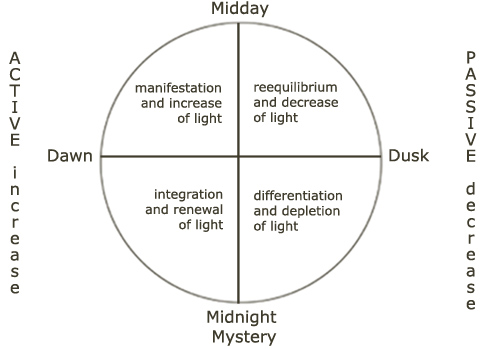
the cycle of Re in the
New Kingdom Solar theology
This netherworldly process is also Pharaonic, for the divine king rejuvenates in the
same way. As the foremost Akh of the Akhs of the ancestors, Pharaoh is
immanent, and represents the tradition of those who have realized the
mysterious singularity while part of creation. The Akhs of the deities,
in the heavens of Osiris or Atum-Re,
never incarnate. The Midnight Mystery involves the replenishment of
Re's efficient consciousness (Ba), not of his spirit (on the contrary,
for the latter is the autogenic, precreational and ultimate cause of rejuvenation).
The Egyptian mysteries, in harmony with Predynastic, Neolithic and
Upper Palaeolithic spirituality, always involved a "regressus ad uterum"
(Assmann,
1989, p.139). By returning to the place of conception, the
all-encompassing nature of the great goddess is called in. She is the
matrix of life itself and takes care for it all. Her contribution is
represented by the mummified Osiris, the fact of the divine nature of
material substrates and ritual vehicles of consciousness (in other
words, the power of thought-forms). The path leading to
the singularity is the vaginal tube, the narrow passage-way before
entering the rock-cathedral of the new conception hidden in the
deepest darkness. Re (the soul) enters Osiris (the body). When Re
autogenerates, Osiris becomes aware and both depart.
Each time, Nile, temple, tomb, sleep and the "mysterious image" offer a "coincidentio oppositorum" (Nicolas of Cusa,
Jung), i.e. access to crucial eternal instants outside the phenomenal cycle
of nature. These sacred, timeless moments of neheh-time are themselves
submerged in
everlastingness (Nun and djedet-time). They belong to the potential of Atum-Re,
to eternity-in-everlastingness and his capacity to autocreate
(cf. Section 2). This singular
conjunction is pivotal
to the living order as a whole, and sustains its cyclic movements of dawn,
upper culmination (zenith), dusk and lower culmination (nadir). Thanks
to the conjunction of
a ritualized body with a materialized spirit, taking place in a
mysterious, ancestral "oval", "womb" or "matrix", magic becomes
possible : the immanent rejuvenated by the transcendent, the infinite
caught by the finite (cf. Kierkegaard on the "absurd leap" of
religion).
In Jungian terms, the Midnight Mystery involves the individuation of
consciousness beyond the personal unconscious. The archetypes are faced.
The first are a pair, a bi-polarity (Re versus Osiris) leading up to a self-creative unity
(Atum).
In Ancient Egyptian spirituality, the "animus"-like Solar religion,
unites with the "anima" of Osirian, Lunar faith. The
materialized spirit (or Ba) enters the spiritualized body (or Sah). At the end of the
daily cycle, the Ba of Re, as the operational side of his creative conscious awareness,
is depleted but remains, in the first hours of the Duat, radiant.
Osiris, the rule of the passive but
restored and everlasting "king of the dead", exists in the eternity of the Duat,
and is rooted in the everlasting Nun. The Pillar of Stability is his,
but there is no awareness (he never leaves the Duat). The movement from light to darkness (the netherworldy voyage of
Re's Ba starting at dusk) is finalized as a movement from darkness to light (at
dawn). The cycle remains "eternal" if and only if the midnight
singularity is realized. This is the realization of one entity :
the "Ba of Re" and the "corpse of Osiris" : total activity and
completed
passivity instantaneously merging. After this, the dual archetypes split
(as Atum splits in Shu and Tefnut) and both Osiris and Re are rewarded : Re's
Ba has, as it were, autogenetically "recharged his batteries" for another day of
activity (of which the first 6 are nocturnal), and Osiris travels with
Re till the end of the 12th Hour, remaining in darkness to await the
return of Re, his soul, and the occassion to be aware of his
own divine nature.
In some mysterious way, this midnight conjunction taps into the infinite power-base
outside the natural order. It involves
the deepest layer of the Egyptian concept of reality, the everlasting
primordial ocean (Nun) and its autogenetic capacities (the Ba of Nun). This
ultimate layer lies outside the sphere
of creation, and is described in the Heliopolitan myths as Atum hatching
himself by himself in Nun, the inert waters in which Atum floats.
Nun is everything outside what is deemed necessary for creation and order.
Nun and absolute chaos, isotropic (in all directions) and homogeneous
(uniform), are identical. Nun is inimical to life itself and dissolves
everything. But, uniting with Osiris, his corpse, the Ba of Re is
rekindled by Atum, the Ba of Nun, and so the end
becomes a new beginning.
In Egyptian thought, the magical barrier lies between creation
(existence) and pre-creation (pre-existence). Pharaoh is the only one
able to cross it. He is the
great magician who knows how to step
outside the natural order and return to it. Pharaoh is the foremost of
the divine spirits existing in the light of the stars (the summum
of creation). In creation, he is the sole witness of witnesses, the
archetype of a perfect godman, an individuated consciousness. In the
Old Kingdom, he alone had a Ba, an operative conscious awareness.
Although Pharaoh knows how to transcend the universe, he represents an
immanence. Just as Osiris never leaves the netherworld, Pharaoh never
leaves the world.
Pre-creation features three dimensions and a double opposition,
namely
between, on the one hand, undifferentiation and creation (or Nun), and, on the
other hand, between potential and actuality (or Atum, the Ba of Nun).
-
Atum as potential (or Ba)
of Nun :
the sheer capacity to autogenerate hidden in chaos ;
-
Atum as actuality (or Akh)
:
Atum, Ba of Nun, creating in the "zep tepi"
: himself and the Ennead (completed by Horus, Pharaoh) ;
-
Nun : the
undifferentiated waters, ogdoadic, inimical to life and everlasting.
When the Ba
of Re enters the corpse of Osiris, Re's power is rejuvenated, while Osiris
simultaneously
experiences his own soul, i.e. awareness of himself as divine "ground of being". Thanks to Osiris
and the everlastingness of
his spine, Re, the light or awareness of consciousness, reveals the
autogenic root-cause of consciousness to consciousness. The soul of Re animates a mummified (ritualized, Osirified) form
to "exist" with Atum and the Ennead (in the sky and
its eternal beginning). The Ba of Re does not merge with
the everlastingness of darkness and the lack of differentiation per se
(Nun), but with its autogenic potential, i.e. with another Ba. Indeed, this singular moment (or point) steps outside creation, and exists as
the
eternal repetition of the self-created potential itself, i.e. exists
as an eternal cycle (wave) in the hidden treasure of the timeless
instant of eternity-in-everlastingness, the first time of myth.
A mummified corpse is a
"sacralized" state of matter, a material substrate or vehicle of
consciousness (a thought-form) gone through the process of "senetjer" and become a
"sah" or a "body of nobility". At the hour of midnight
of the dead Sun, this body of resurrection (Osiris), is transformed (cf. "xpr" or "kheper")
to house the soul ("Ba") travelling to its spirit ("Akh").
The mummified Osiris is the divine being of matter, for the
mummy becomes flesh at the point of his awareness of himself. Osiris has
no awareness of his own divine ground,
and needs Re to be aware of his own nature. Both deities are
rejuvenated, but Re is of tomorrow and Osiris is of yesterday. He
never leaves the night.
In the mysterious conjunction of Sun and Moon, the undifferentiated vastness of the primordial waters,
of everlasting homogeneity and
chaos, are not by-passed or circumvened. Neither does the Akh of Re seek
dissolution. Nun's fundamental nature (zero-ing) does not exclude
repetitive creation, cannot annihilate it own soul, cannot eliminate
the potential to create itself. Nun represents the ultimate
chaos surrounding creation. Atum is not "outside" Nun, but the
latter's efficient power of self-creation. Absolute absence of
differentiation is the natural state into
which order, were it not for Atum, the Ba of Nun, and the other Akhs, would relapse.
Nun should be
visualized as encompassing creation and the "zep tepi" in all
directions. This is precisely the state
of affairs banished by eternal repetition (initiated by Atum). This "zep
tepi" points (is initiated by) the ultimate potential of wholeness hidden in
ultimate chaos. Not created or generated by chaos, this potential
is autogenetic. The
potentiality of consciousness creates itself. Like Nun, Atum, the "Ba of
Nun", is outside the natural cycle of time and eternity
(pre-existent). Atum autogenitor exists
mysteriously hidden in Nun
before anything comes into being, before Atum, generating himself, split into Shu and Tefnut,
before spatial division and the moist.
The singular conjunction of the soul of Re (the operational side of
conscious awareness) with the
body of Osiris (the everlasting, divine "ground" or "stuff" of
consciousness) in the "oval" of ancestral knowledge (cf.
Tail-in-Mouth), makes the drop
represent the ocean. In doing so, Re's own original cause is touched
(Atum) and an eternal, luminous, one and differentiating divine
autogenic essence in everlastingness (eternity-in-everlastingness) is
made to add its surplus to reality and rejuvenate creation.
Without the Pharaohs, representing the tradition of those Akhs and noble
dead who have attained the singular conjunction of midnight, all would be lost and the darkness of chaos would
completely destroy creation, returning life to the everlastingness of Nun
and Atum, self-creating everything all over again ... The same can
be said of Osiris, but with this difference : Osiris resurrects in the
netherworld, in neheh-time. His is an Akh-spirit efficient in a glorified
body resting in the netherworld, not, like Pharaoh, an Akh at work on Earth
and ascending to the sky of Re.
Without Osiris, a "second death" is likely, for no divine intermediary
station would exist (between the Earth and the heavens).
Osiris
harbors
the night Sun. His netherworldly paradise, the Field of Reeds, is the best of eternity, while
Atum's bliss, eternal self-creation in sheer everlastingness, is harvested
by Pharaoh's experience of singularity.
Pharaoh is the kingdom of this-life, Osiris the eternal bounty of the
afterlife of the immortals on the Akh-plane of creation, the sky of Osiris. Atum is the highest, an
represents the self-creative nature of consciousness, containing itself in
everlastingness.
-
Akh-spirits of Re : exist in the first
time as eternal repetition in everlastingness : Atum, the Ennead and the
Pharaohs ;
-
Akh-spirits
of Osiris :
the blessed deceased and noble dead or spirits of Osiris in the
netherworld ;
-
Osiris as "king of
the netherworld" : an Akh-spirit embodied in a
divine "sah", providing "safe passage" to all justified deceased ;
-
Pharaoh as "king
of Egypt" : an Akh-spirit embodied in a divine
body on Earth, establishing enduring kingship, and so establishing Maat.
The effective nature of Pharaoh
lies in his stationary access to the midnight singularity. When
he dies, his tomb and
sarcophagus (later coffin) are his crucial spiritual tools to resurrect (Osiris) and
fly to Re. They are part of his
eternalizing perspective on the afterlife and reflect the singularity of
spirit and matter on a permanent basis (the interior of the lid of the
sarcophagus, as a simulacrum of the sky, was sacred to the sky-goddess
Nut).
"You are given the your mother Nut, in her identity of the coffin.
She has gathered You up, in her identity of the sarcophagus.
You are ascended to her, in her identity of the tomb.
Pyramid Texts, Utterance 364, § 616
d-f.
Moreover, in
Pharaoh, eternity-in-everlastingness (the supreme quality of Atum-Re, his
father) is incarnate while on Earth. He is a permanent fountain of rejuvenation,
regeneration, creation, recreation and ongoing equilibrating growth. He
guarantees a "good Nile" and lush green fields. This because he alone, as
supreme "Falcon", is the ultimate witness, and able, on a daily
basis, to sustain the process
to and fro the conjunction, the unity between the "Ba of Re"
and the "sah" (or mummy, i.e. a physical body empowered through
ritual) of Osiris. Re autogenerates and Osiris realizes that Re is his soul, allowing him to be aware of
his divine nature. This is why in the Amduat, Pharaoh only appears
in the 6th Hour.
The supernatural,
"magical" power of Pharaoh asks him to embody the dual kingdom and offer truth and justice (to his father, Re). In return, Atum-Re
grants his son all he needs ... and at the New Moon, repeated each midnight, a
new cycle begins.

Fertile
fields near Luxor.
Being totally in harmony with life
itself, Pharaoh constantly manifests the surplus produced by his divine momentum
to move from phenomena to their singular origin on
the Akh-plane of creation and from there to the eternity-in-everlastingness
(of Atum) outside the natural
cycle (in its beginning). When he returns within the boundaries of creation, Pharaoh,
like
the Ba of Re after midnight, self-creates
a stronger world, a more fruitful order, a more profound peace. Pharaoh
harvests the surplus of energy available outside the natural order and
collects it on the Akh-plane of creation, distributing it to its spirits.
The fact Pharaoh is able to constantly rejuvenate, makes the divine king
a stable, enduring, immortal & singular god-man, an eternal witness
able to stand still amid constant movement (as the falcon, able to fix his
head while his whole body moves).
|
![]()

